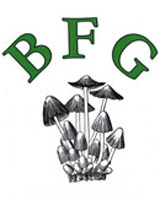Latin Masterlist Index
A B C D E F G H I J K L M N O P Q R S T U V W X Y Z
| D |
|

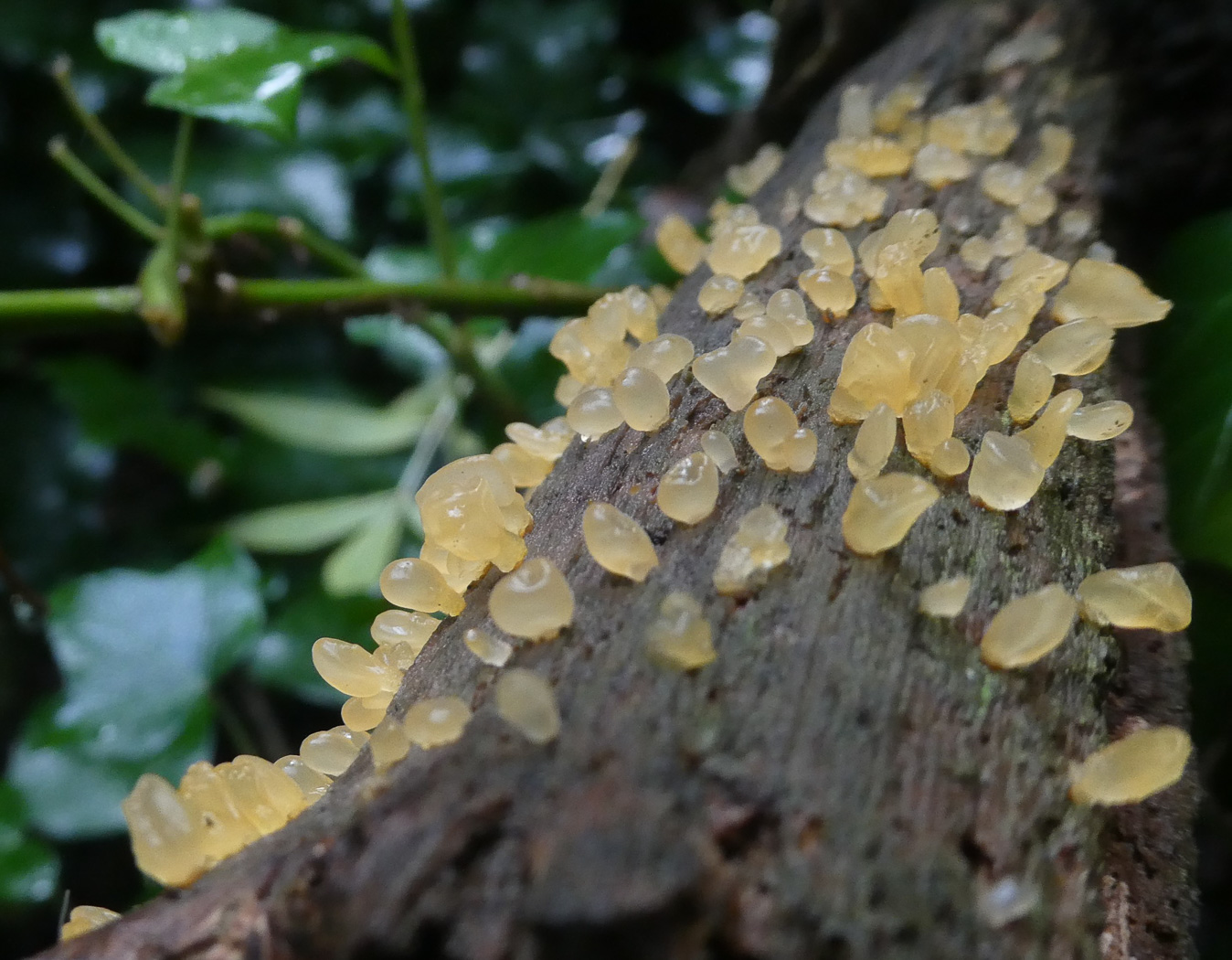 |
Dacrymyces capitatus (a species of Jelly Spot) Sep 10, 2022. On a fallen deciduous log in Chalfont St. Peter Jim Wills had been watching these small orange blobs for a few days to see if they developed into the quite similar Calocera pallidospathulata (Pale Stagshorn), but they stayed as seen in his photo - more like the bright orange blobs of Dacrymyces stillatus (Common Jelly Spot) though clearly paler and also with a very short stalk, looking a bit like a small Exidia species. Penny suggested it might be the much less frequently recorded D. capitatus and when Jim then checked the spore size - differing from those of D. stillatus, he was able to confirm the ID. Interestingly we found nice material of this species the same day at Ivinghoe Common as well, so it's one to look out for now. This is our first image for Finds. |

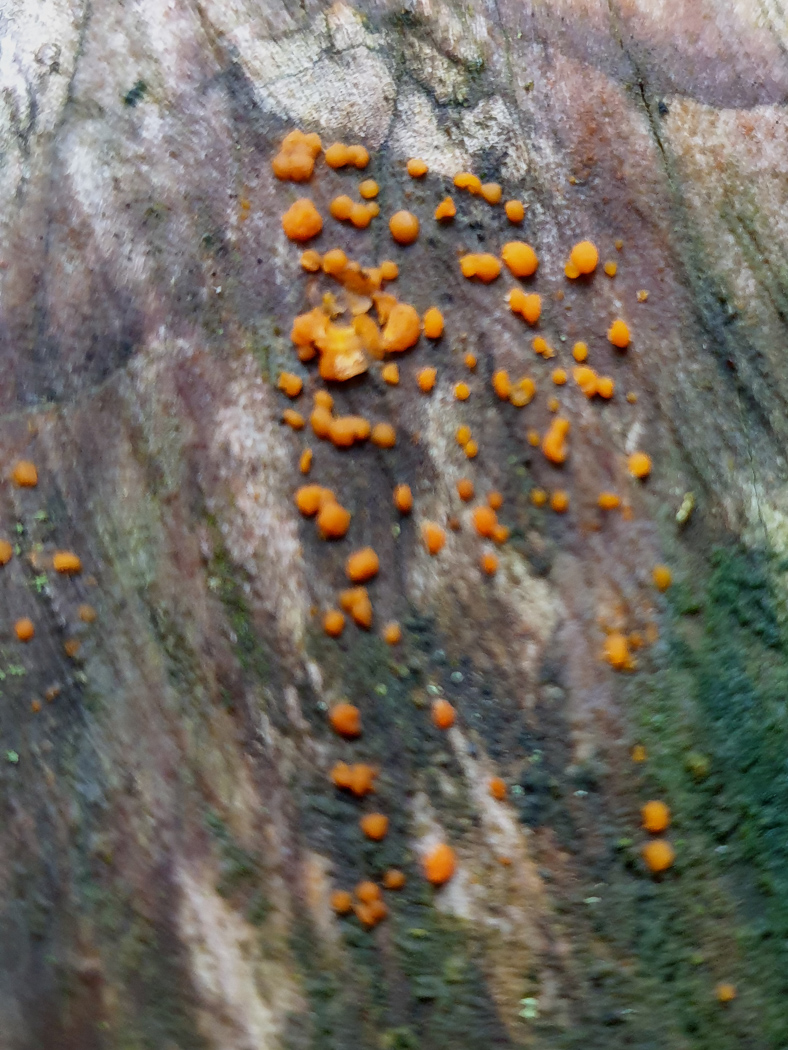
|
Dacrymyces stillatus (Jelly Spot) Nov 27, 2022. At Turville Heath Penny found a few spots of this very common dull orange jelly fungus on a bare deciduous log. It forms colonies of tiny roundish soft lumps on both conifer and deciduous woods, posts, wooden steps - any bare damp wood. Oct 11, 2020. Jackie McKenzie Dodds noticed these tiny orange blobs on bare wood in Penn Wood. This is a very common species of jelly fungus and despite having the word 'disc' in the common name it is not an Ascomycete. It occurs on any wood which is sufficiently rotting and damp: sawn timber as well as fallen bare wood. |


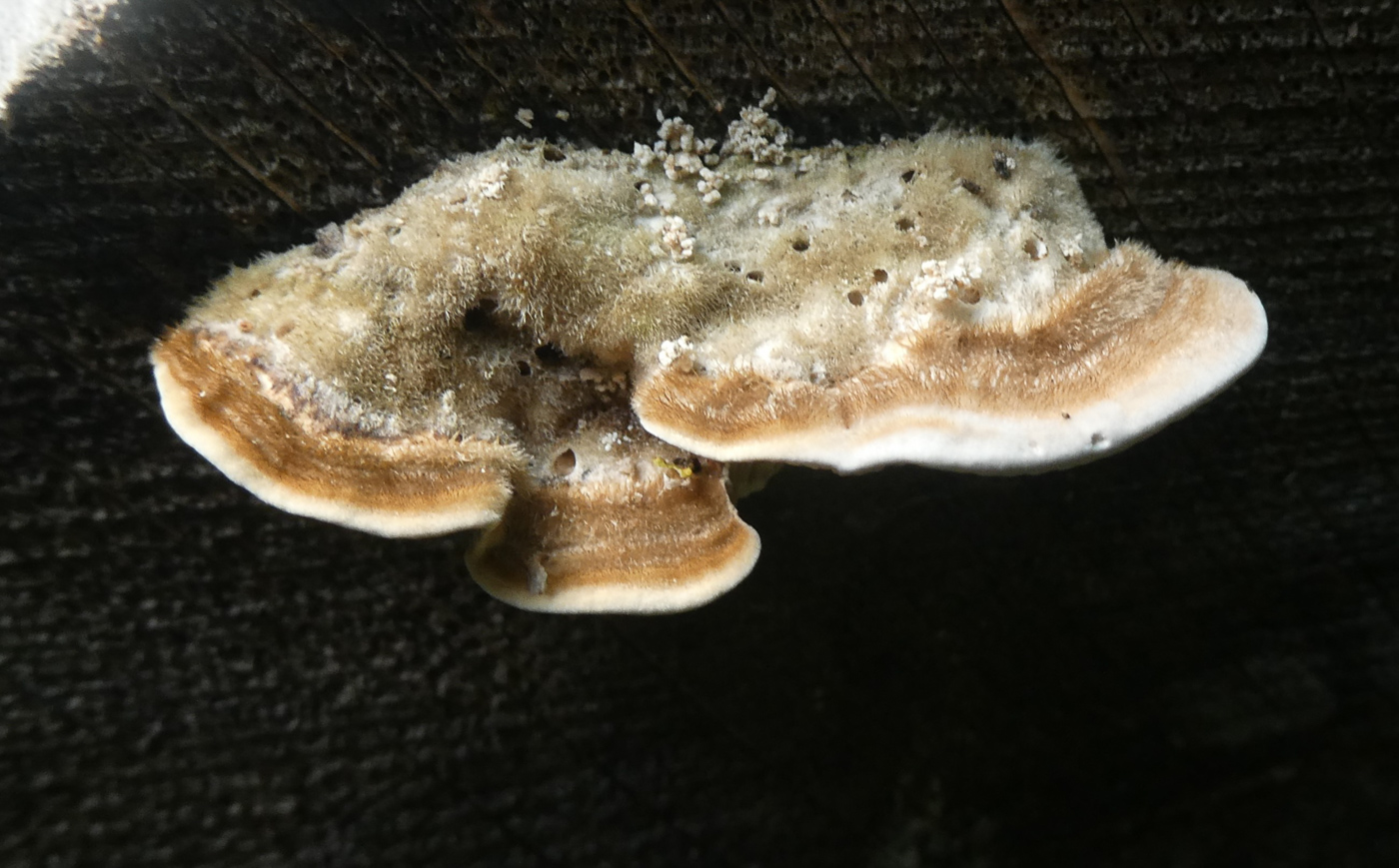
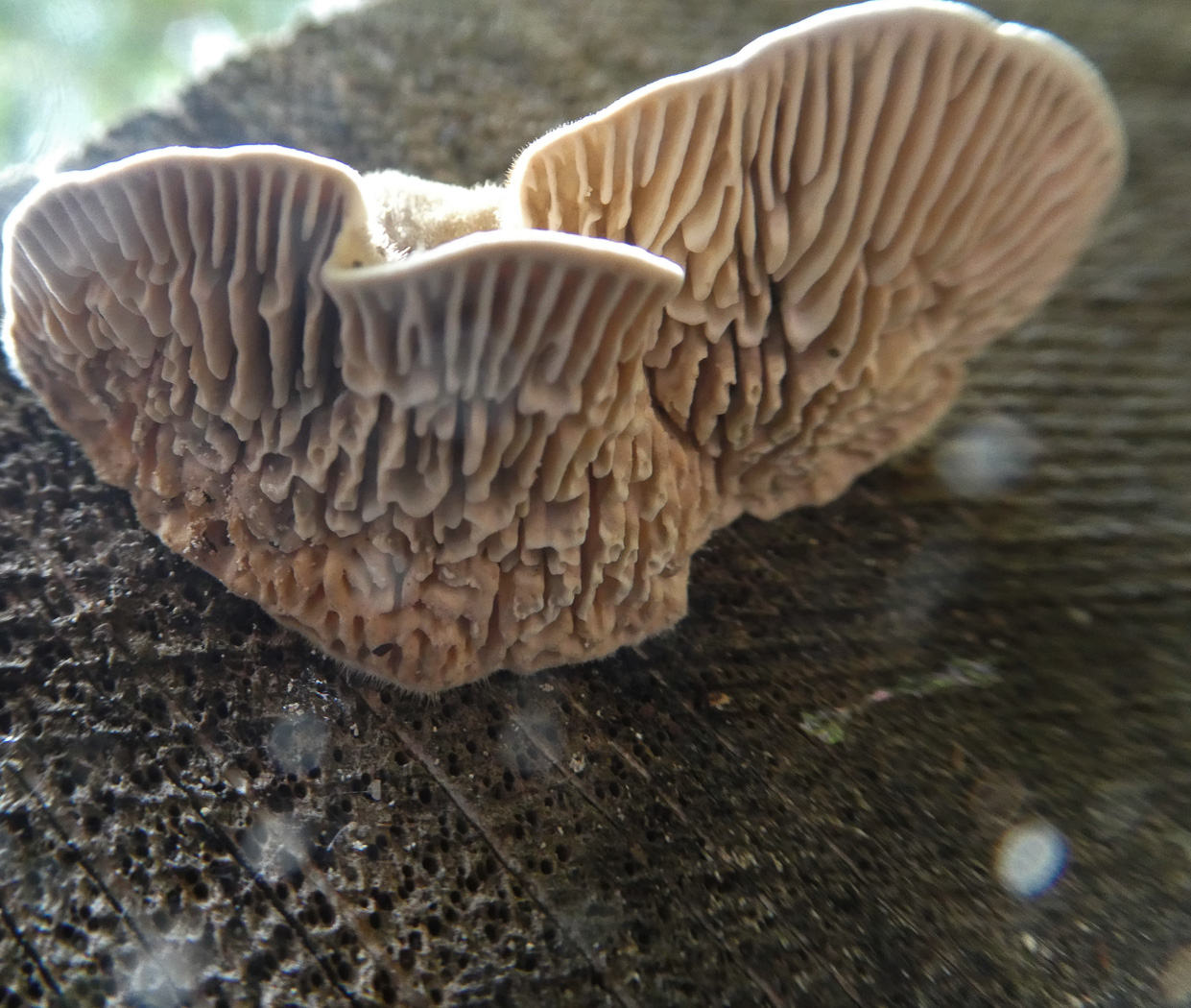
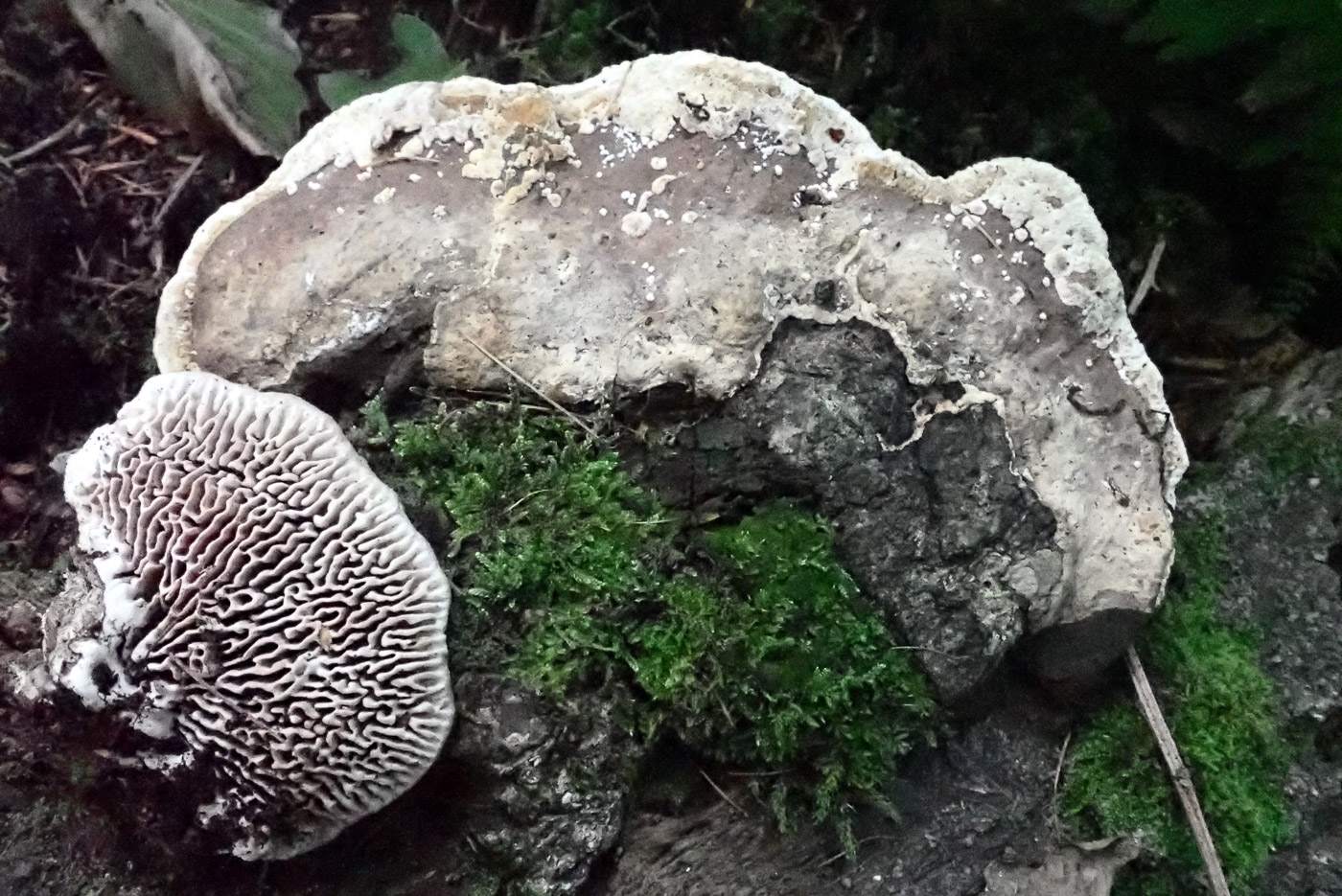
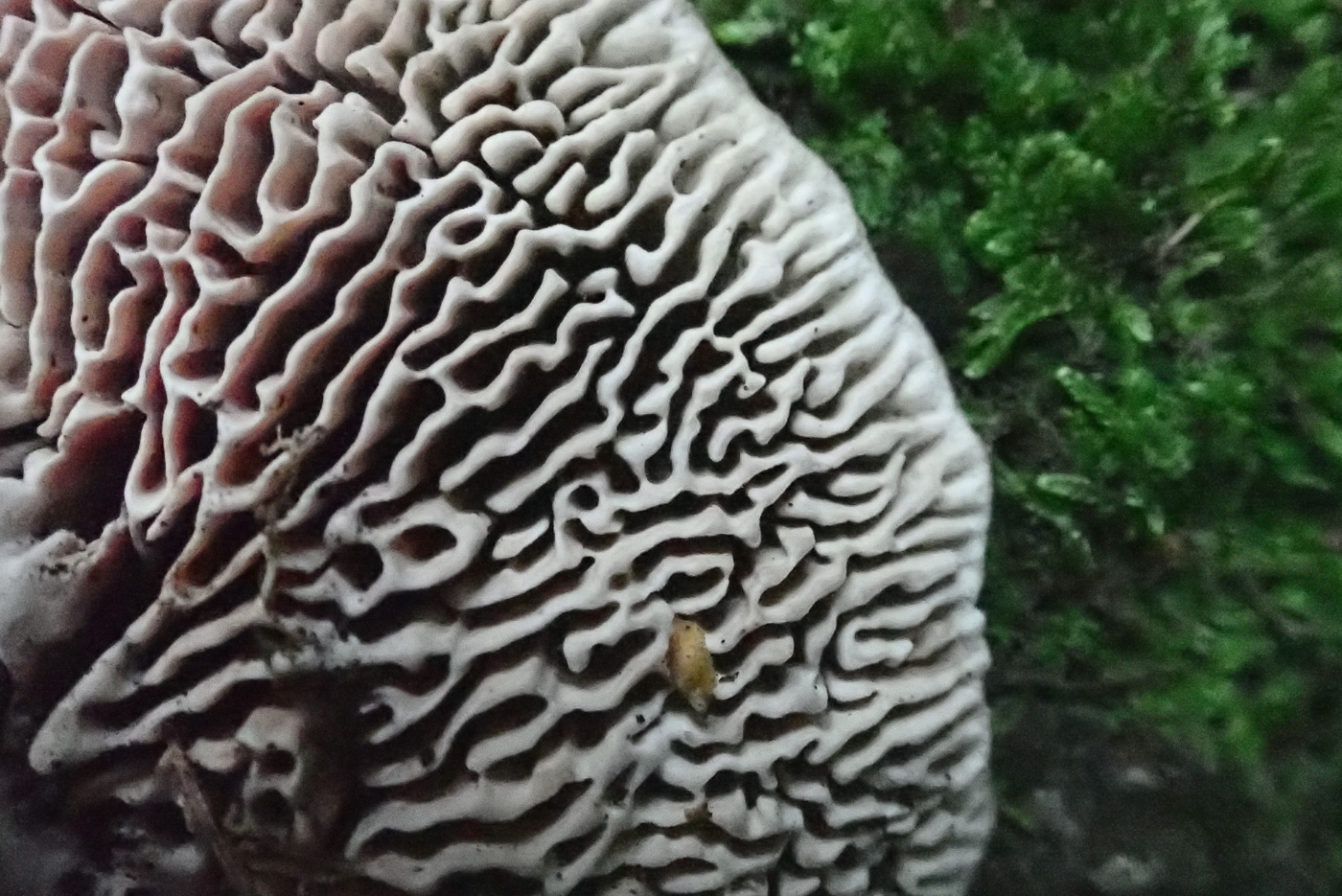 |
Daedalea quercina (Oak Mazegill) Oct 15, 2023. In Bernwood Forest Chris Grimbly found this nice example of quite a common bracket - one which occurs only on Oak which is abundant at this site. Here it is on a fallen mossy trunk but it is perhaps more frequently on live standing wood, often appearing in several places on the same tree. Both the Latin genus name and common name refer to the famous Greek myth of Daedalus who built a maze in which to entrap the monster man-eating Minotaur! We have two previous Finds entries: 2021 August 14th and 2022 September 15th. Sep 15, 2022. In Chalfont St Peter on a fallen log Jim Wills found this fresh bracket. Though the upper surface can be confused with other similar brackets, the deeply grooved pale mazelike undersurface is unmistakable. Jim also took the trouble to check the spores. The species occurs quite commonly on Oak and just occasionally on Sweet Chestnut. Aug 14, 2021. On an old Oak stump in Penn Wood Penny found this perennial bracket just freshly fruiting. The underside (seen in detail in photo 2) is more strongly mazelike than in any other species making it an easy one to recognise in the field. |




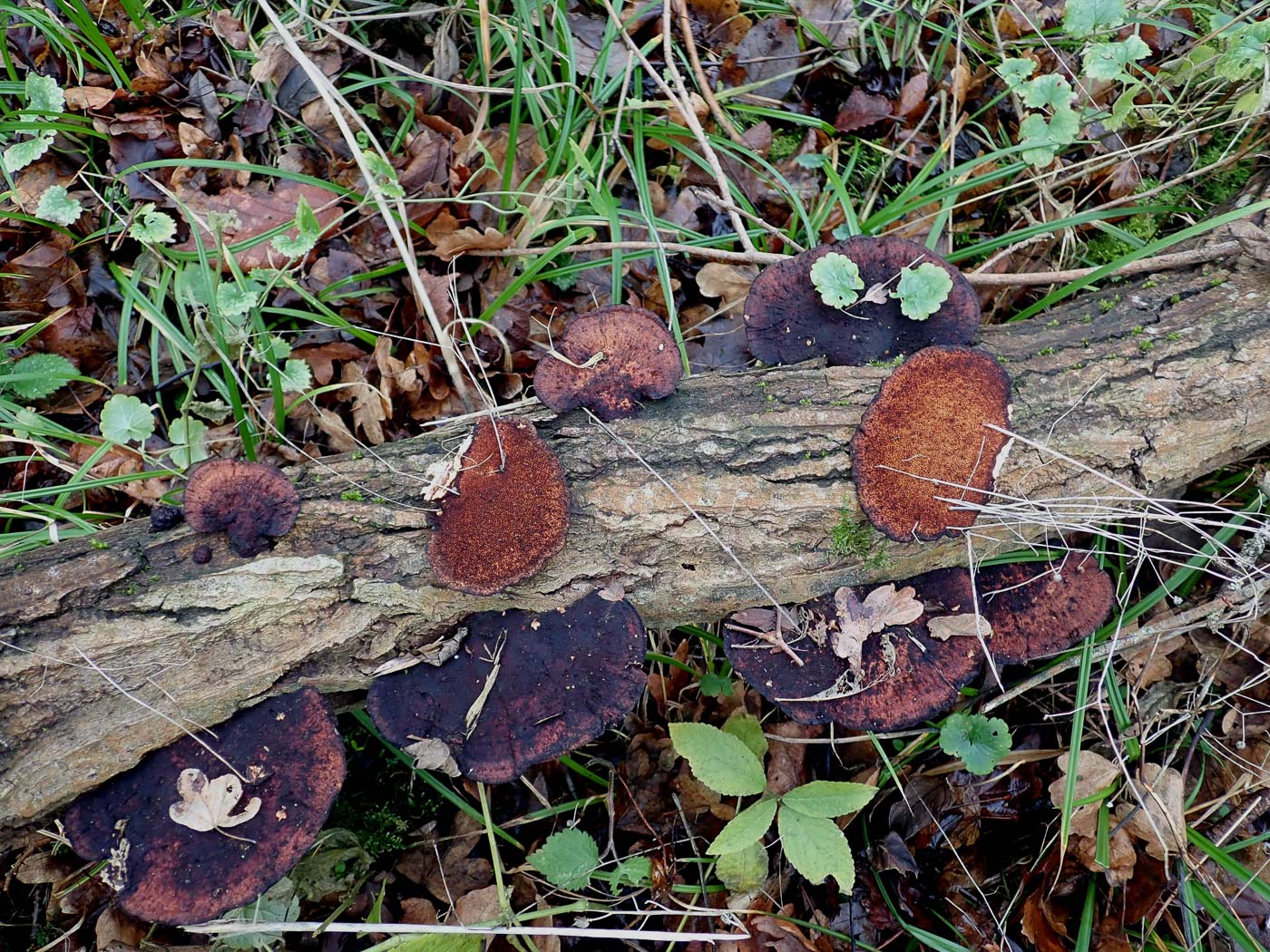
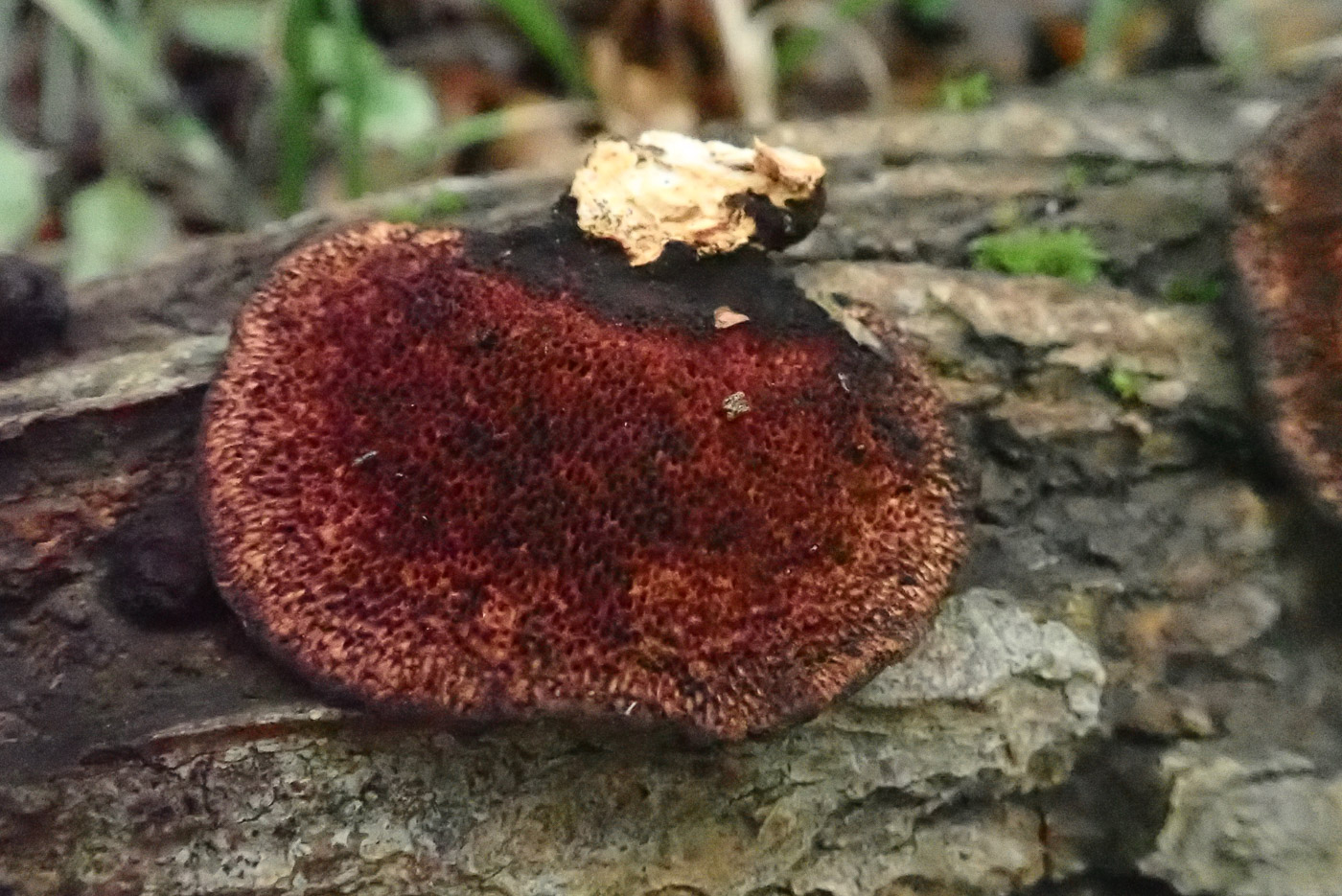

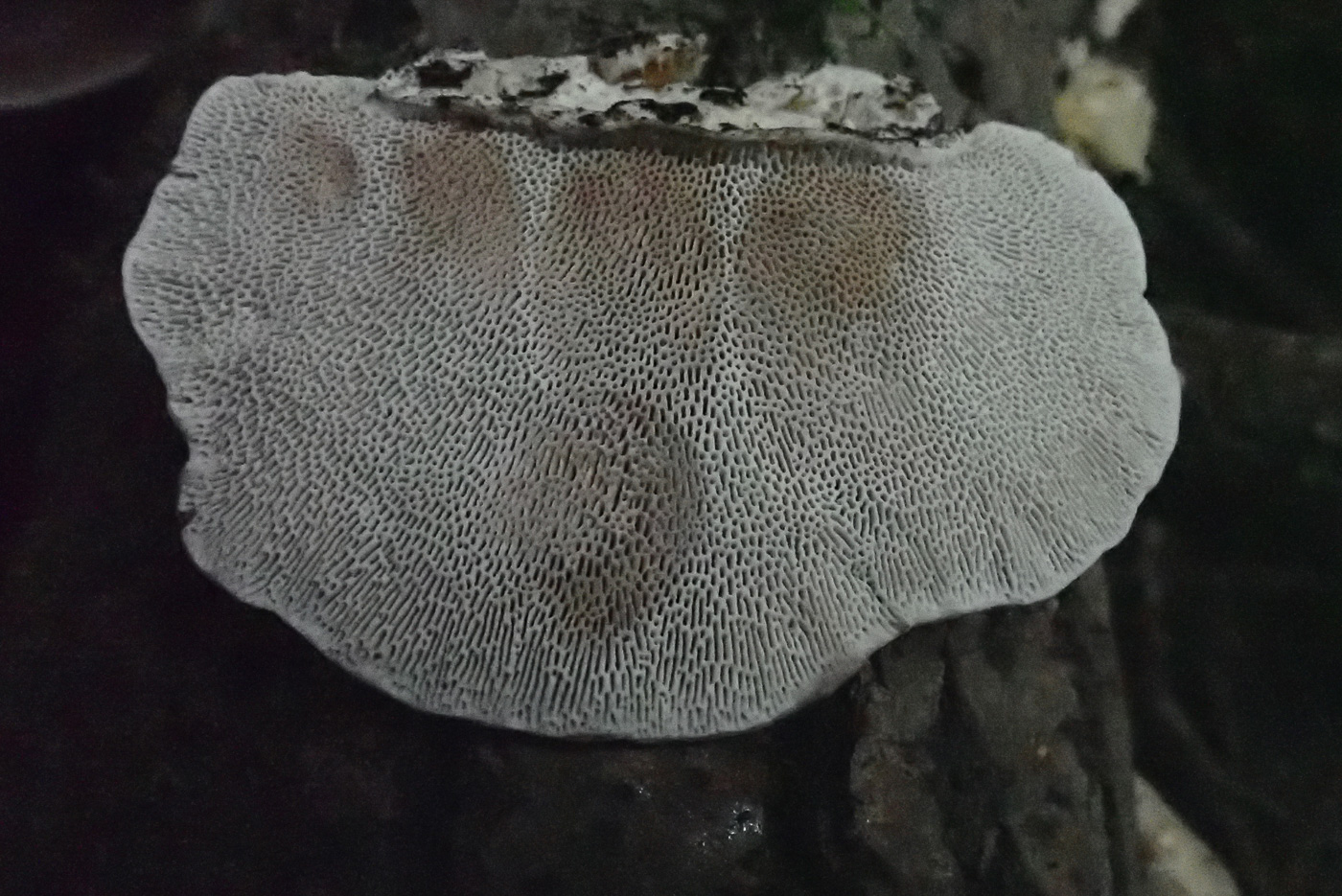
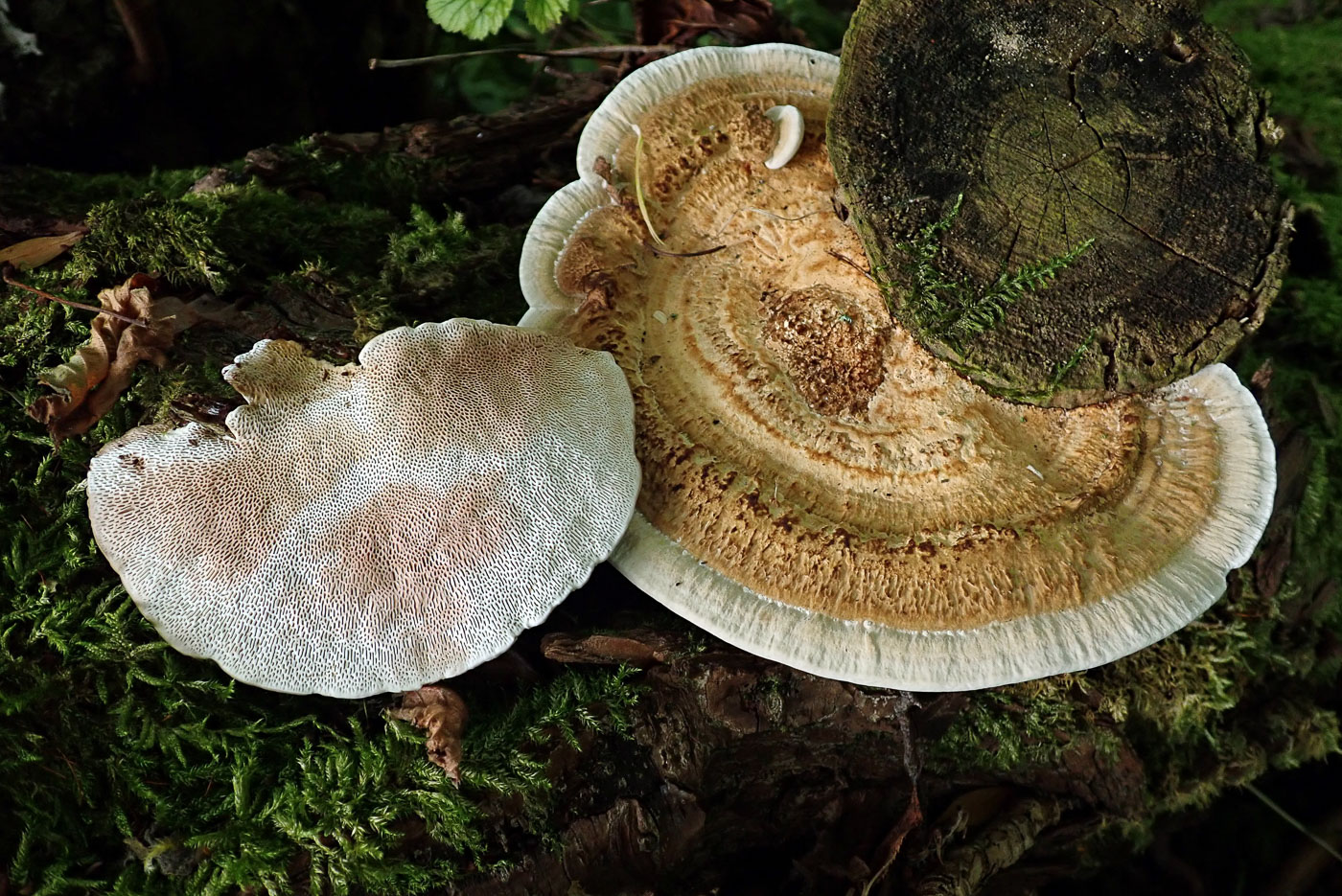
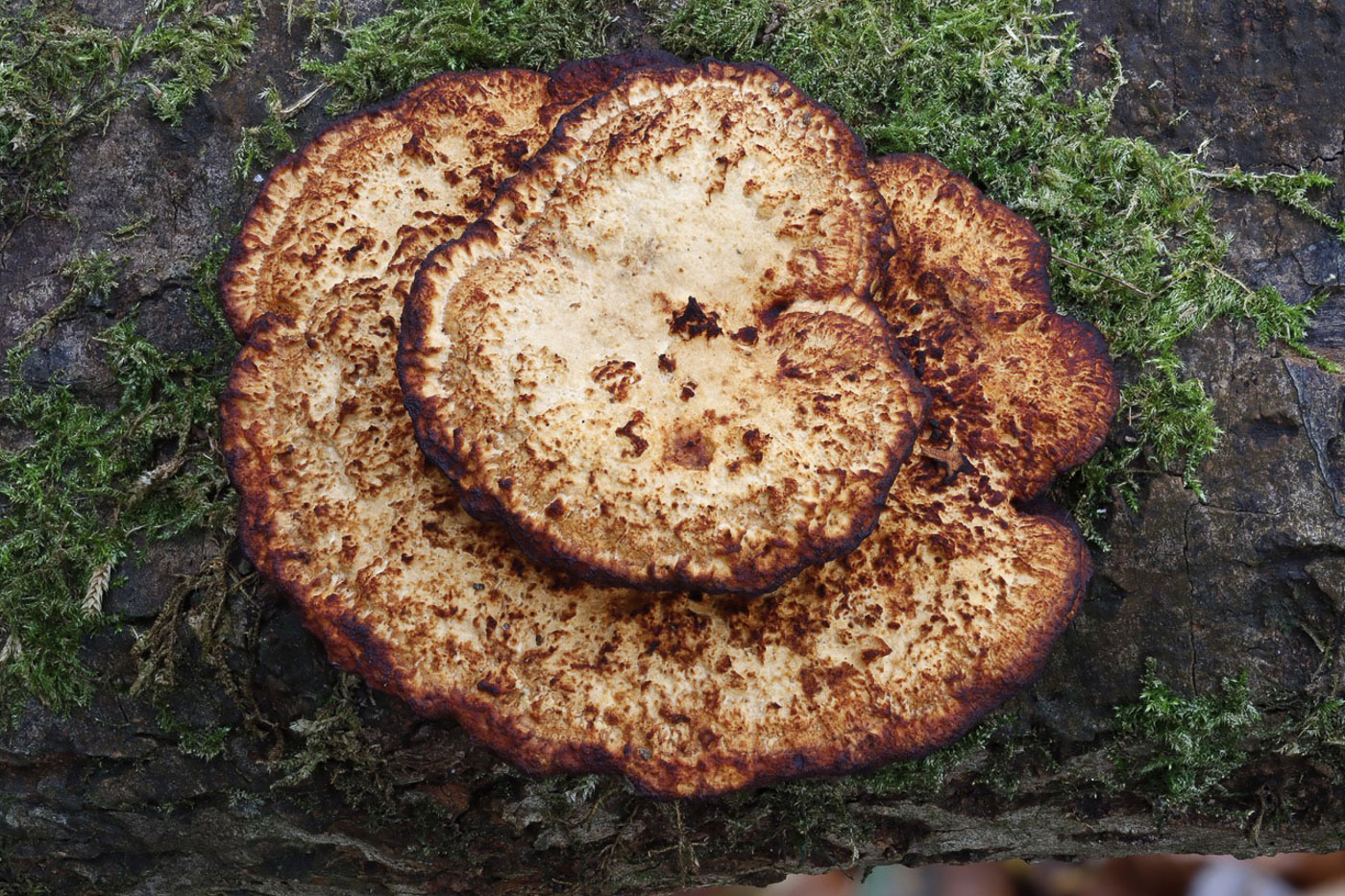
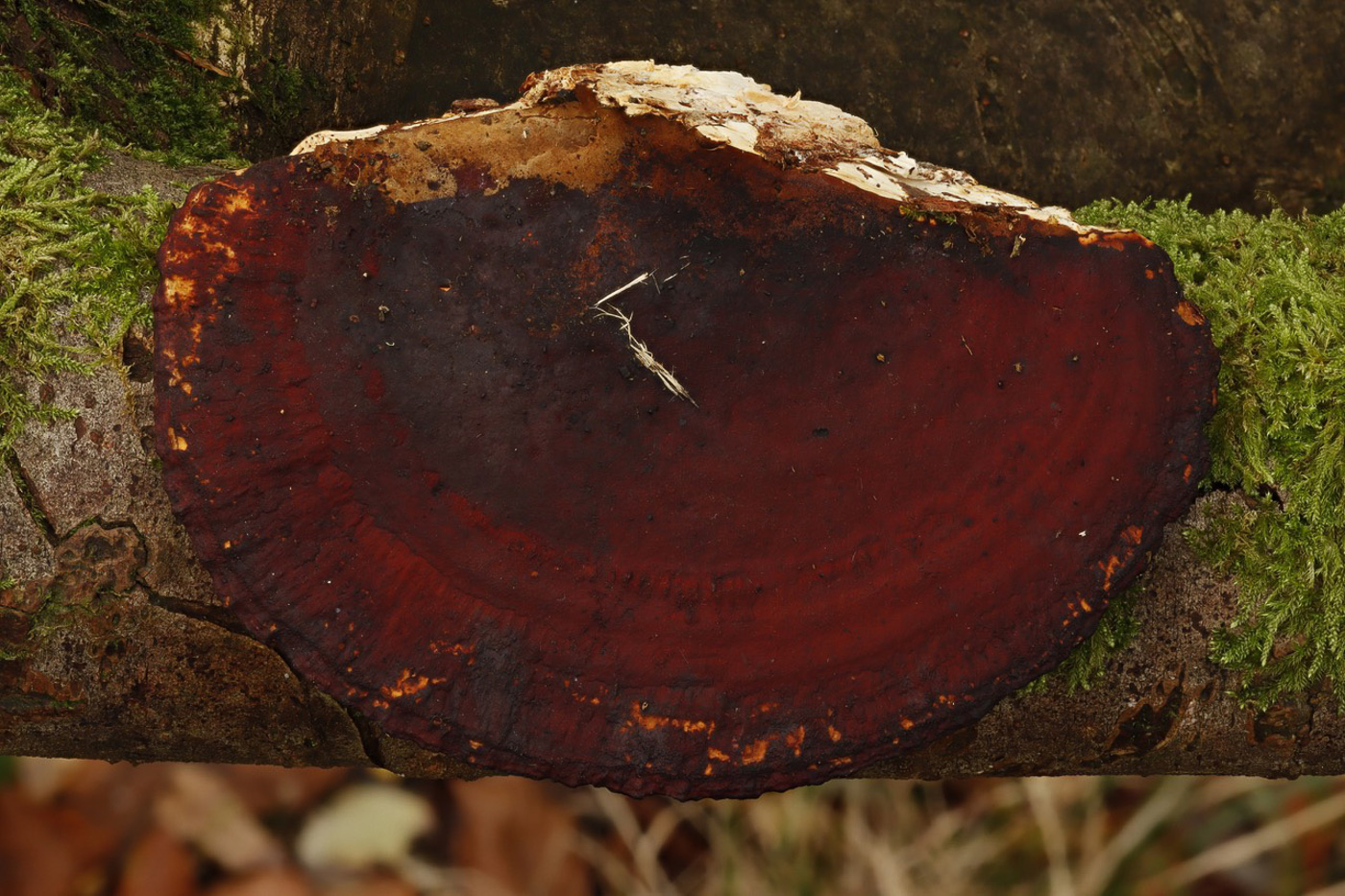
|
Daedaleopsis confragosa (Blushing Bracket) Aug 19, 2023. At Rushbeds on fallen deciduous wood Penny saw plenty of fresh specimens of this very common bracket - often on Birch or Willow. This is a hard semicircular bracket and easy to identify when the widely spaced pores are pale and moist enough for a thumb print (in this case both thumbs!) to turn instantly pink. Once dried and pale brown with no pink reaction the species can be harder to separate from others. Jul 23, 2023. Though last year's rather blackened fruitbodies of this very common species are still around at the moment, Jim Wills noticed this fresh specimen in Gerrards Cross Common on dead standing Ash. Though unusually pale above (photo 1 taken 2 days earlier) the typical radial markings towards the margin can be seen, and photo 2 shows the browner colour already developing. The fresh white labyrinthine pores showing Jim's thumbprint, now pink, are surely diagnostic. Jan 3, 2022. On fallen Willow in Rushbeds Wood Penny found good numbers of this very common species though none were fresh and all were turning dark reddish brown on top with hard dry pores underneath which don't 'blush' when pressed. When in this old dry state the species can confuse people but the red colour, half-moon shape and hard unblushing pores are typical. It is really common on fallen Birch and Willow. Sep 1, 2021. In a somewhat disappointingly dry Burnham Beeches Penny struggled to find much fresh material but this cluster of brackets on a sawn off Birch branch obliged. This is a very common bracket usually but not exclusively on fallen Birch or Willow, though it can confuse because though pale when fresh as here it turns much darker, often ending up deep red. It is often evenly semicircular (occasionally entirely circular) and the pores underneath (photo 2) are somewhat elongated tending towards mazelike. Pale when fresh and young, this is the stage when the pores 'blush' pink when pressed, clearly seen in photo 2, but when older and drier this trick no longer works and they are just brownish and unchanging. Nov 8, 2020. We have photos of young fresh specimens of this very common bracket (dated Sept 10) but older dried up specimens are far harder to identify and often confuse because they are well past the stage of blushing pink when the pores are pressed. Thus the inclusion here of Paul Goby's find, from Naphill Common on fallen Willow - a favourite host along with Birch. The species typically forms semicircular zoned brackets but can also form complete rosettes as in photo 1, and often can be found with red colours, even entirely red as in photo 2. The pores underneath (photo 3) are small and round and only blush pink when pressed if really fresh and still slightly flexible, but quite quickly become too dry and hard to do this. So don't assume just because the pores don't blush that you have a different species! Sep 10, 2020. These were nice fresh examples of a very common bracket fungus found by Penny Cullington on fallen Willow at Rushbeds Wood and show the diagnostic pink blush which quickly occurs on the maze-like pores underneath where it was handled. When older or dry this reaction is not visible. This species is most common on Birch and Willow but also occurs on other deciduous fallen wood. The zones of colour on the top surface often contain red - not in today's collection. |

 

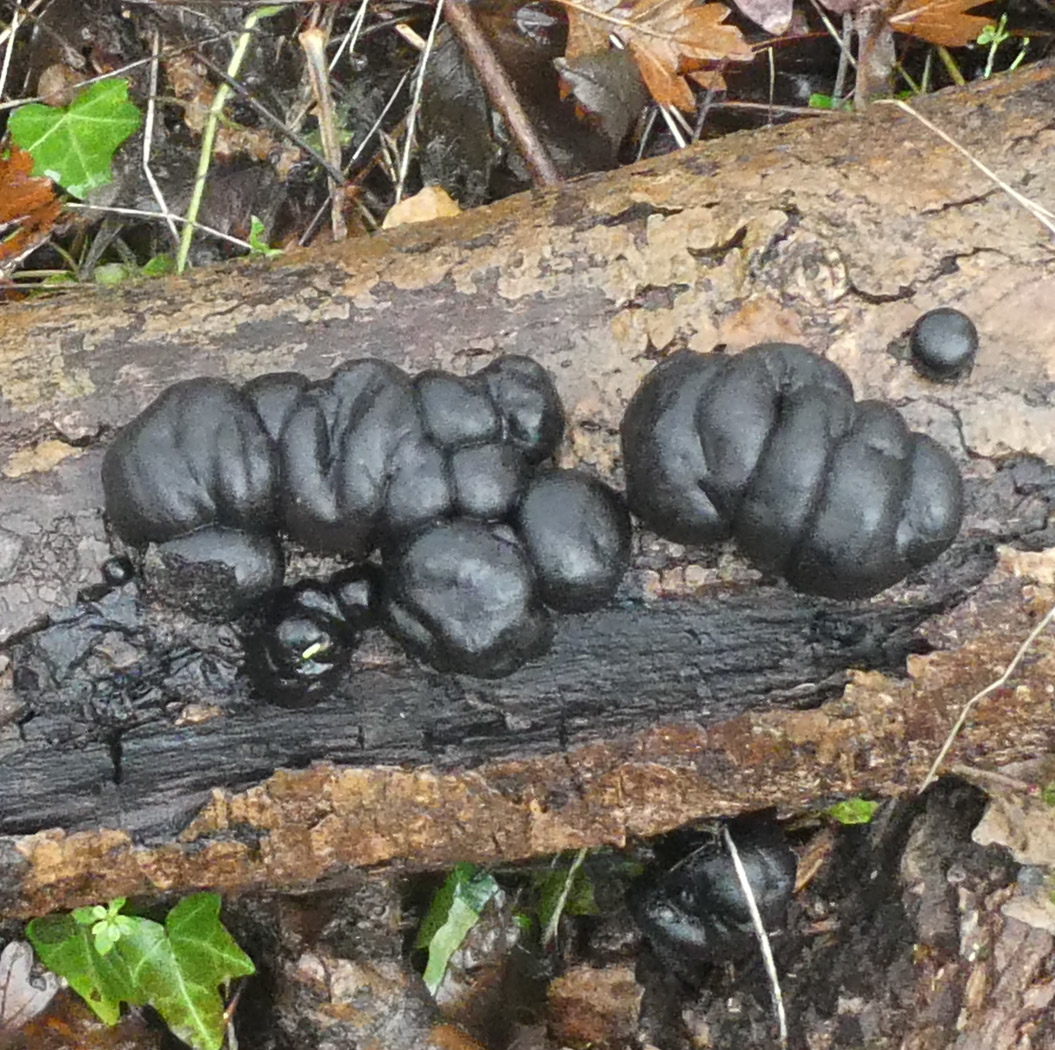
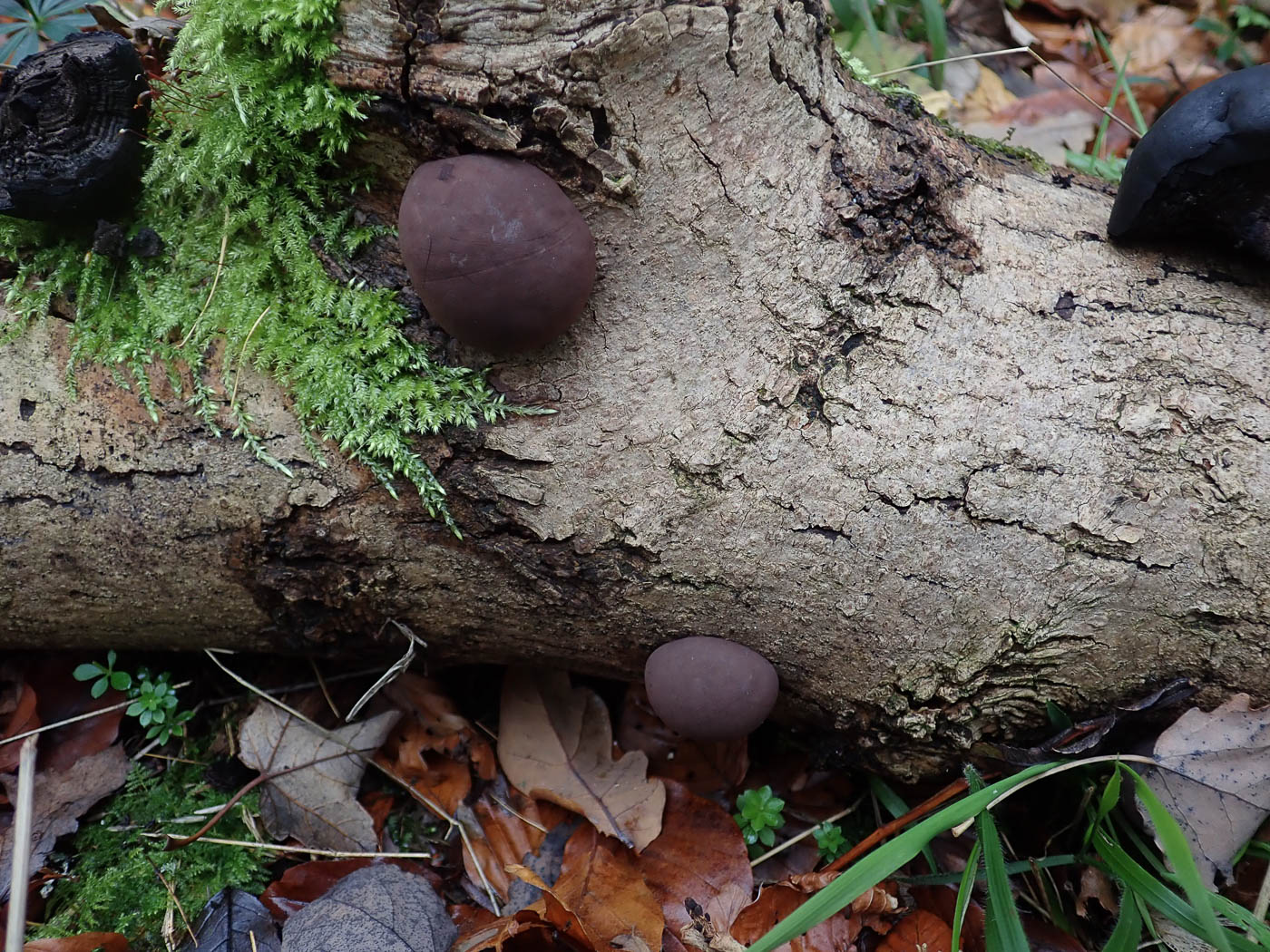

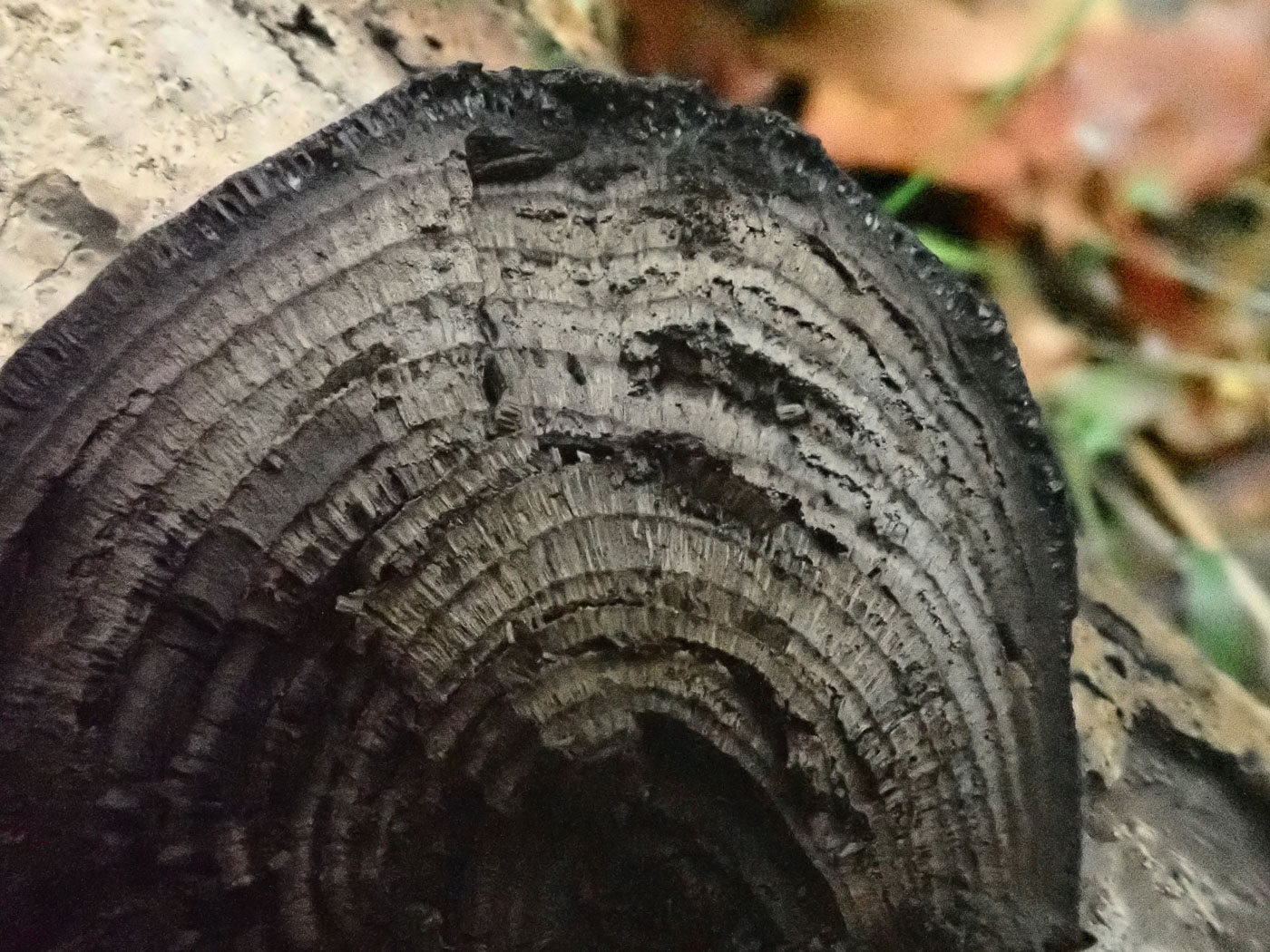
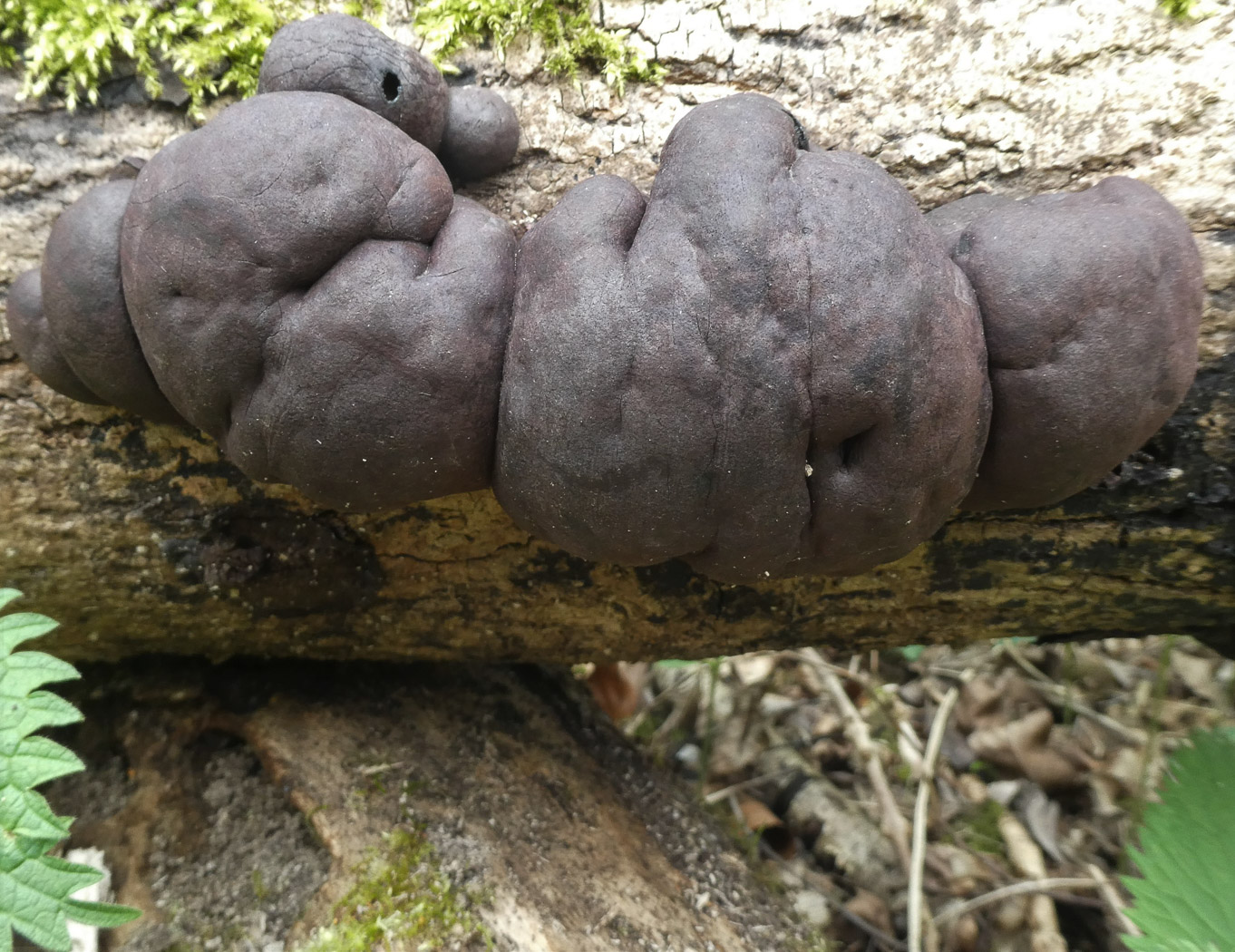
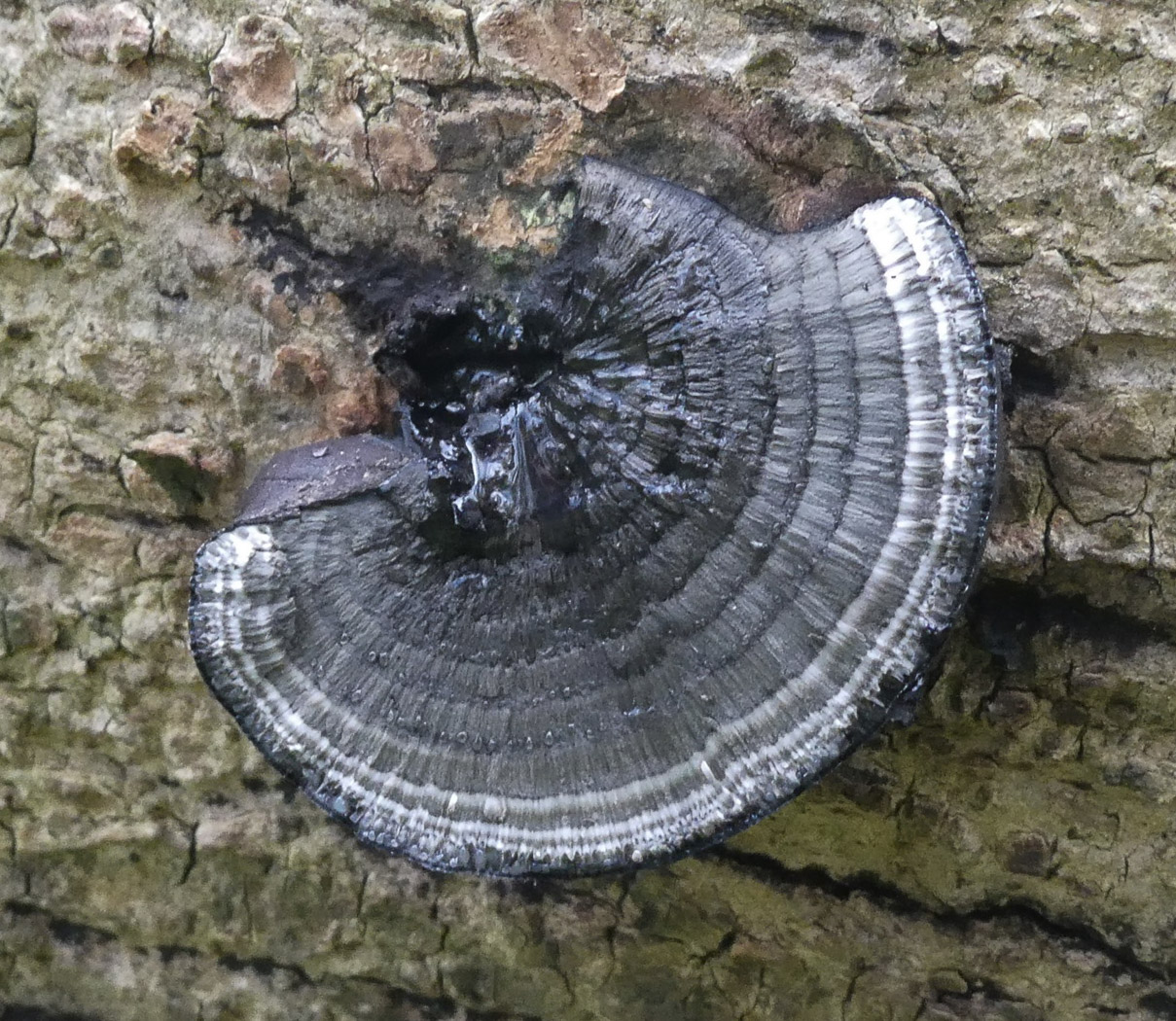
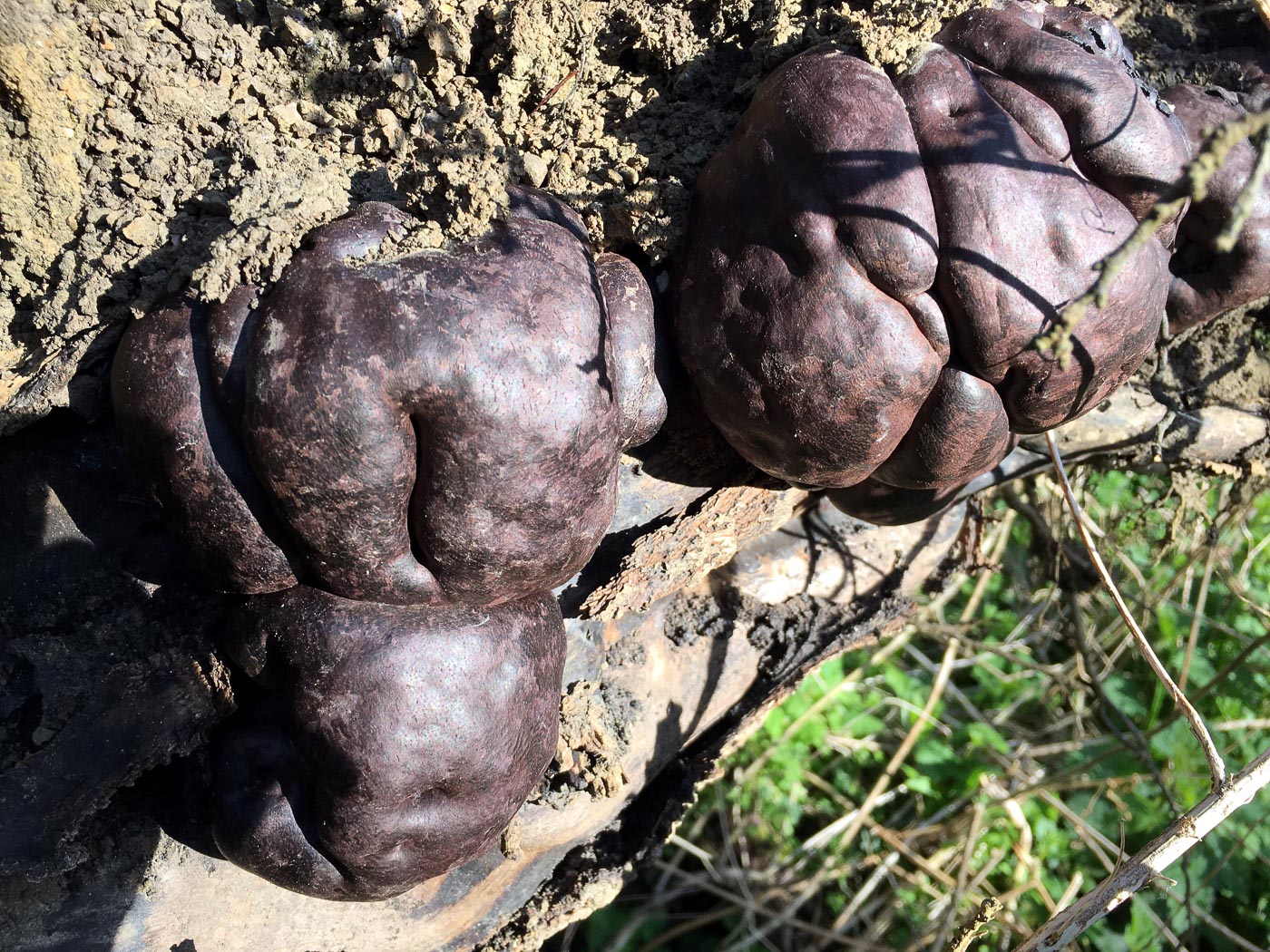
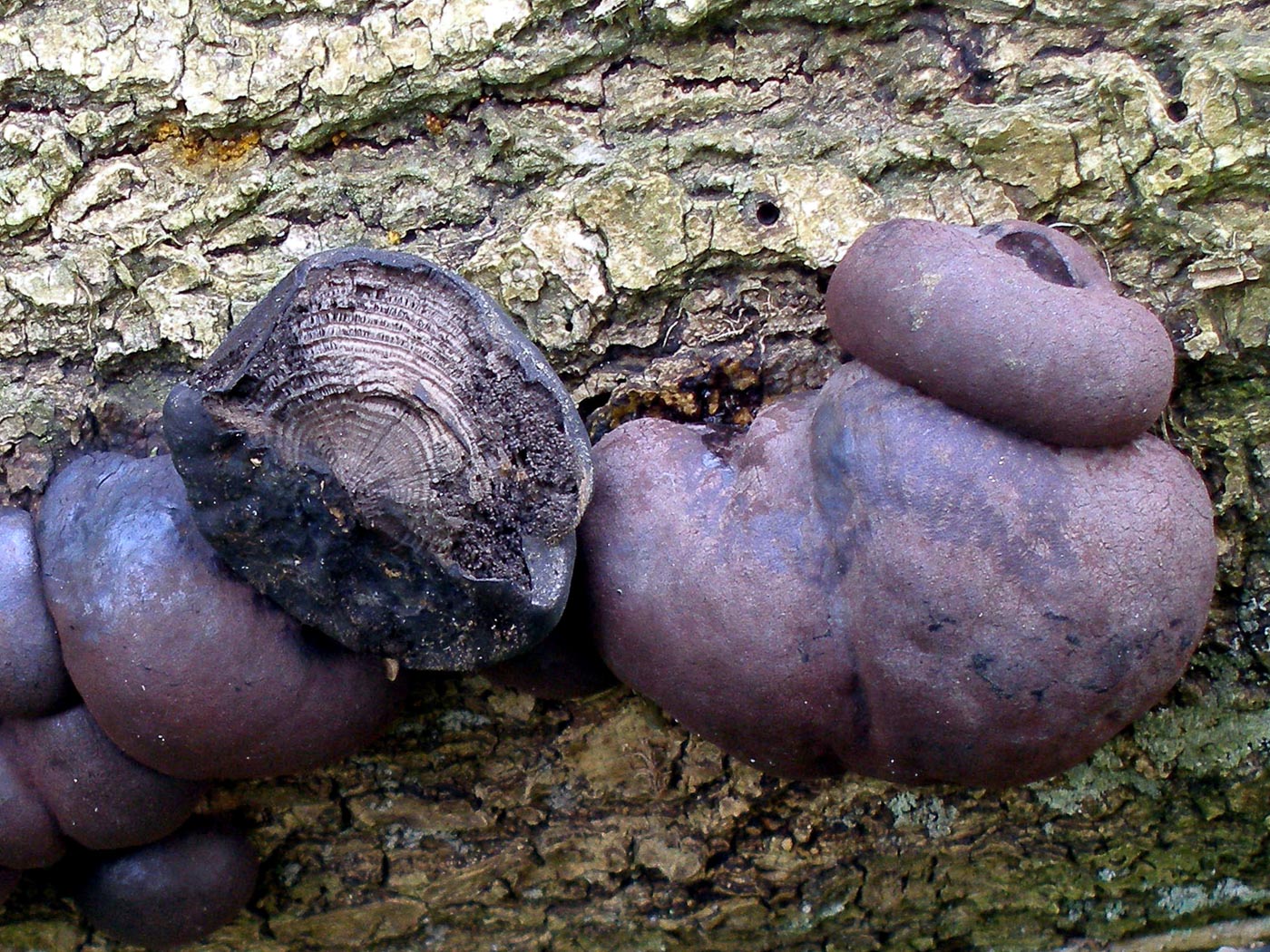
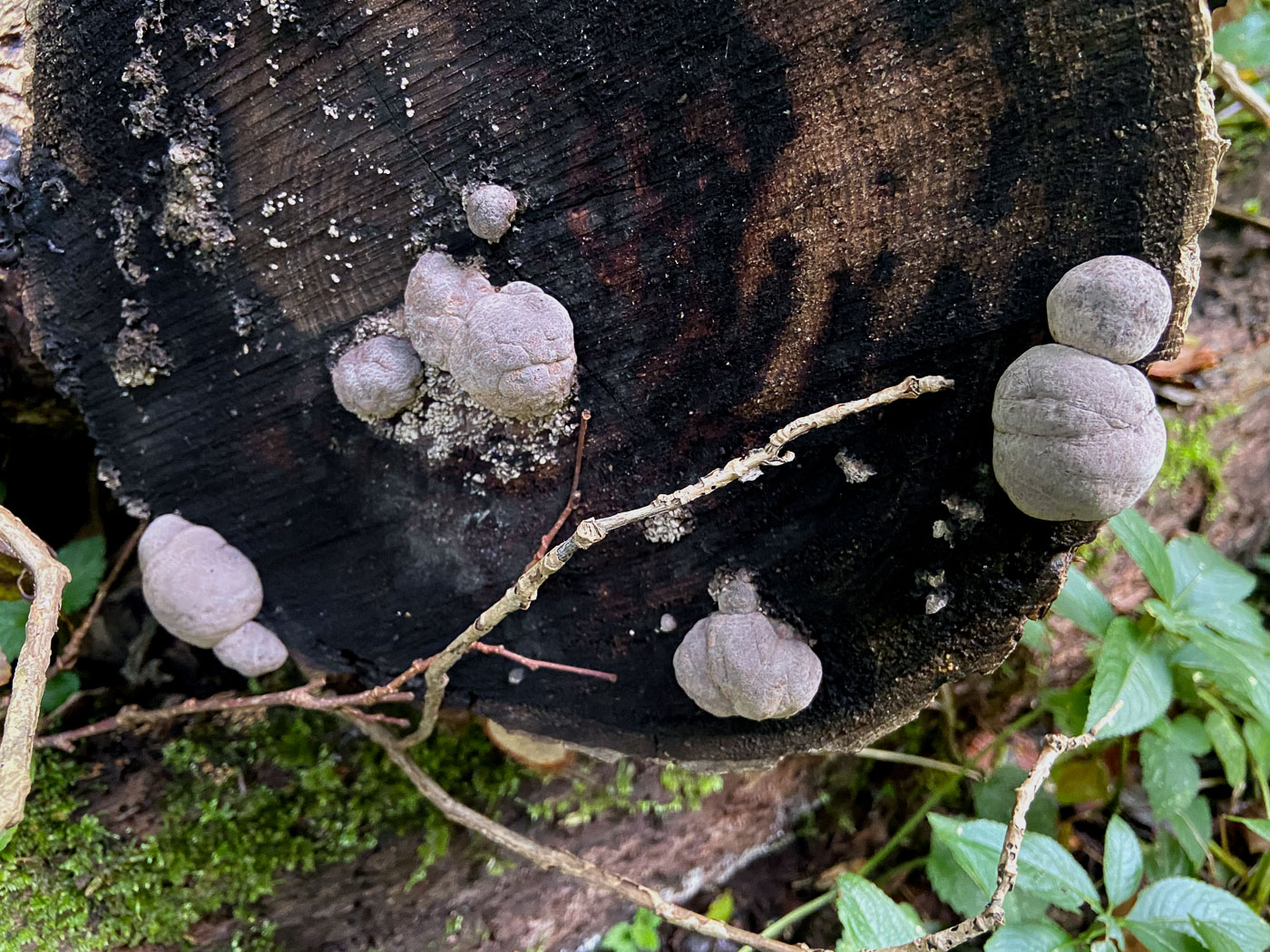
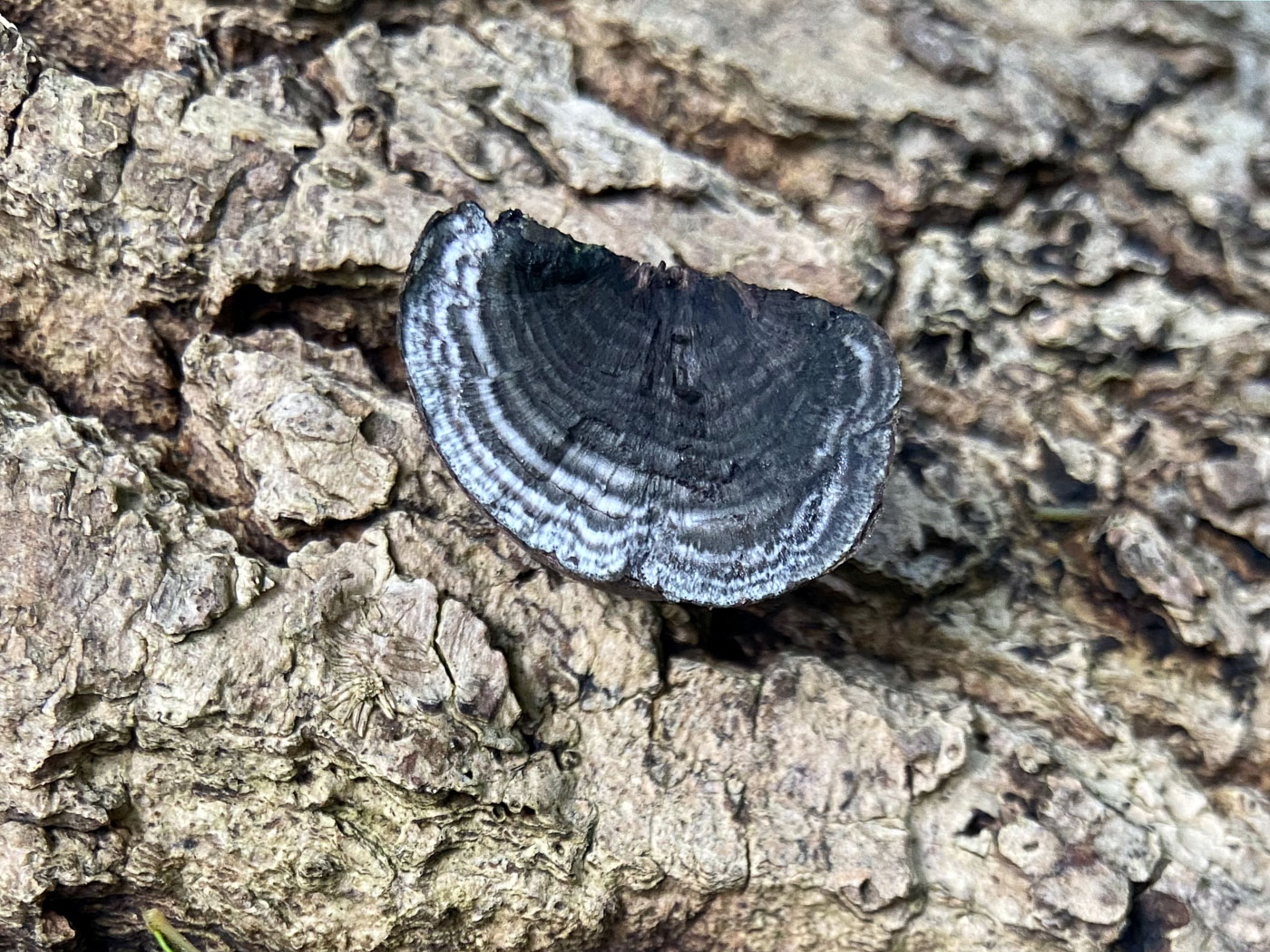
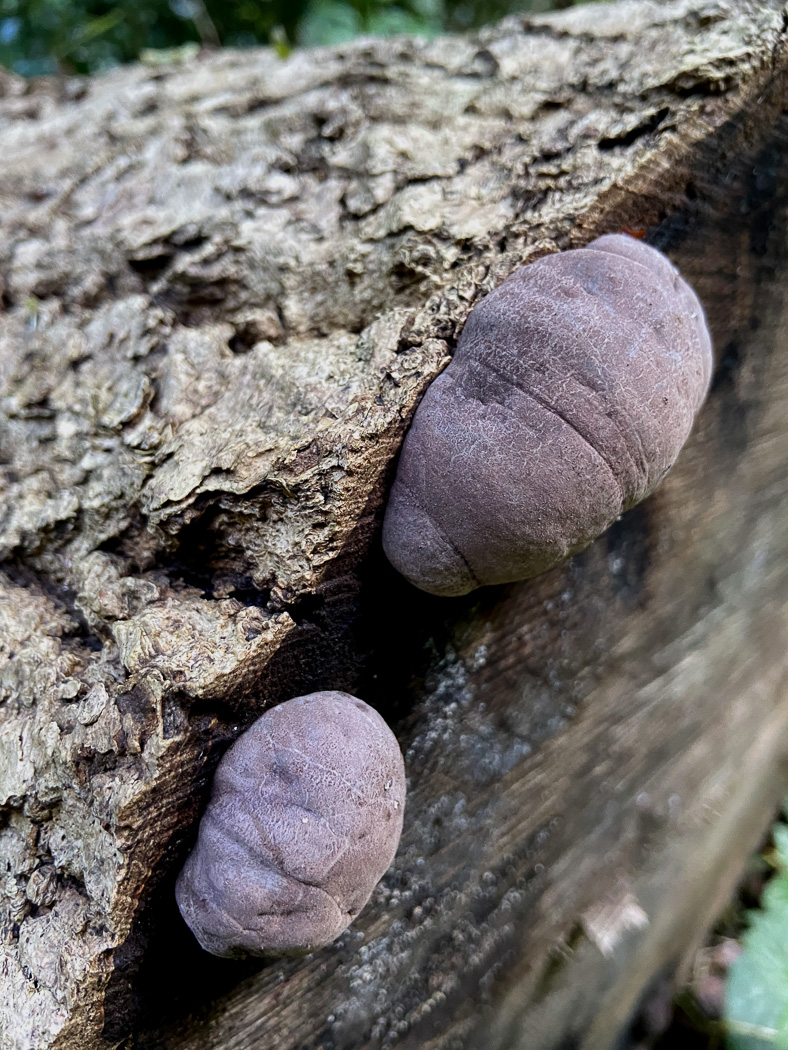
|
Daldinia concentrica (King Alfred's Cakes) Mar 20, 2024. In Beaconsfield Sarah Ebdon was bowled over by this magnificent display at the base of an Ask trunk. Her apt comment to Penny: 'The day King Alfred not only burnt the cakes but added WAY too much baking soda!'. She likened it to lava bubbling out of the tree and reported that it was on all sides of the trunk as well. A common species, yes, but this is an extraordinarily massive outbreak, the largest in her and Penny's experience. But for how much longer will the species be common, bearing in mind the demise of our Ash trees upon which it depends? Time will tell. Mar 9, 2024. In Tinker's Wood John Catterson found some nice examples of this very common fungus on fallen branches of Ash, with which it is host specific. Maybe in years to come this will become a rarity as our Ash trees succumb further to Ash Dieback Disease, following the same demise as Rhodotus palmatus (Wrinkled Peach) - once common when Elms were plentiful. John's photos here show both fresh (brown) and old (black) examples. Apr 24, 2023. Penny noticed this very common species at Rushbeds Wood fruiting as it always does on fallen Ash. When fresh it is more cocoa brown, developing its 'burnt' appearance as here as it matures. Photo 2 shows the distinctive concentric rings within if one breaks a 'cake' open. See the Masterlist for more images. Dec 30, 2022. On a felled log (presumed to be Ash) in woodland near Chalfont St. Peter Jim Wills noticed this nice display of mature 'burnt cakes'. The species can be found commonly on Ash at all times of the year. See the Masterlist for other examples which show the cocoa brown immature fruitbodies as well as the concentric rings within. Nov 24, 2022. On fallen Ash in Bradenham Woods Penny found suitable examples of this common species to show the main features. As with other Pyrenomycete Ascos, the fruitbodies are cocoa brown at first but black when mature and can get to 6 or 7 cms across. They are easy when mature to break open to reveal the concentric rings within. Apr 12, 2022. On fallen Ash near Chalfont St. Peter Jim Wills noticed these nice examples of a common Ascomycete - one of the largest Pyrenomycete species which can get to about 4cm across or more, sometimes singly, sometimes clustered as here. Today's were about 3cm across and still at the cocoa brown stage; later they become shiny and black and photo 2 shows the typical concentric rings revealed when a specimen is broken open. It is very common on dead and dying Ash. Apr 4, 2021. Joanna Dodsworth found these huge specimens of fallen Ash near Tram Hill Ponds on Brill Common - they were each apparently 10-12 cms across which is probably about as big as they get! This common Ascomycete is host specific to Ash (though there are other much less common Daldinia species found on other substrates) and starts out chocolate brown covered with a whitish 'bloom' turning black with age. Break one open to reveal the concentric rings within which give rise to its species name. Photo 2 (one of Penny's library photos) shows these features, as do those dated Oct 10th in Finds 2020). Oct 10, 2020. This very common Ascomycete has been conspicuous by its absence so far this season and was found by Sarah Ebdon in North Dean, Hughenden Valley on felled Ash. This is young fresh material thus its rather pale appearance with pruinose 'bloom'; once this is lost it eventually turns from cocoa brown to black (like burnt cakes!) Sarah broke one open to see the telltale concentric rings within which are a diagnostic feature of the genus, of which this is the only common species and nearly always found on Ash. |

 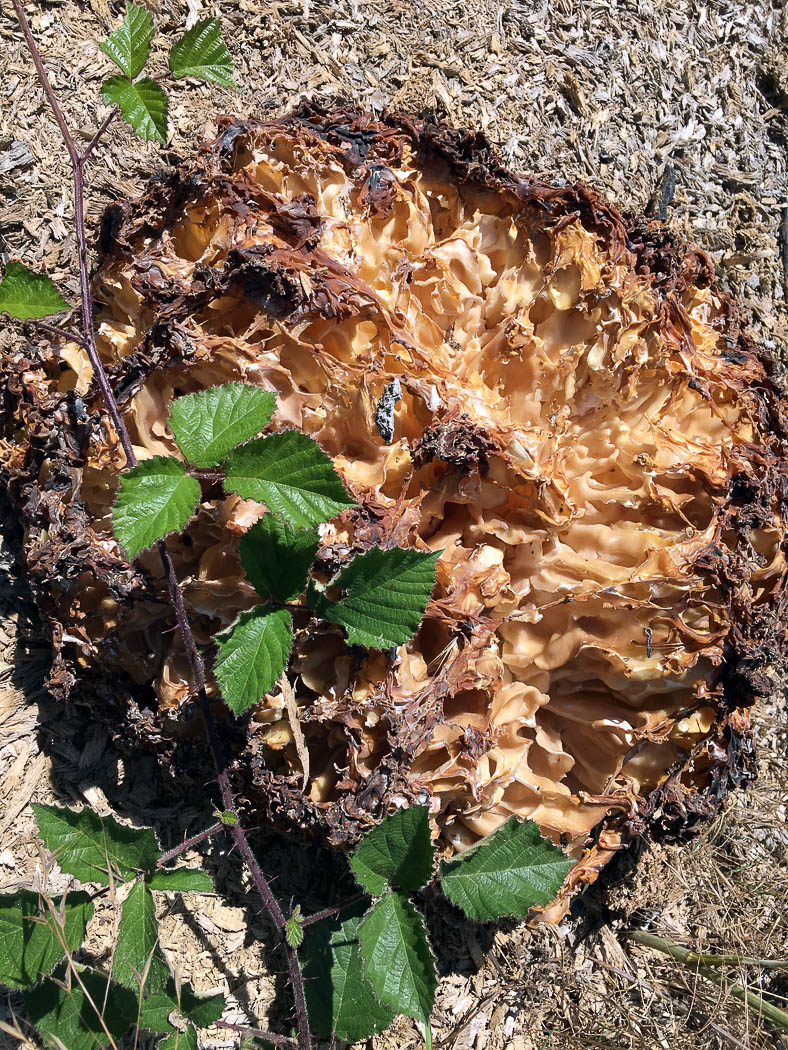 |
Daleomyces phillipsii (Bonfire Cauliflower) Jun 28, 2023. At Turville Heath Penny made sure she visited a particular bonfire site which has produced good numbers of interesting species in the past few months including three different Peziza species. One of them, Peziza petersii, was still in evidence today and has been fruiting here since April (see Finds 2023 April 15th), but she was even more thrilled to see a large expanse of what appears to be Sparassis crispa (Wood Cauliflower) but in fact is unrelated and is an Ascomycete until recently also attributed to the genus Peziza (P. proteana var. sparassoides) owing to its very similar microscopic characters though it looks nothing like any other member of that genus. The clump was well over a foot in diameter though clearly past its best and a bit shrivelled at the edges owing to its exposed position. It is considered rare, only occurs on burnt ground, and has now been moved to the genus Daleomyces together with P. petersii. Penny has found it only once before (2001 at College Lake), but it turned up at Wotton House Estate last year, found be Joanna Dodsworth on June 22nd. Jun 22, 2022. At Wotton Park Estate Joanna Dodsworth spotted what she assumed had to be Sparassis crispa (Cauliflower Fungus) on a woodchip pile under Oak. She knew that the species occurs at the base of conifers but felt it just had to be that from its very distinctive appearance. Her photo, when sent to Penny and Derek, aroused suspicions that it was more likely to be S. brevipes - rare but occurring with deciduous trees, especially Oak. So we asked for samples to check and to have sequenced. However, when Derek checked a sample with a scope he was amazed to find not basidia but asci, i.e. this was an ascomycete and not related to Sparassis at all! In fact a drop of Melzers on the slide turned the asci tips bright blue - a sure sign that this was a species of Peziza, unlikely though it may seem. So this amazing Cauliflower lookalike is what was previously known as Peziza proteana var. sparassoides, though now with the new name given above. It is considered rare and normally appears on old bonfire sites in late Autumn or Winter, so a sample will be sequenced to confirm its identity as this interesting find is in mid-summer and on woodchip! We have just two previous county records (under its previous name): one in Jan 2001 and one in Nov 1978. |
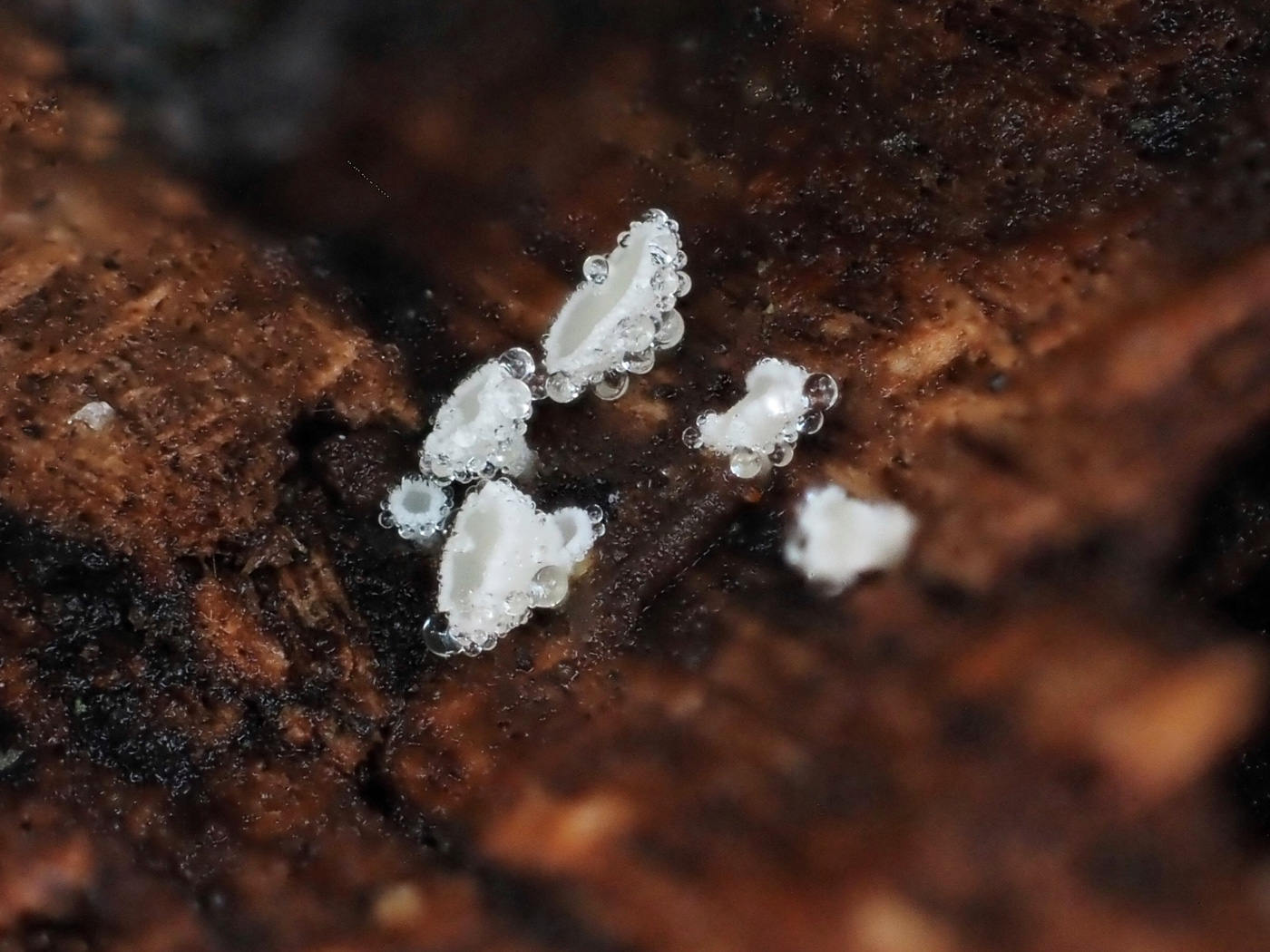 |
Dasyscyphella nivea (a white disco with no common name) Jan 12, 2022. In Naphill Common Barry Webb found these tiny hairy white discos on fallen wood (the photo is by Claire Williams), and from the photo Penny surmises this is not Lachnum virgineum as suggested but D. nivea (previously also in Lachnum) owing to the lack of a longish stem to the discs and also the plentiful droplets trapped within the hairs and typical of this equally common species. (See also in the report for Rushbeds Wood, November 20th 2021.) |
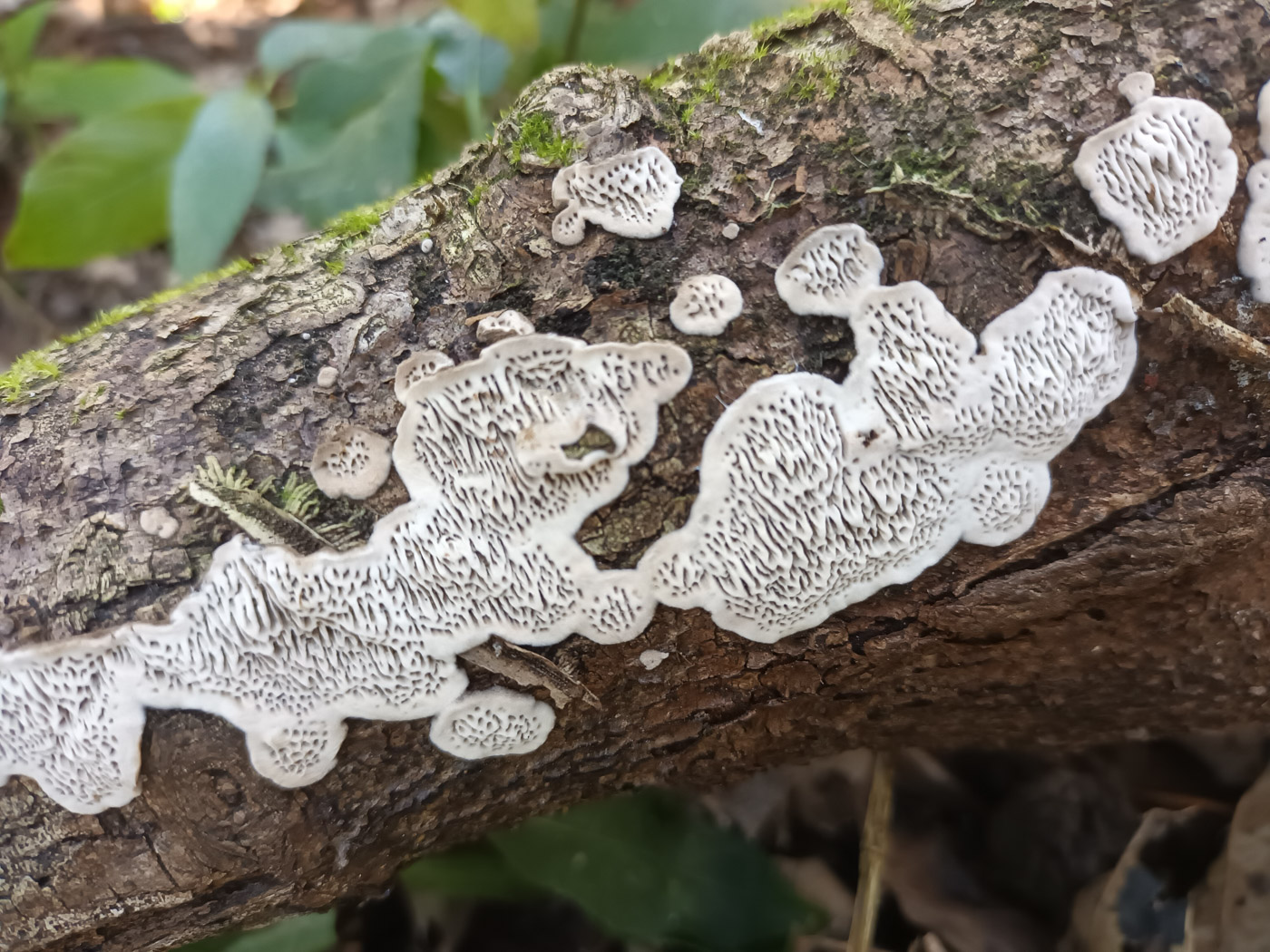
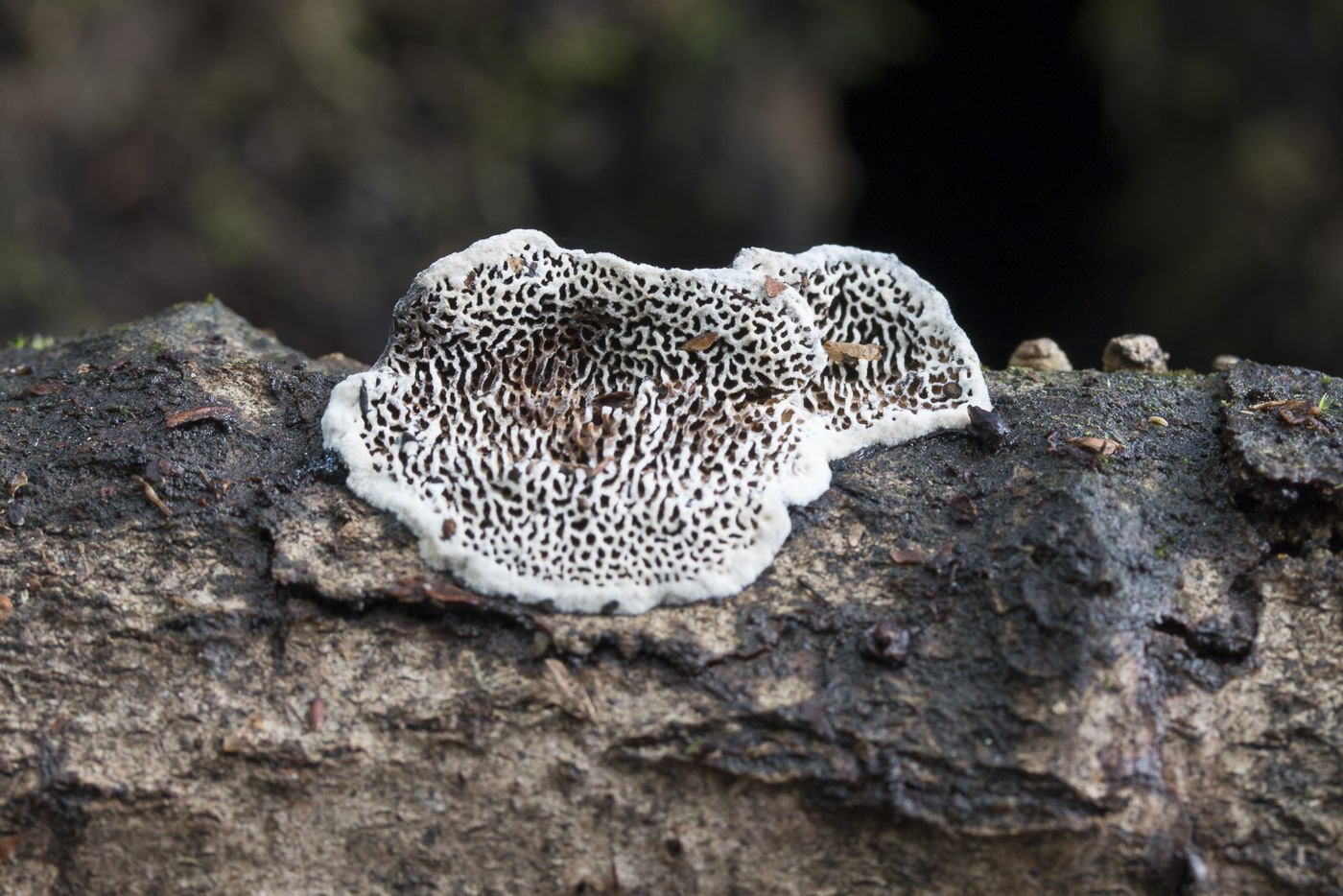 |
Datronia mollis (Common Mazegill) Jan 30, 2022. In woodland near Jordans Village Jesper Launder found fresh material of this common species on fallen deciduous wood. Unlike other brackets also named Mazegill (for obvious reasons), this one starts out resupinate and long remains so, eventually forming only a small shallow brownish bracket if that. The labyrinthine surface is soft and whitish as here when fresh but soon becomes tough and darkens to ochre or brown. A useful clue to its identity is that it peels off the substrate very easily, unlike most resupinate fungi. May 19, 2021. At Burnham Beeches Claudi Soler found this very common species on fallen Oak. It is often to be seen covering large expanses of smallish dead deciduous branches and this photo shows its typical labyrinthine poroid creamy surface well, though at earlier stages of development it is easily confused with the many other creamy white corticioid fungi. |
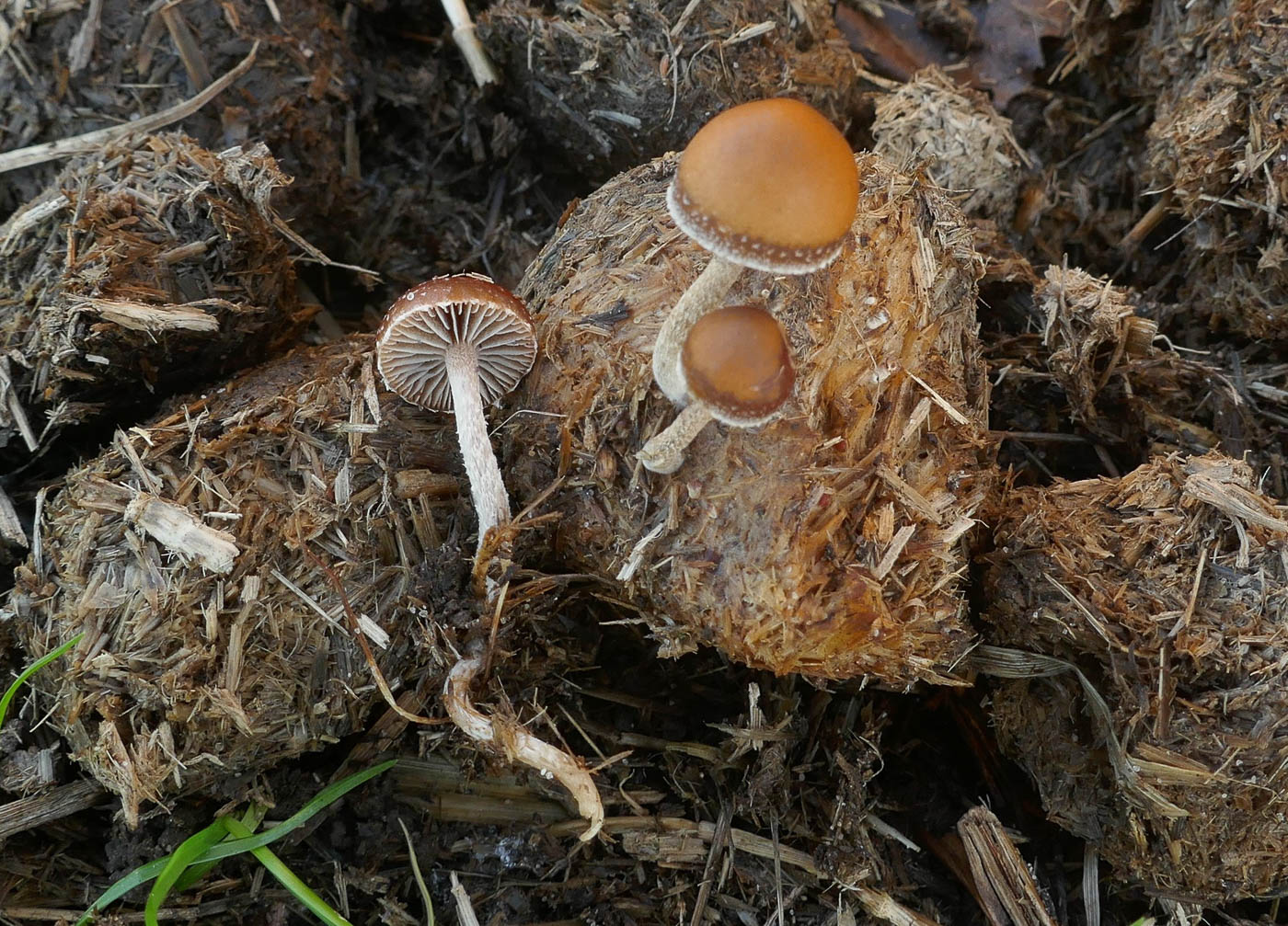
|
Deconica coprophila Dung Demon Nov 12, 2022. On a dung heat at Stampwell Farm Jackie Ewan found this little crop of attractive LBJs, previously in genus Psilocybe. (Incidentally the common name used here is not on the official English list and I suspect is the American name which may well be adopted onto our list at some stage.) Not rare, though exploring dung heaps and cowpats is not everyone's cup of tea so it probably goes unnoticed, this is a first for Finds. |
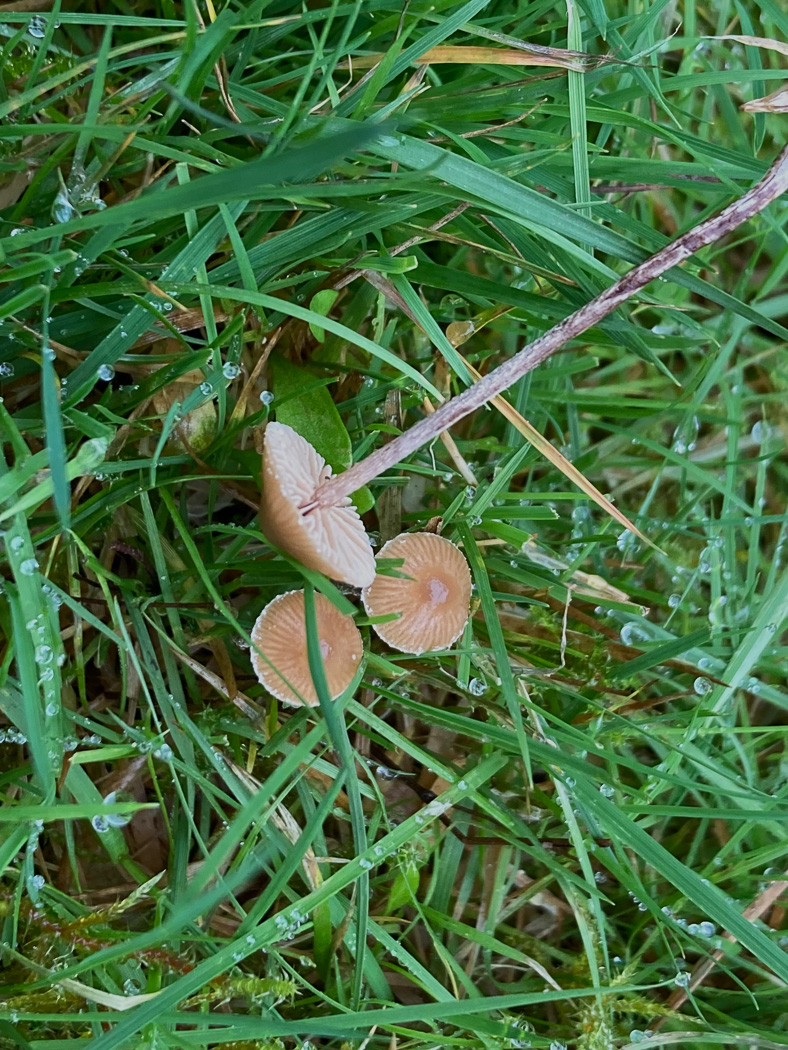
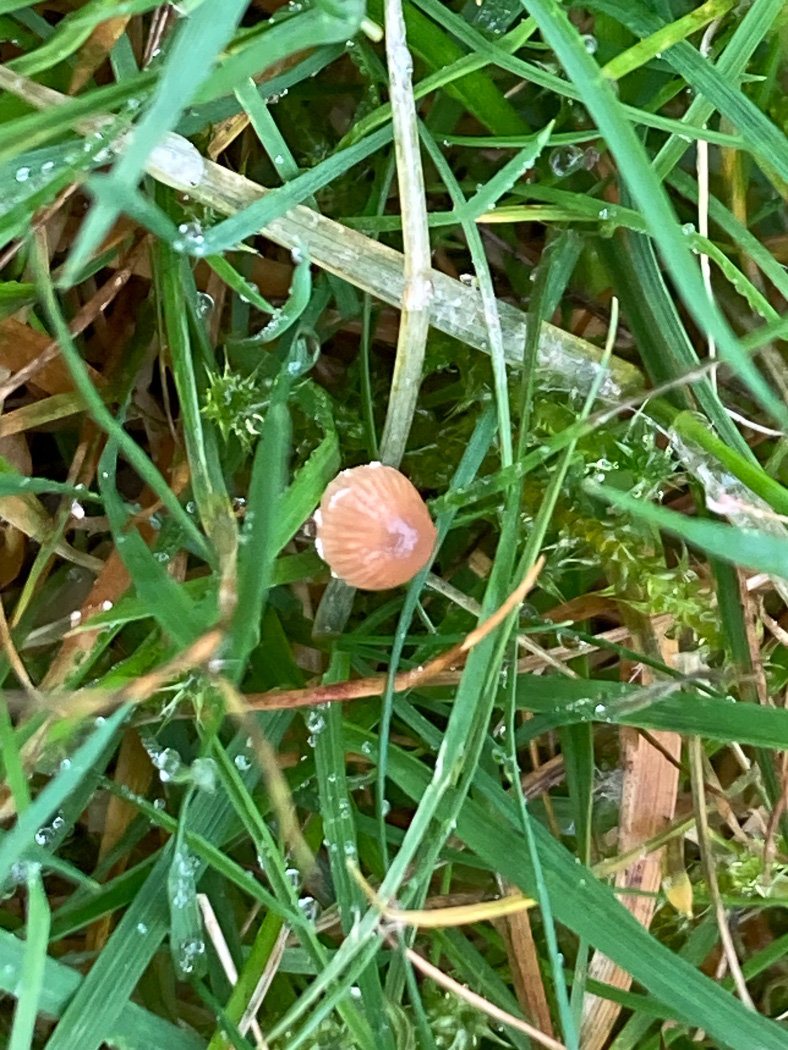 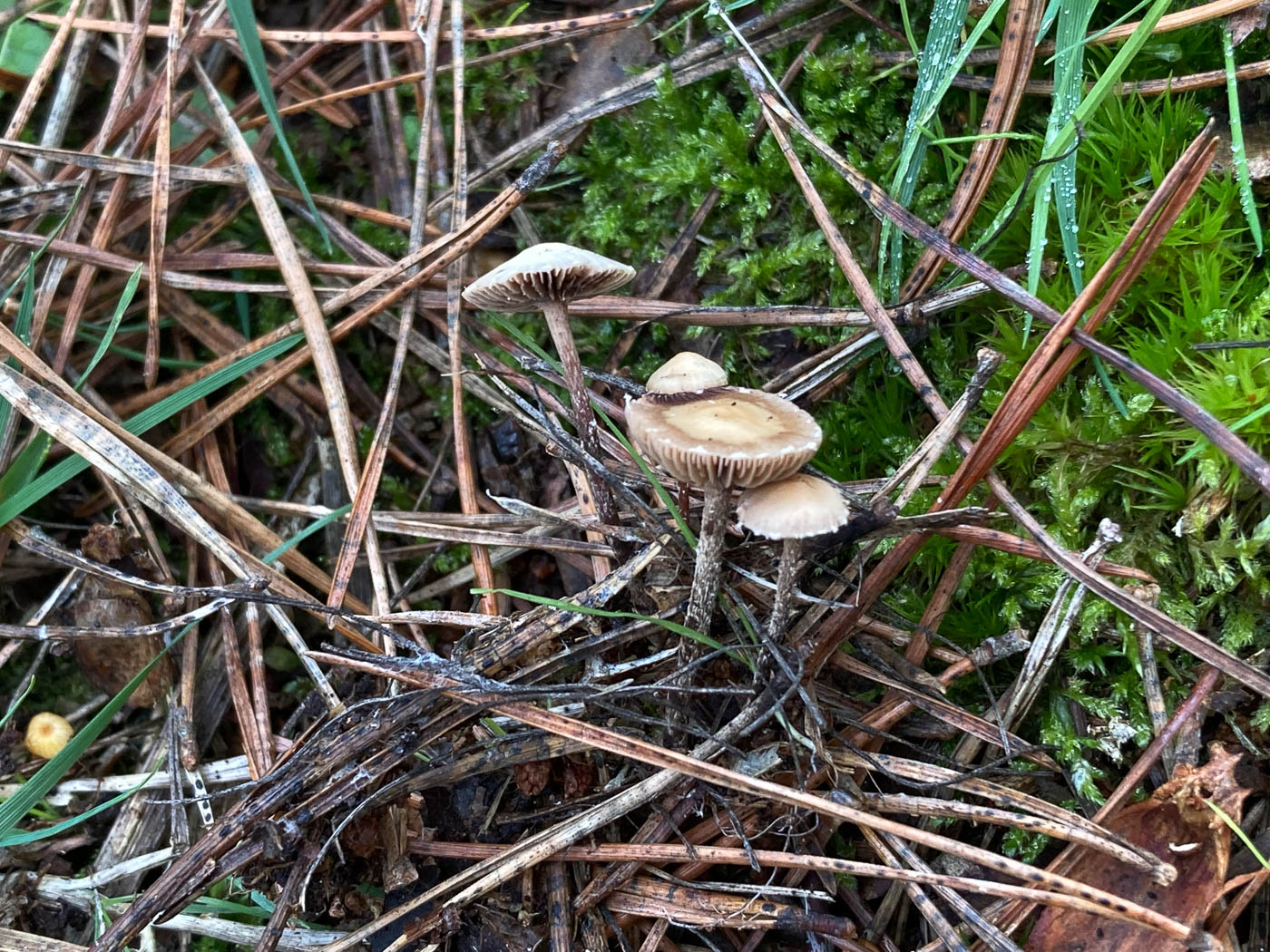 |
Deconica crobula (a Brownie with no common name) Nov 9, 2024. In low cut mossy grass at Cliveden Estate Russell Ness found these few LBJs and took them home to work on. The gelatinous peelable cap cuticle together with spore colour, size and shape took him to this species with which the pale cap having visible veil remnants fitted well. The species is somewhat similar to D. inquilina which (judging from descriptions) has slightly longer spores and more widely spaced gills (see Finds entry from Stampwell Farm Nov 2nd for comparison) though both are found on woody debris- sometimes submerged - and also in grassy areas. Oct 31, 2022. At Burnham Beeches in damp mossy vegetation Russell Ness found this unusual LBJ which he thought at first glance could be a species of Tubaria (Twiglet). However, the 'jizz' wasn't quite right and the microscopy soon proved it was not that genus but in fact Psilocybe (though many of that genus including today's species are now moved to Deconica - yet another new name to accept!). We have a just handful of previous county records and this is a new entry for Finds. |
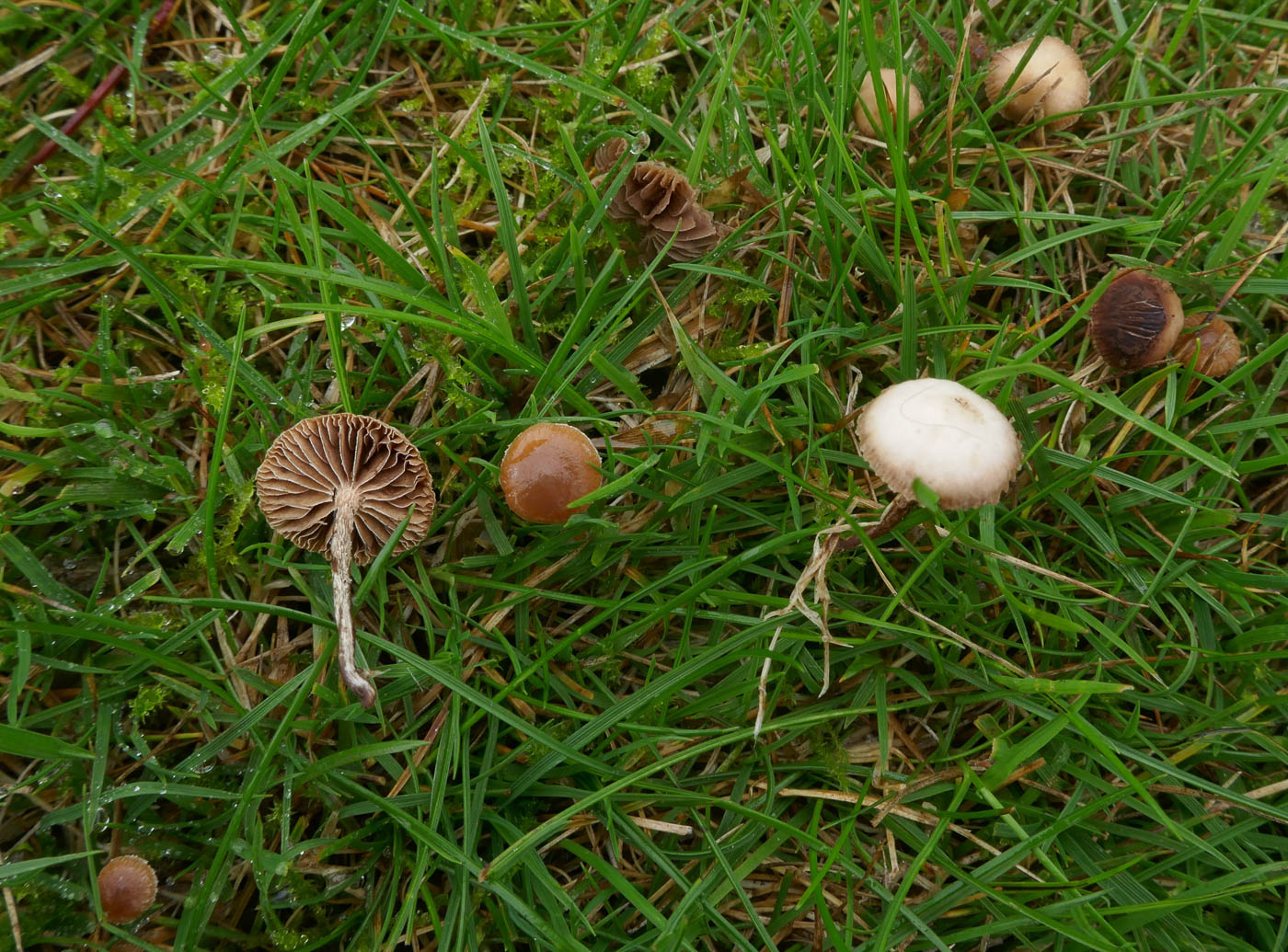
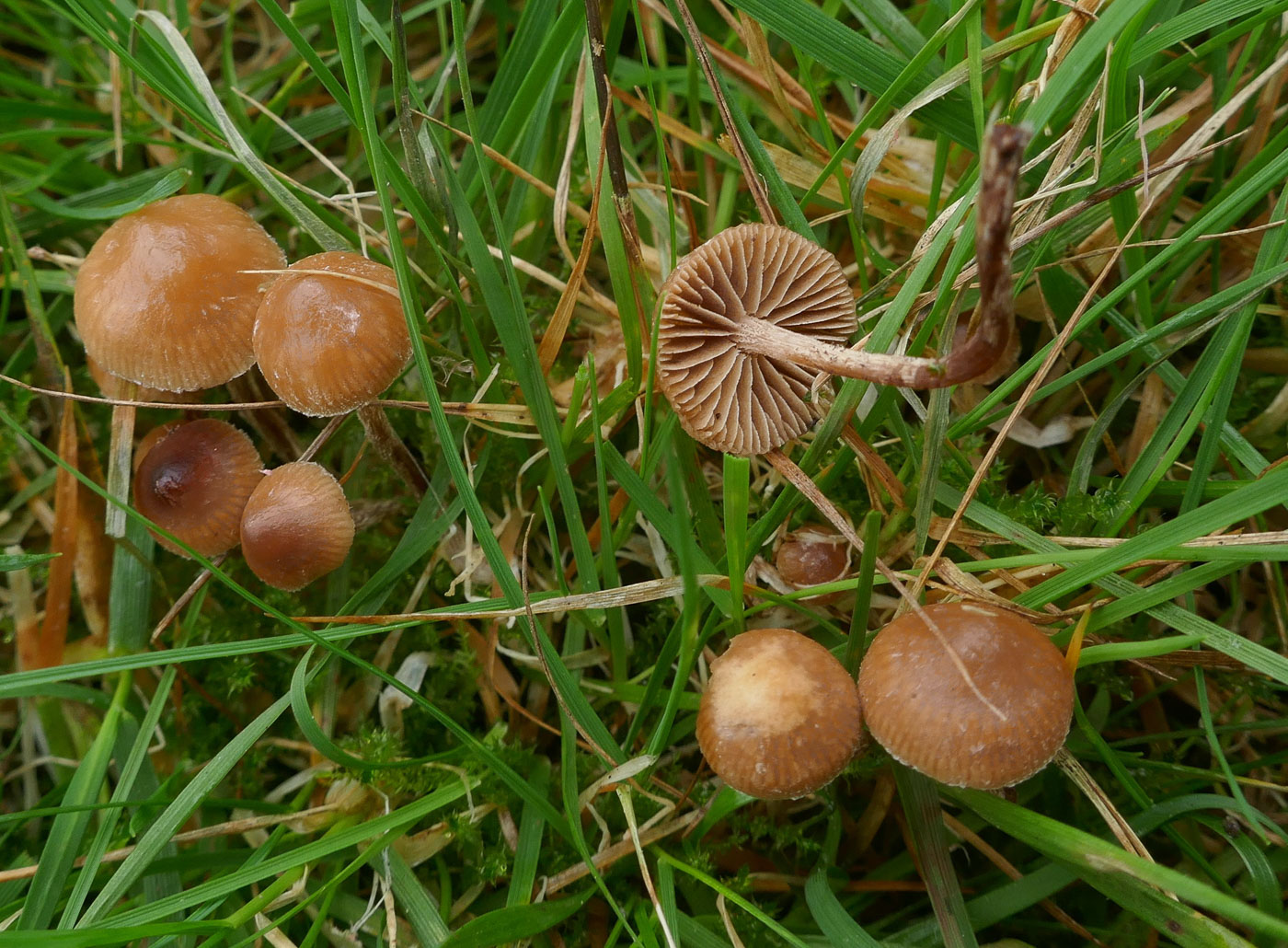 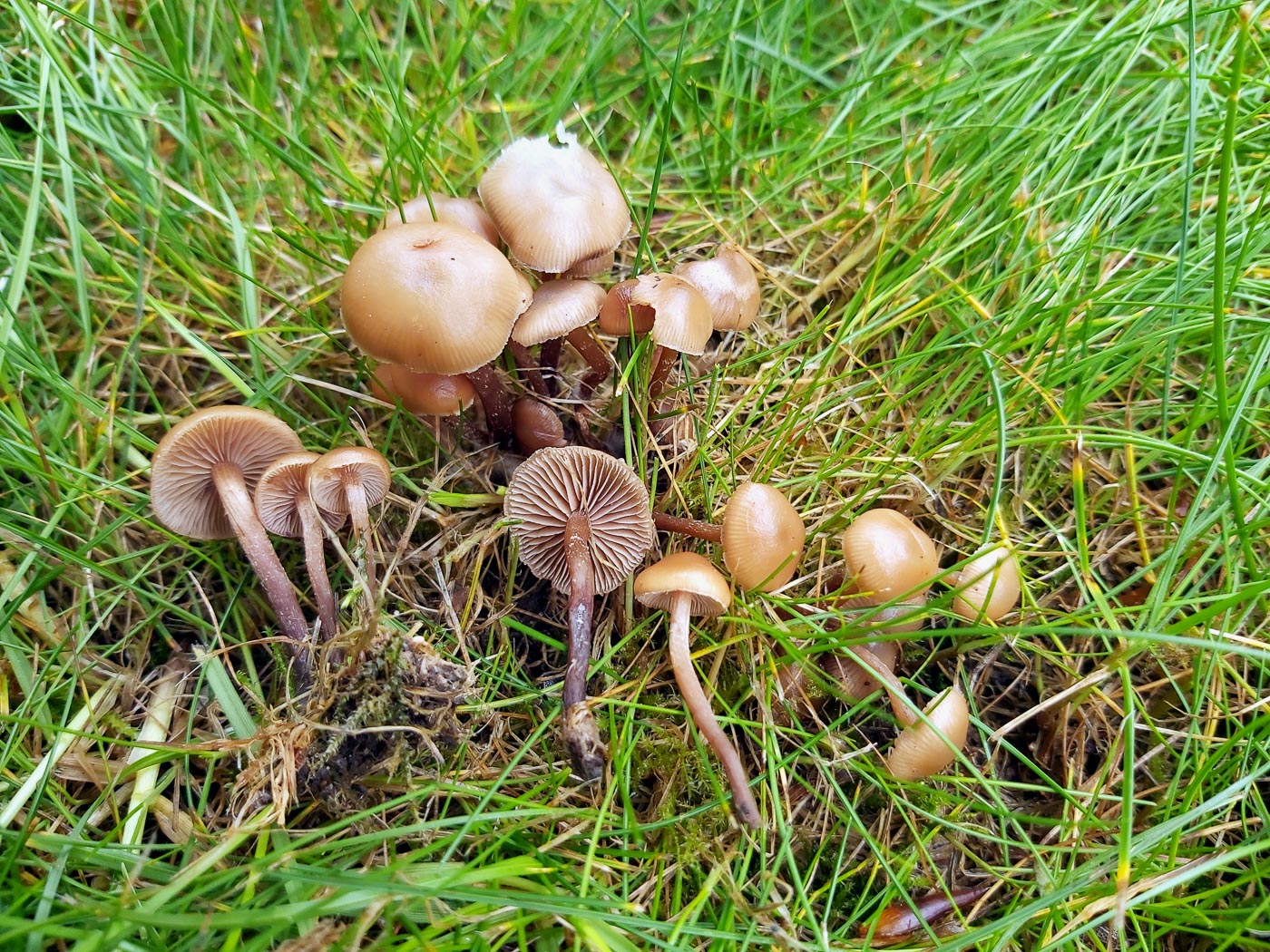 |
Deconica (was Psilocybe) inquilina (a species of Brownie with no common name) Nov 2, 2024. At Stampwell Farm Jackie Ewan noticed this LBJ growing on dead grass stems, one that she didn't recognise and needed work to identify. She discovered that it had an unusual cap surface which was gelatinous and entirely peelable, and this together with the obvious white veil markings around the cap margin led her to this unusual species for which we have just a handful of previous records, mostly under its previous genus name Psilocybe. May 24, 2021. On his lawn at home in Jordans Jesper Launder found this uncommon species - a typical rather non-descript LBJ needing careful examination to identify. An important feature is its sticky rubbery cap covering which can be peeled off completely and this taken into account together with its microscopic features and spring fruiting in lawns / grassland were diagnostic. We have just two previous county records, both from lawns in May. |
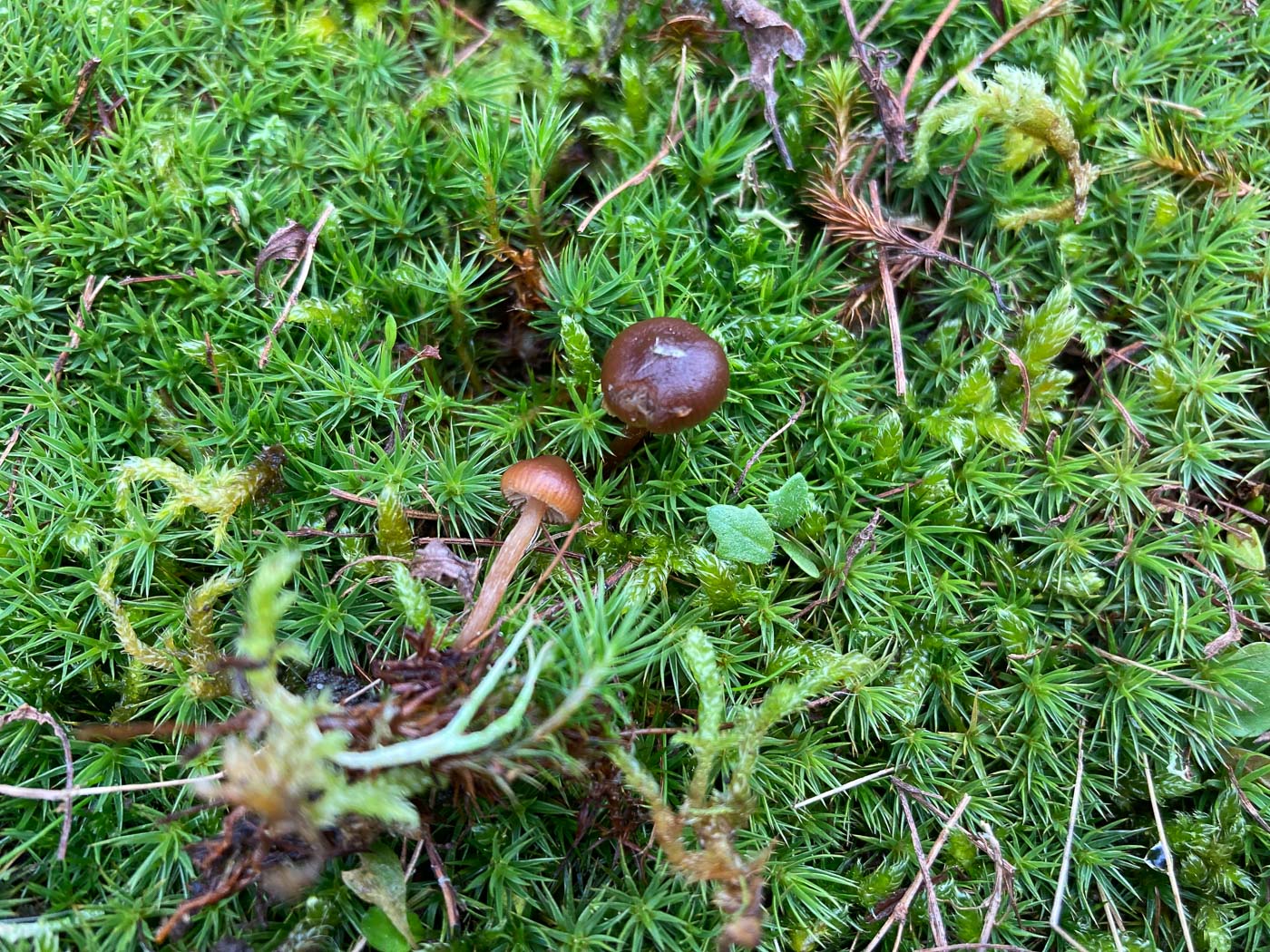
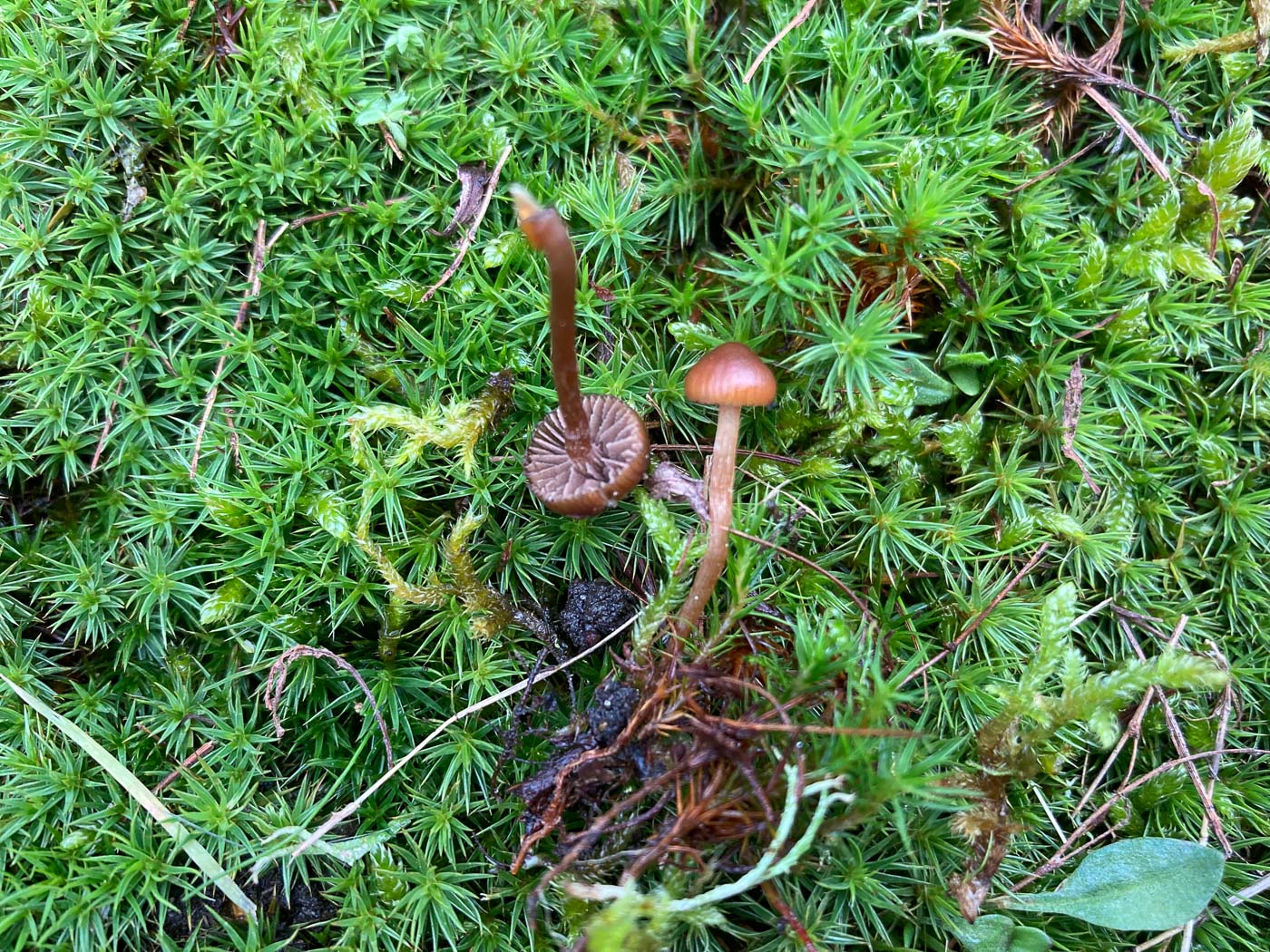
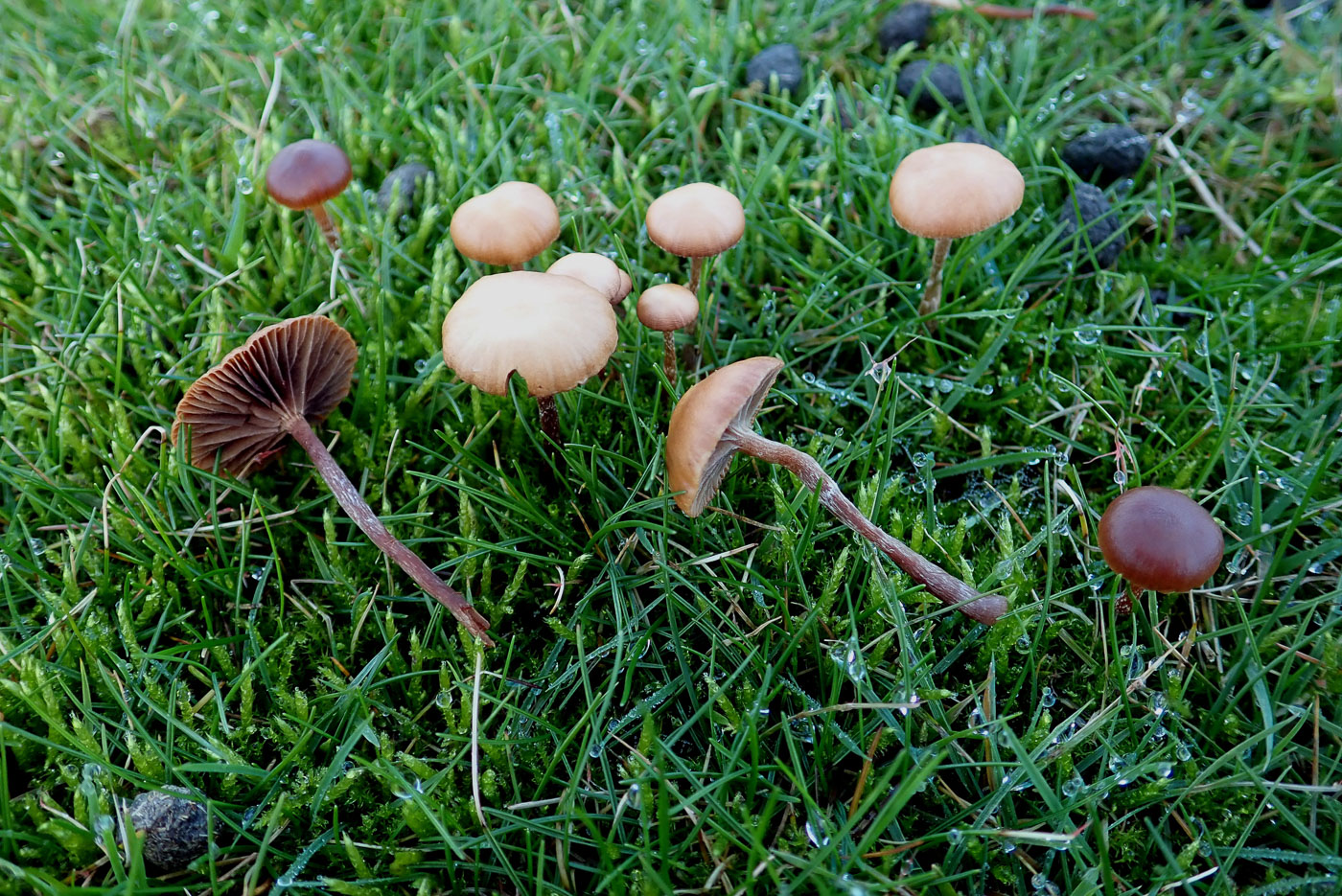
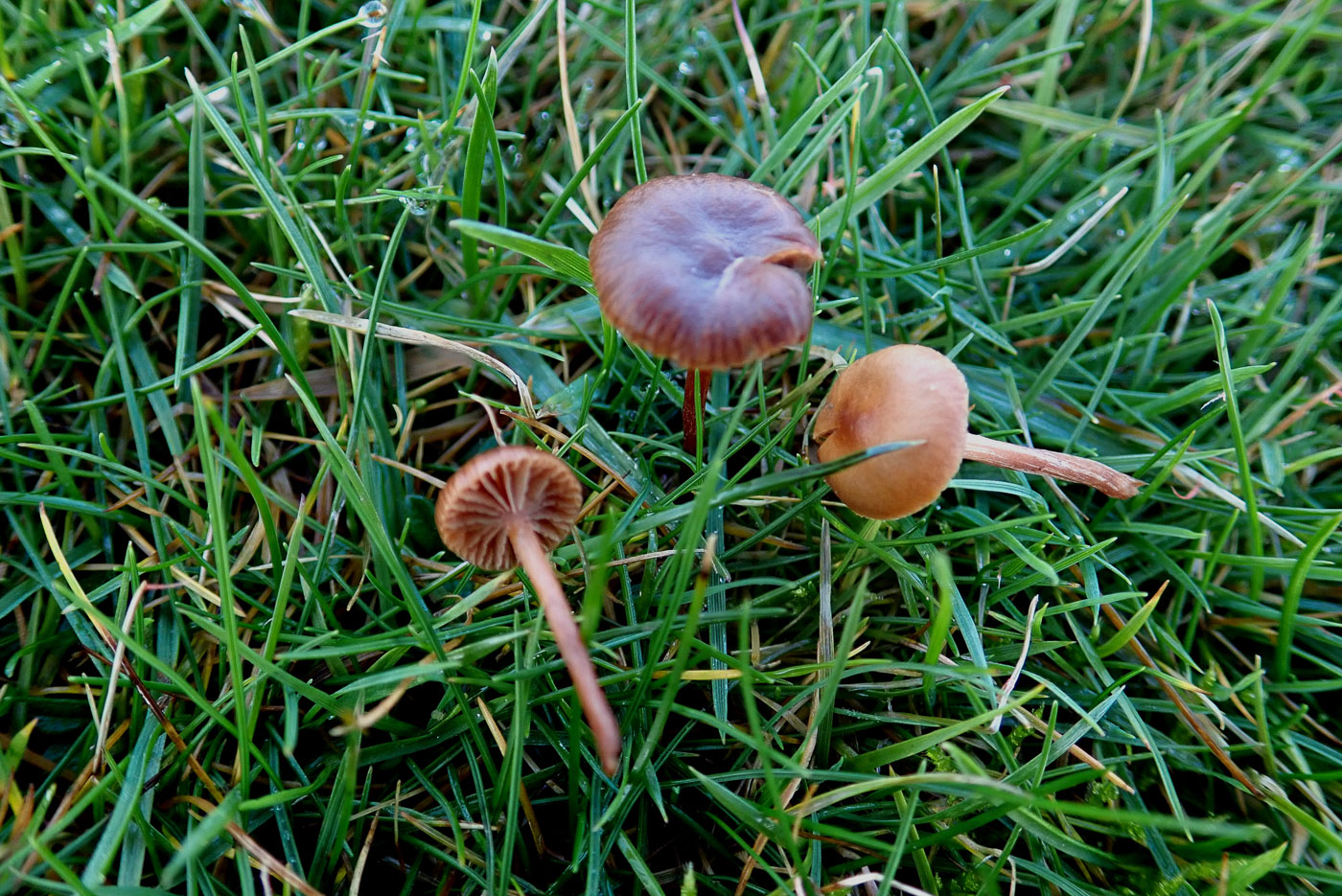
|
Deconica montana (Mountain Brownie) Dec 12, 2021. In The Gore, Burnham, an acid depression, Russell Ness found and worked on these LBJs, previously known as Psilocybe montana. We have just two previous county records though the species is not generally considered rare - it's just that such grassland LBJs tend to be overlooked and rarely take priority when identifying at home with a scope. Nov 22, 2020. On the very mossy Gt. Hampden Cricket Pitch Penny C. found quite a few little gatherings of a dark-capped little mushroom with even darker gills and stem which she guessed might be a species of Psilocybe. Several specimens were considerably paler and faded, however, pointing to a distinctly hygrophanous species, and she also noted the rather mottled effect on the gills. At home this took a while to sort out because (a) the genus Psilocybe has now been split and this collection didn't key out under that name, and (b) when I eventually twigged that it might be under Deconica the key was so full of errors in its numbering system that it didn't make any sense! Eventually, by cross referencing, she arrived at this species with a somewhat deceptive name: it is not necessarily alpine but found in moss in heathland / grassland. We have just one previous county record though Penny suspects it is quite common though under-recorded (possibly due to the inefficient and confusing keys available!). |

 |
Deconica sp (an unidentified LBJ) Apr 24, 2023. At Burnham Beeches Penny spotted these two tiny LBJs in a grassy area of well manured soil at Burnham Beeches, the largest cap being well under 1 cm across. Having black but clearly mottled gills and a stem spotted with black spores suggested the genus (one fairly recently introduced for those species of Psilocybe which lack blue colours in the stem and have no Psilocybin). Keying it out at home proved confusing: though the spore size and shape and occurrence on dung pointed to D. coprophila or merdaria other features didn't fit either species very convincingly. (See a good photo of D. coprophila in Finds dated 2022 November 12th). It is hoped that sequencing will help, at which time this entry will be updated. |

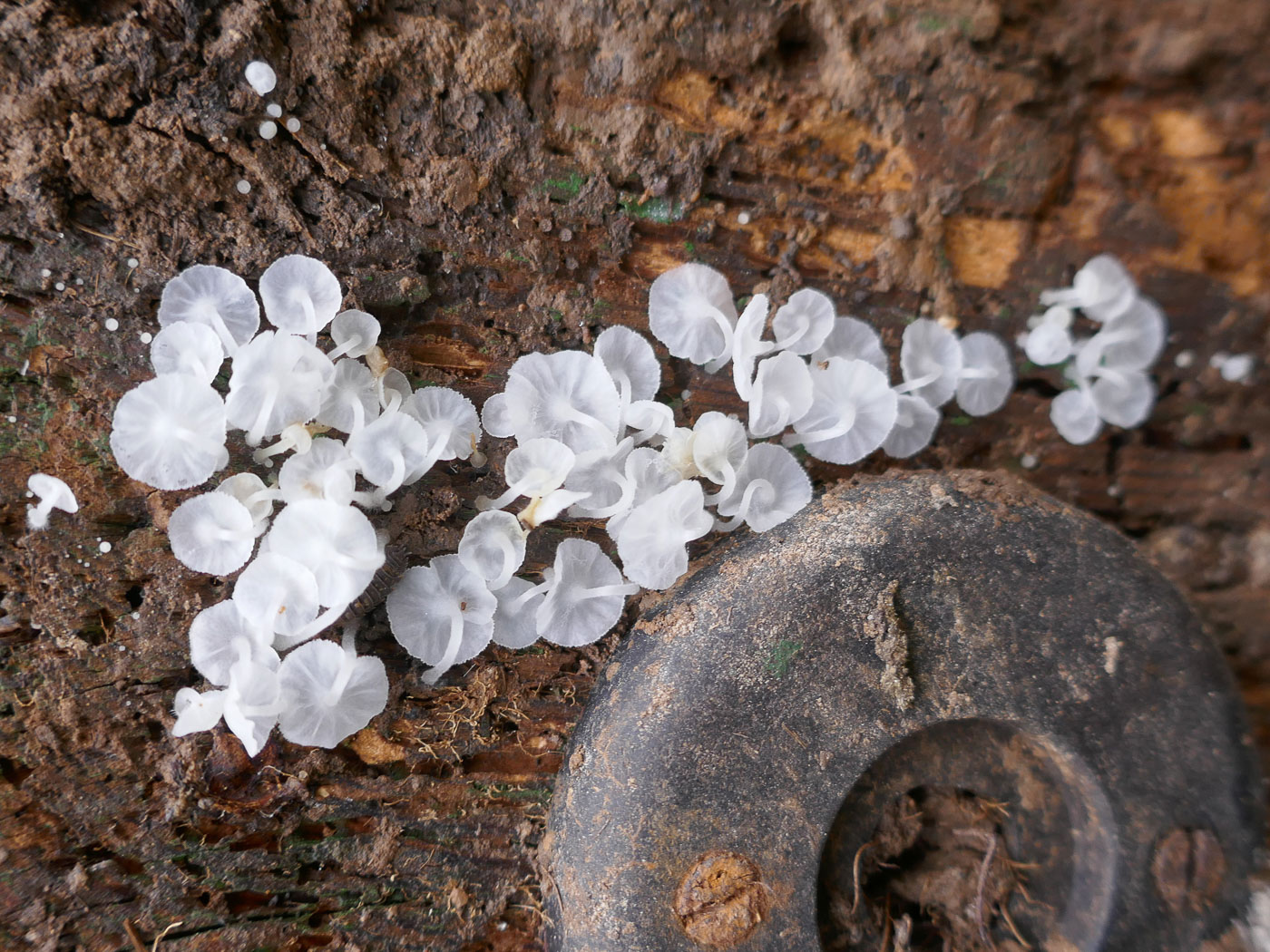
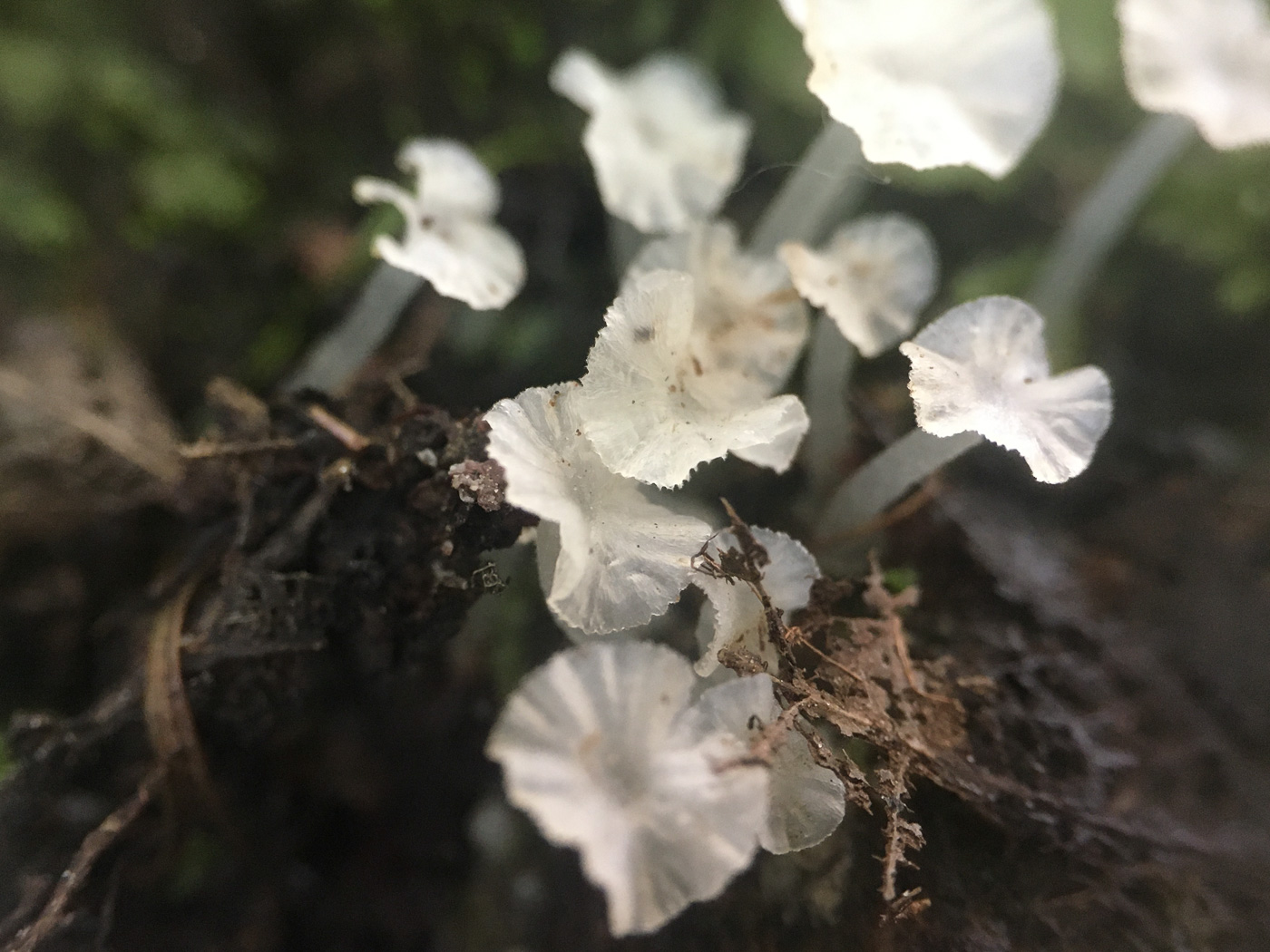
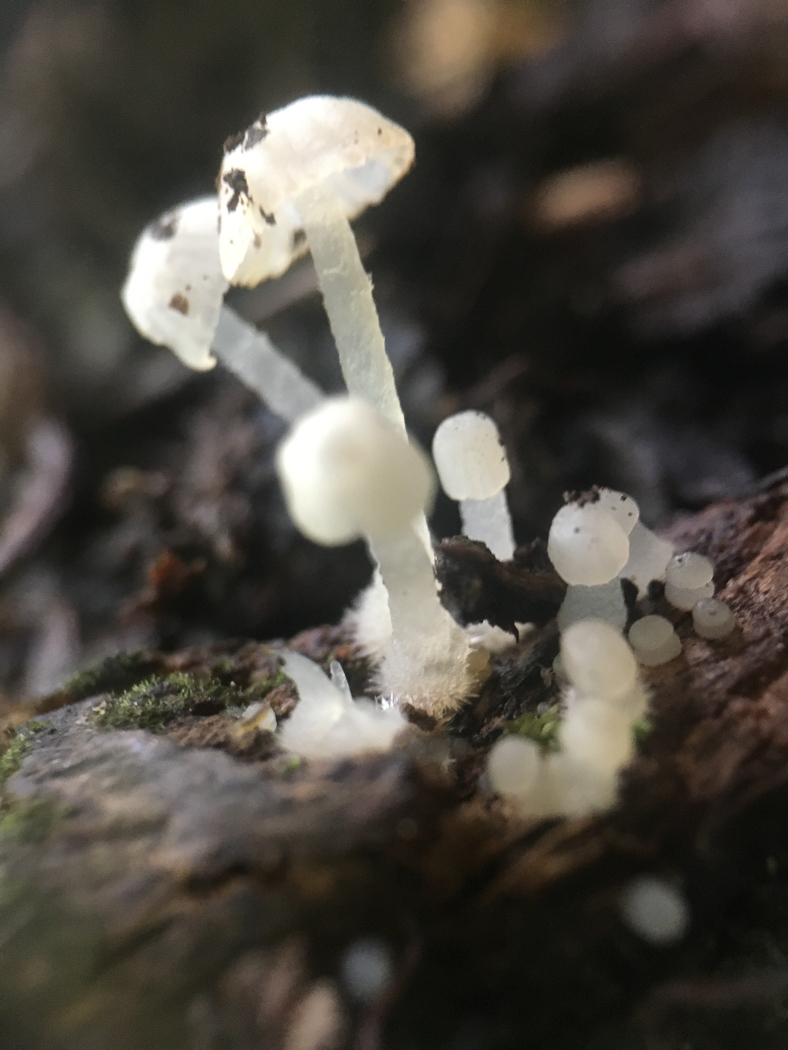
|
Delicatula integrella (a unusual Bonnet lookalike with no common name) Aug 21, 2023. In Bradenham Woods Penny came across various patches of this unusual tiny white 'Bonnet' in damp muddy debris along the wide rides. Suspecting it was this species, which in the past has utterly confused her, she took it home to check. Both Mycena and Hemimycena - sometimes remarkably similar when small and white - have quite distinctive gill cells, but this species lacks these gill cells entirely and also has distinctive amyloid spores which seem to vary in shape quite considerably. With a hand lens one can see that the gills are somewhat shallow and not sharp edged with some branching also - certainly unlike Mycena. Jun 24, 2021. Jackie Ewan noticed this cluster of tiny white mushrooms (photo 1) at Stampwell Farm growing on the underside of an old door now used as a reptile refuge! Then two days later Russell Ness found the same species in the mire at Burnham Beeches growing in good numbers on alder roots (photos 2 and 3). At first glance this could be one of several miniscule species of white Bonnets which can occur on rotting wood but there are clues which point to its identity in the field though this really needs confirmation from its microscopic characters (spore shape and size, also the lack of cystidia on the gill edge). Note the slightly serrated cap edge and rather veinlike reduced gills particularly towards the margin. Caps, no larger than 1 cm across, have an opaque spot in the centre. We have just a few sites where this occasional species has turned up - so two nice finds. |
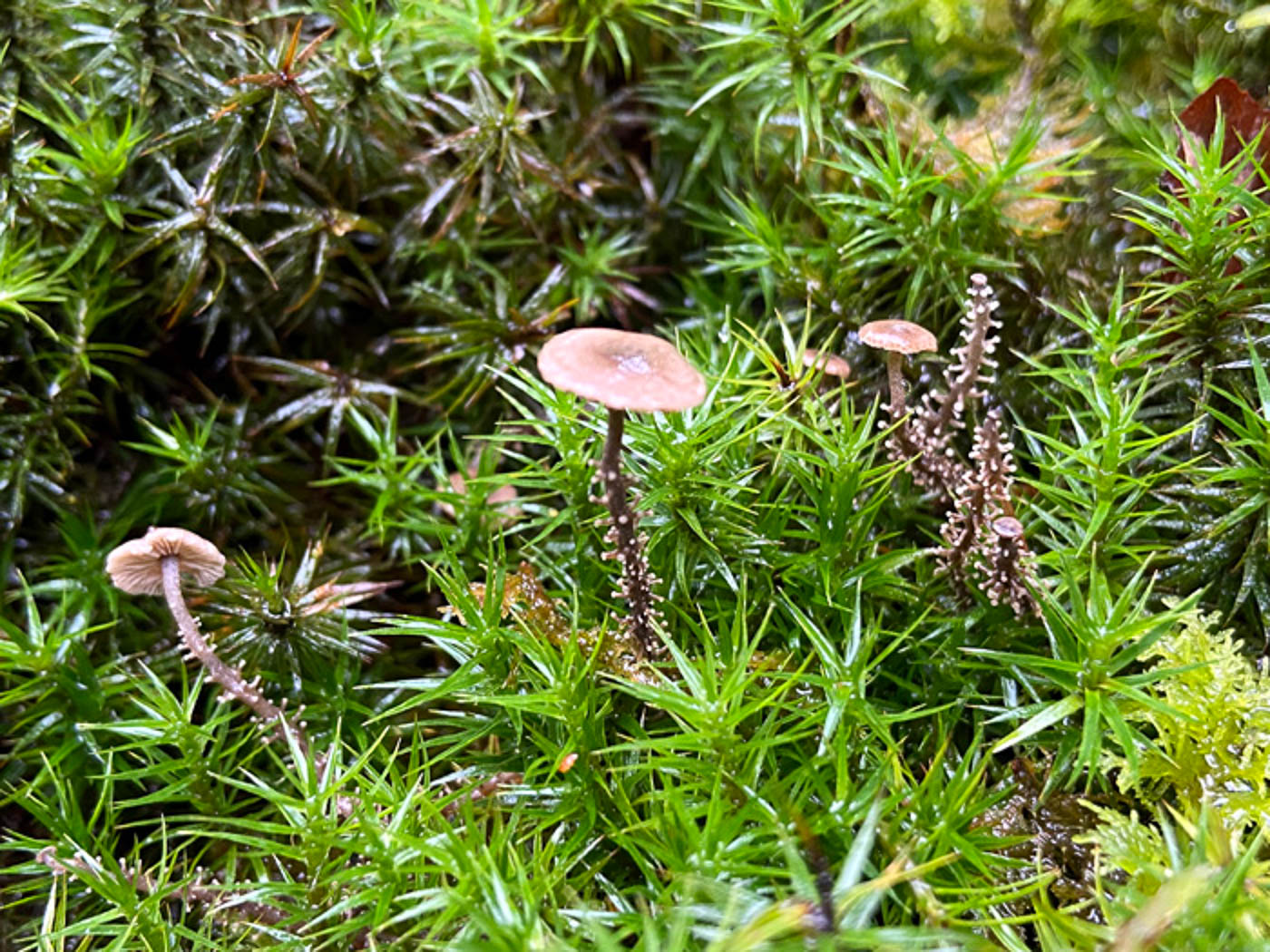
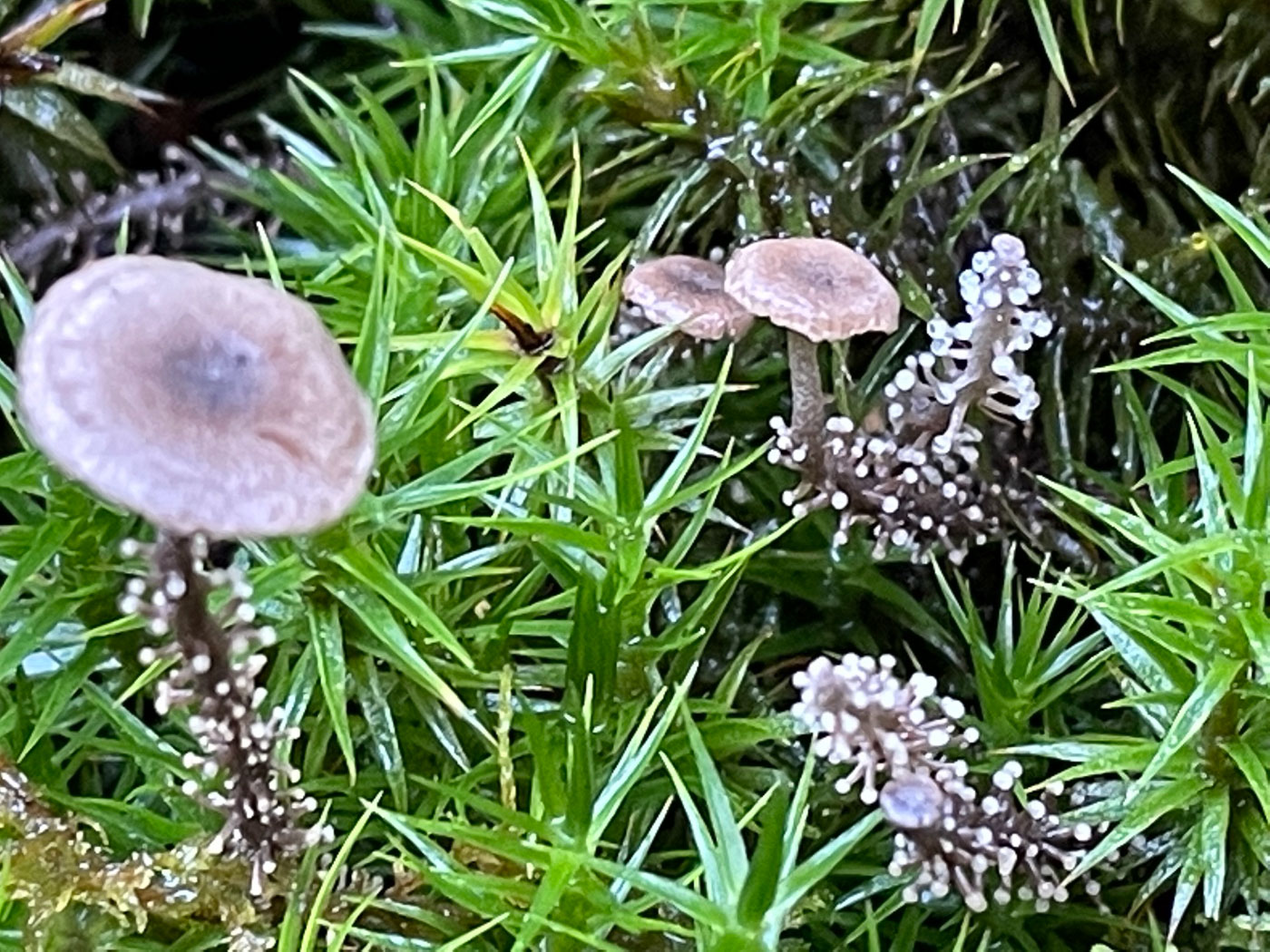
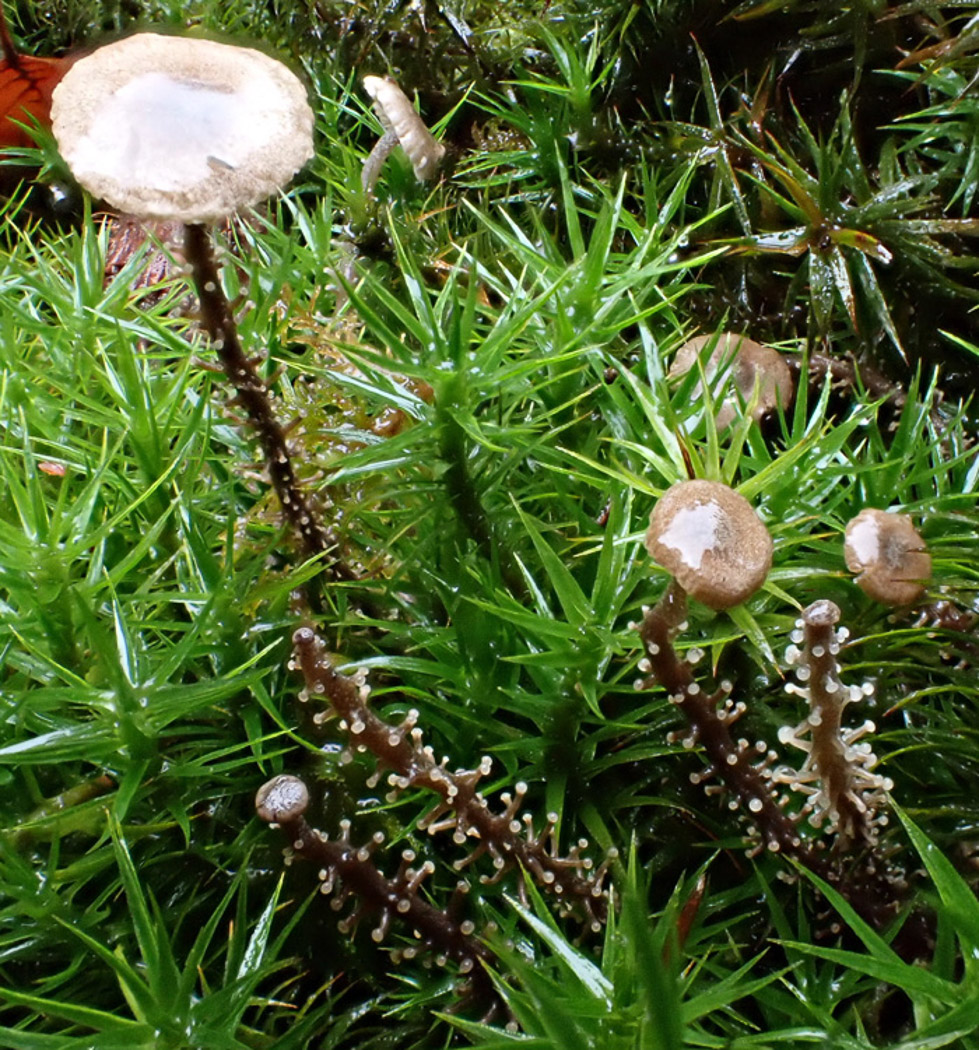
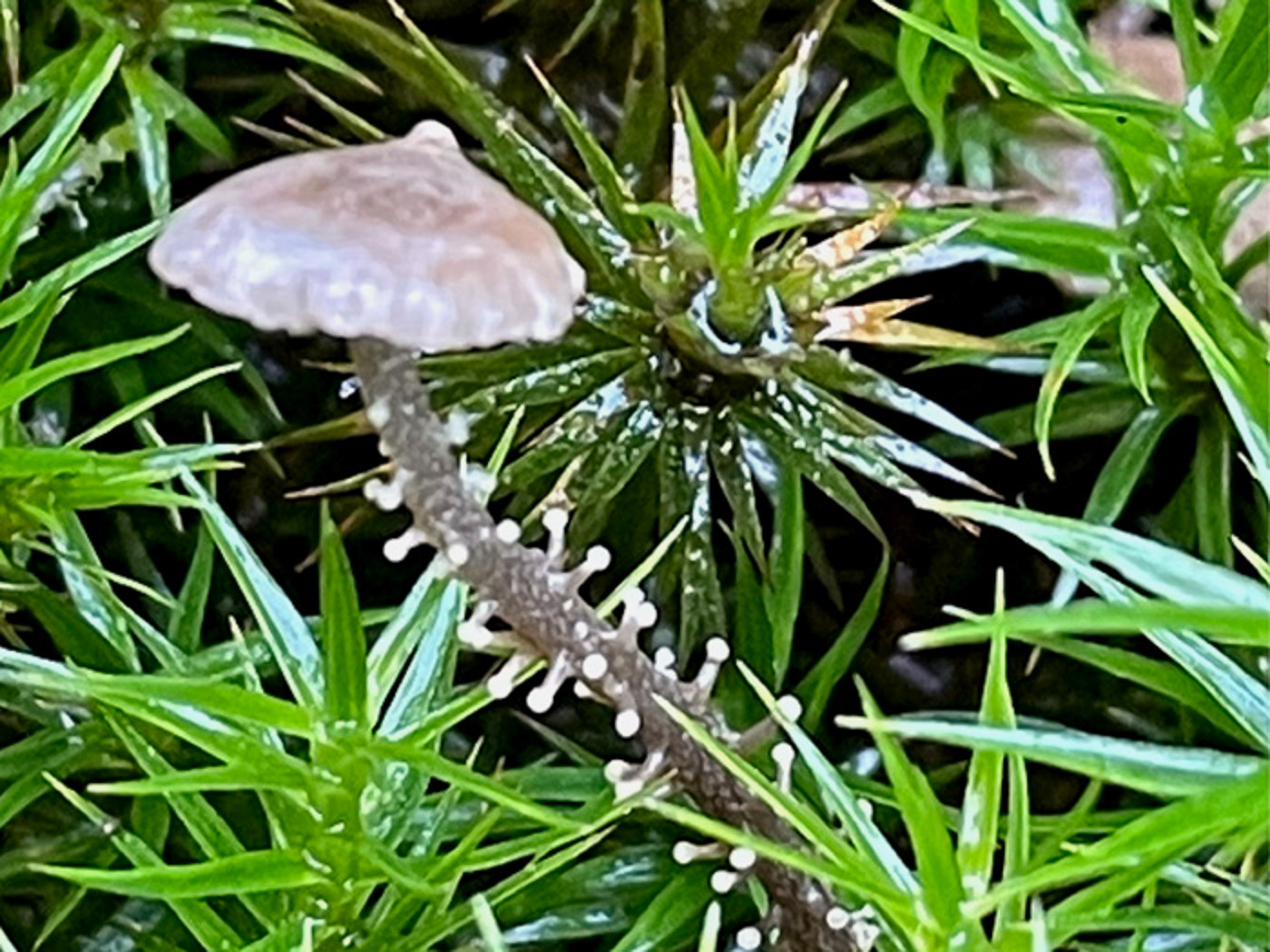 |
Dendrocollybia racemosa (Branched Shanklet) Oct 20, 2022. Penny could hardly believe her eyes when she received photos of this exceptionally rare fungus found in Lott Wood near Stokenchurch by Jackie Newcombe. Jackie then took her and Stephen Plummer to see it the next day - what a thrill! This is a species that Derek (also Geoffrey Kibby) has never seen and Penny only once when she found it in the New Forest in 2000. Once seen never forgotten: though tiny its amazing stem covered in tiny branches is utterly unique in the fungal world. It grows on the rotting remains of old fungi, reportedly Lactarius but here possibly Russula nigricans which was fruiting all around, and if you'd like to read more about it try the following link for an article published in Field Mycology in April 2006 click here. Clearly new to the county, this is definitely the find of the season! Photos 1 and 3 are Stephen's; photos 2 and 4 are Jackie's. |
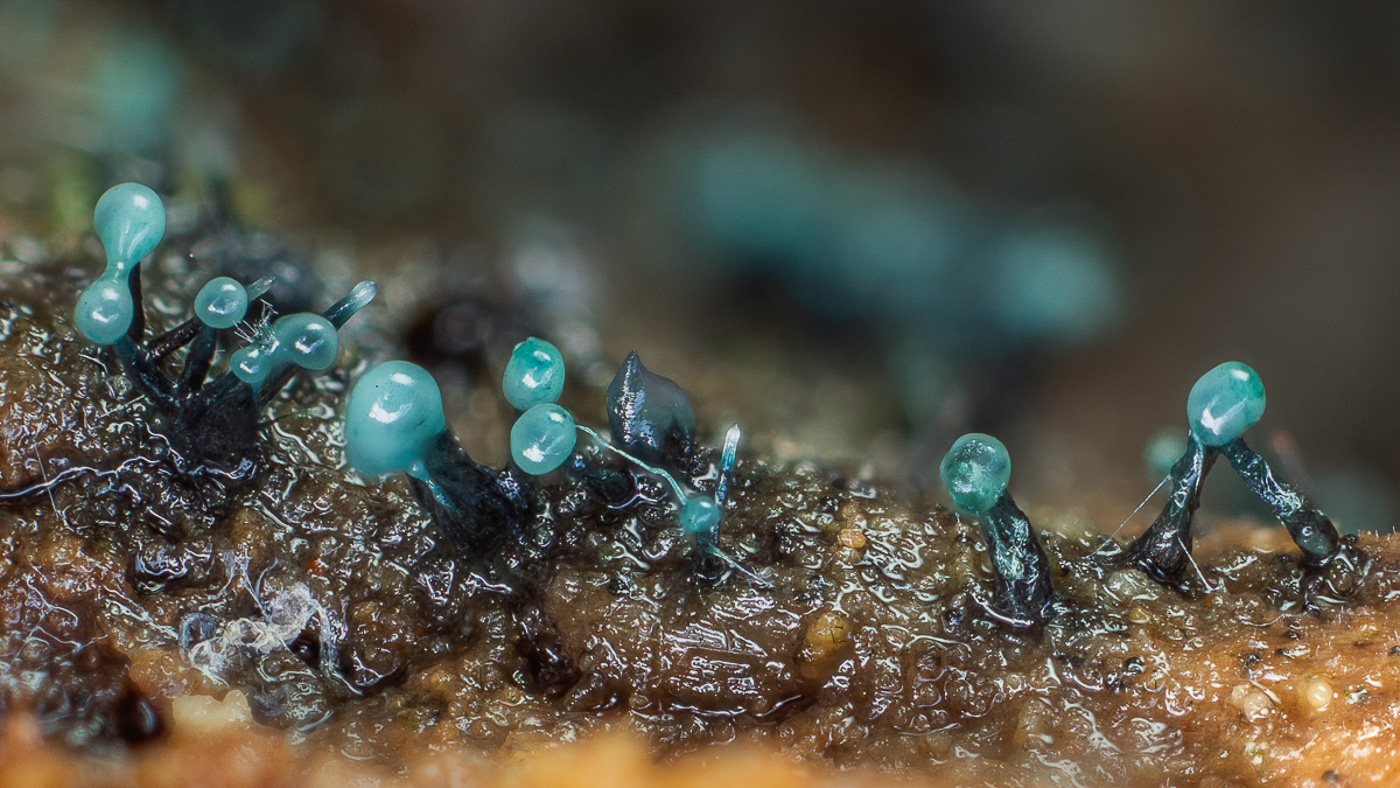 |
Dendrostilbella smaragdina (an Ascomycete with no common name) Dec 20, 2020. Barry Webb first found this tiny rare fungus in Penn Wood in 2019 when it was new to the county. Today he found it there again fruiting on fallen Larch. It is such a beautiful and striking colour for a fungus and would be easy to mistake for a slime mould but is not one despite its slimy appearance. The turquoise head is filled with 'conidia' - asexual spores, a feature common to many Ascomycetes. |
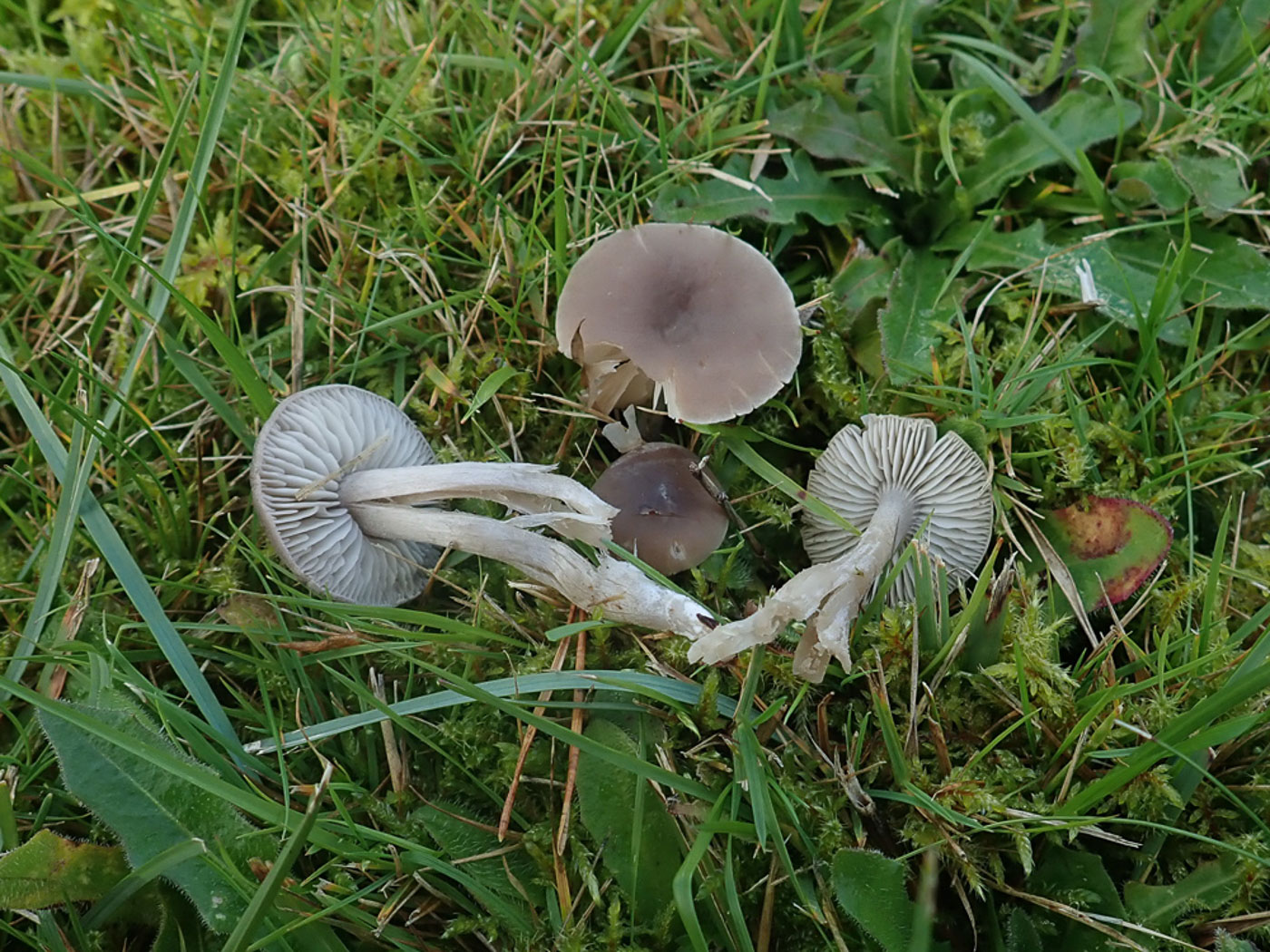 

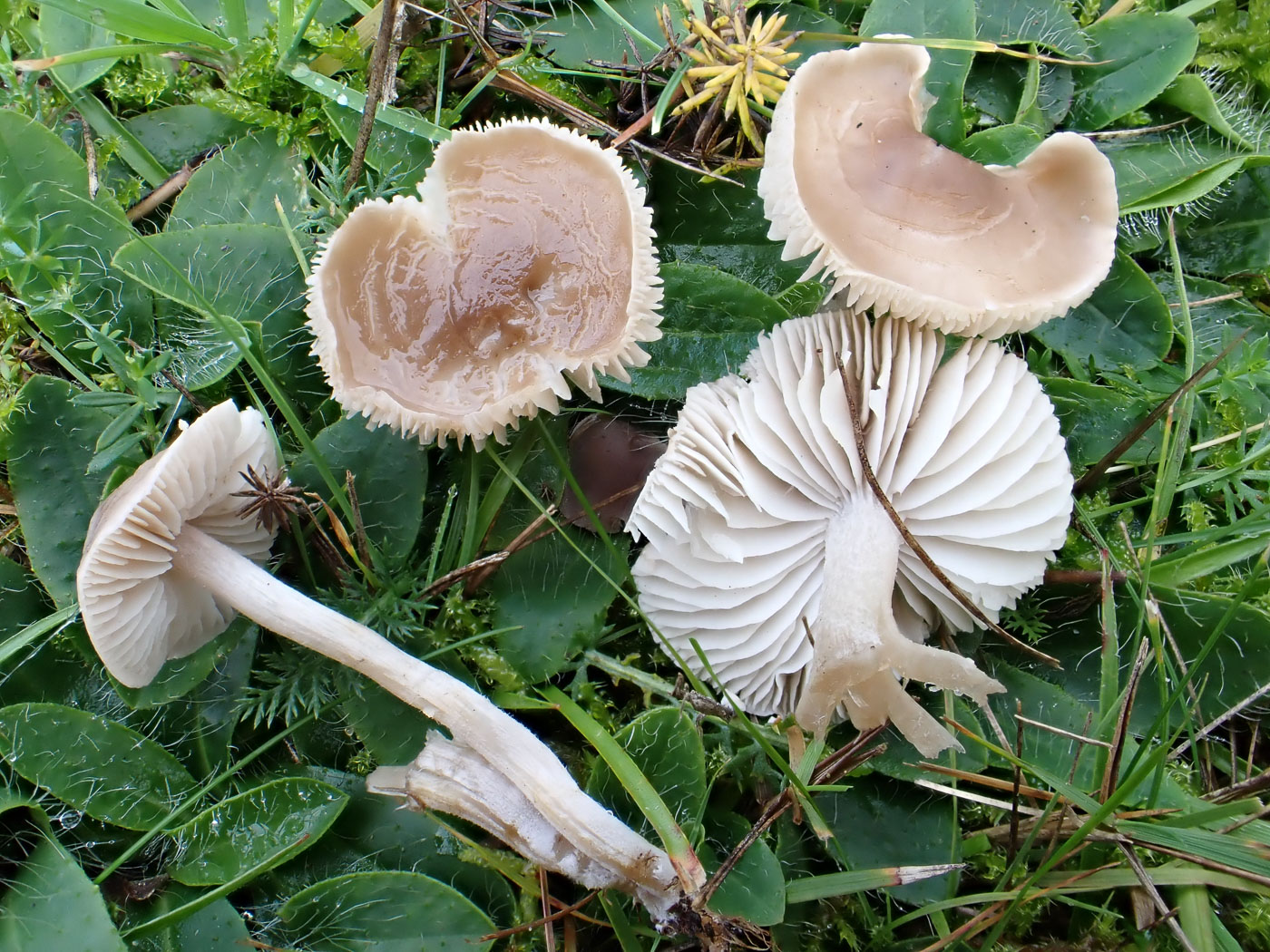
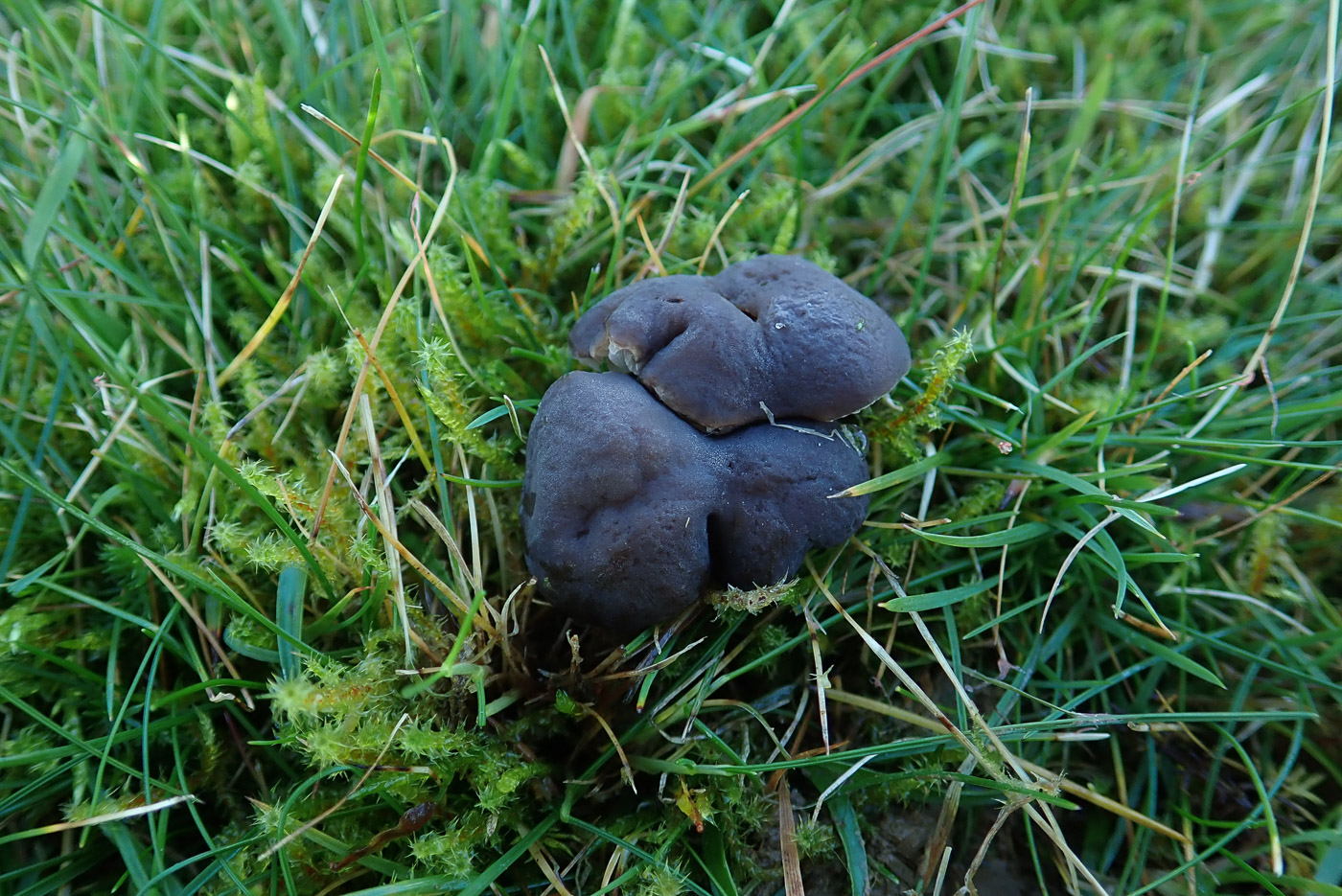
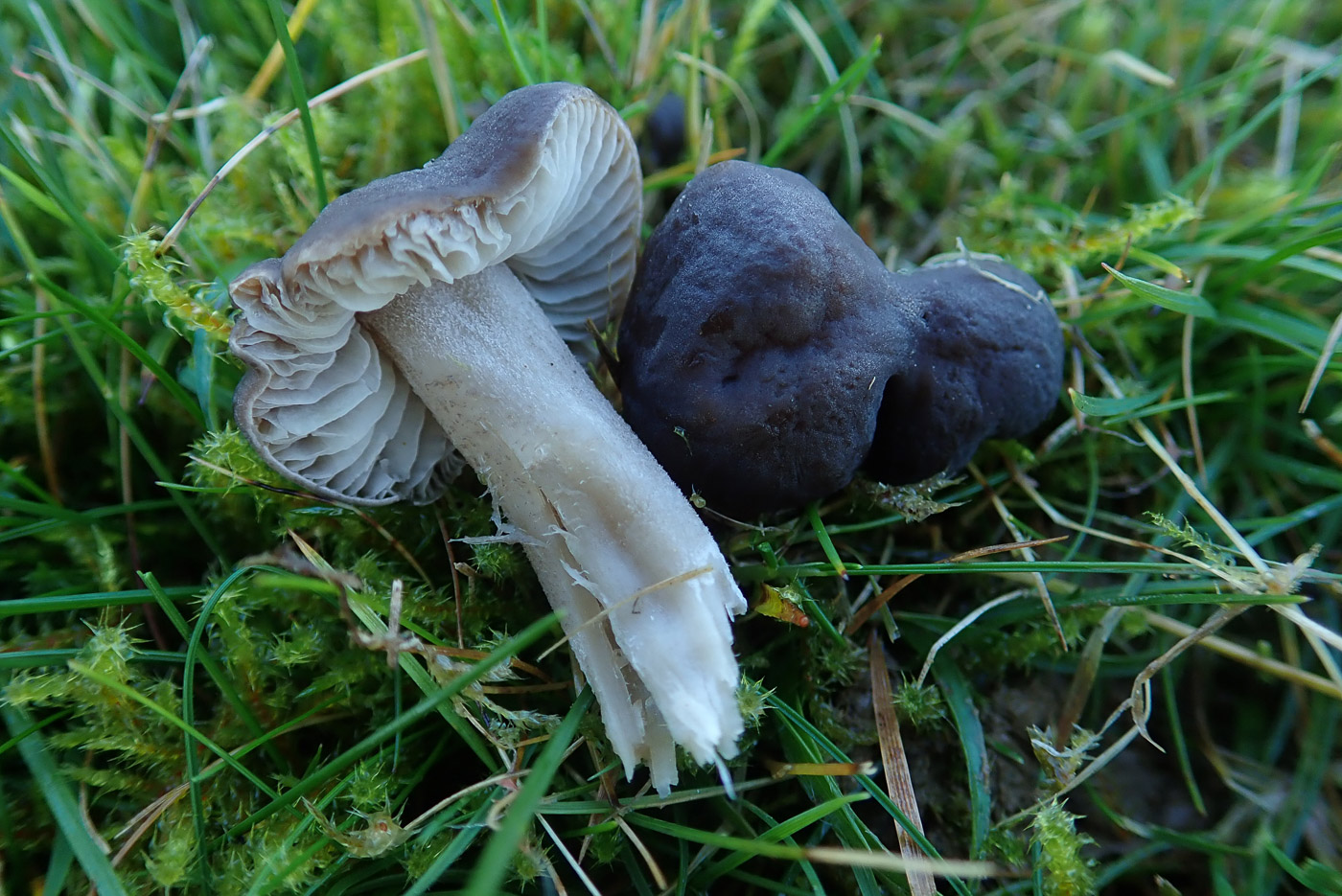
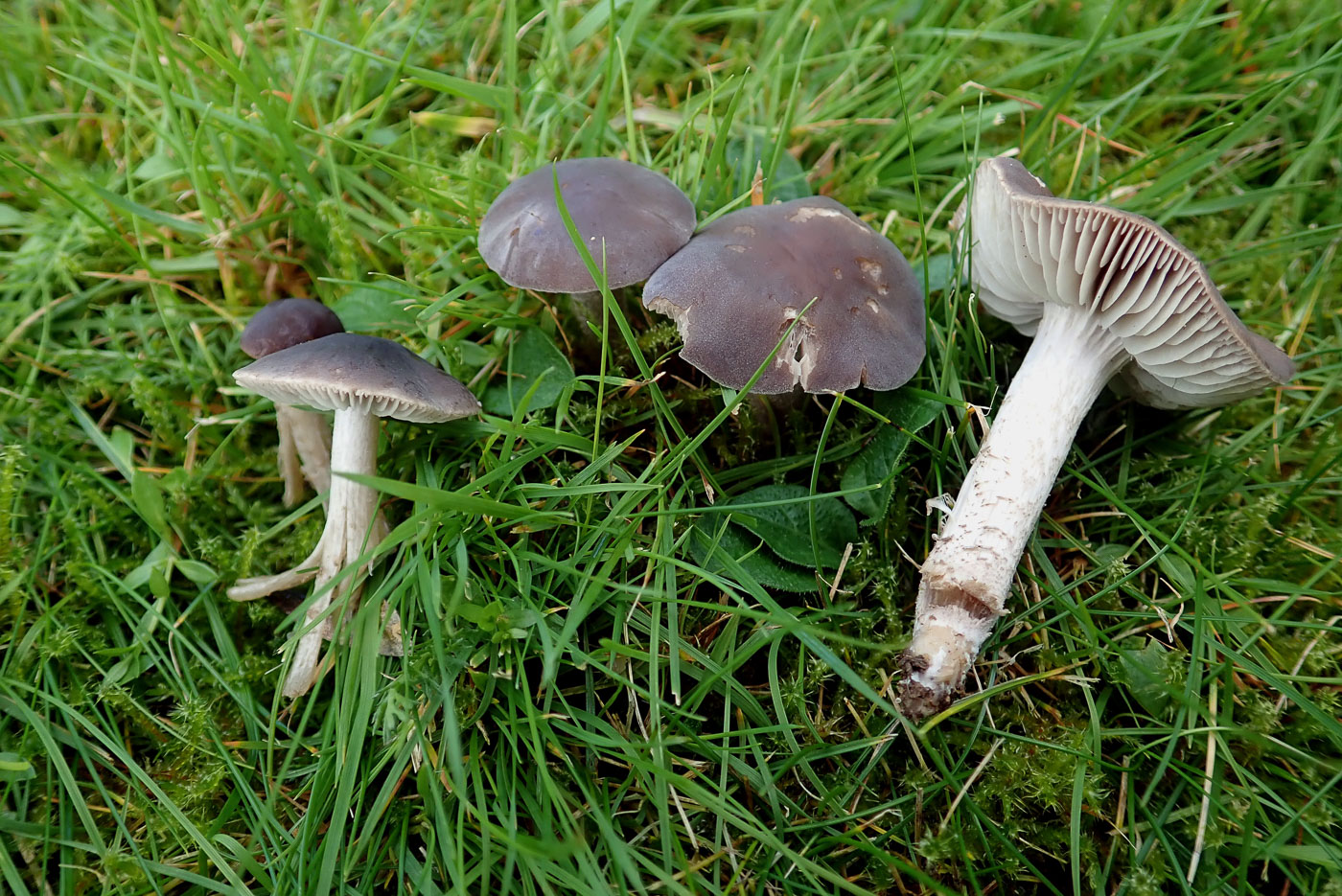
|
Dermoloma cuneifolium (Crazed Cap) Oct 7, 2024. At Prestwood Churchyard Penny found this small cluster of grey-brown little mushrooms with dry caps and pale gills; a quick sniff detected the mealy smell which confirmed the species, not at all unusual in unimproved grassland. Nov 17, 2023. At Stampwell Farm Jackie Ewan noticed these small grey-apped mushrooms growing close to some Parrot Waxcaps in a grassy area but was unsure of their identity. When Penny received the photos plus the microscopic details Jackie'd noted she was confident this was D. cuneifolium - quite a common grassland species though usually with a clear farinaceous smell which apparently was missing. Fungal smells, however, tend to be fickle later in the season especially after frost. Oct 27, 2022. In St Giles Churchyard (adjacent to Stoke Poges Memorial Gardens) our group found rather disappointingly few grassland species but this one was showing nicely. It is a fairly common small grassland nondescript dry brown-capped mushroom but the contrasting white gills and strong mealy smell are the diagnostic features. Nov 22, 2020. We have a photo of this already but from a while ago, dated Oct 07, but this twosome, found on Gt. Hampden Cricket Pitch by Penny C., looked rather different with almost black caps and not much of the characteristic obvious mealy smell in evidence. This is a common little grassland species with a dark greyish dry cap and pale gills and usually a quick check for the mealy smell is all that is needed to confirm its identity in the field. As the season progresses and frosts come into play, many species with typical smells can start to confuse, also funny things happen to waxcap colours, making life all the harder for the conscientious mycologist! Oct 7, 2020. Also on the lawn at Benhams, a private garden near Fawley, this common grassland species was found by Penny Cullington. Superficially similar to a waxcap, it has a dry cap and stem and the cap, domed and dark grey brown to start with, fades and flattens, often cracking. The gills are white and markedly convex and brittle - unlike any waxcap - and it has a strong mealy smell (of rancid flour) |
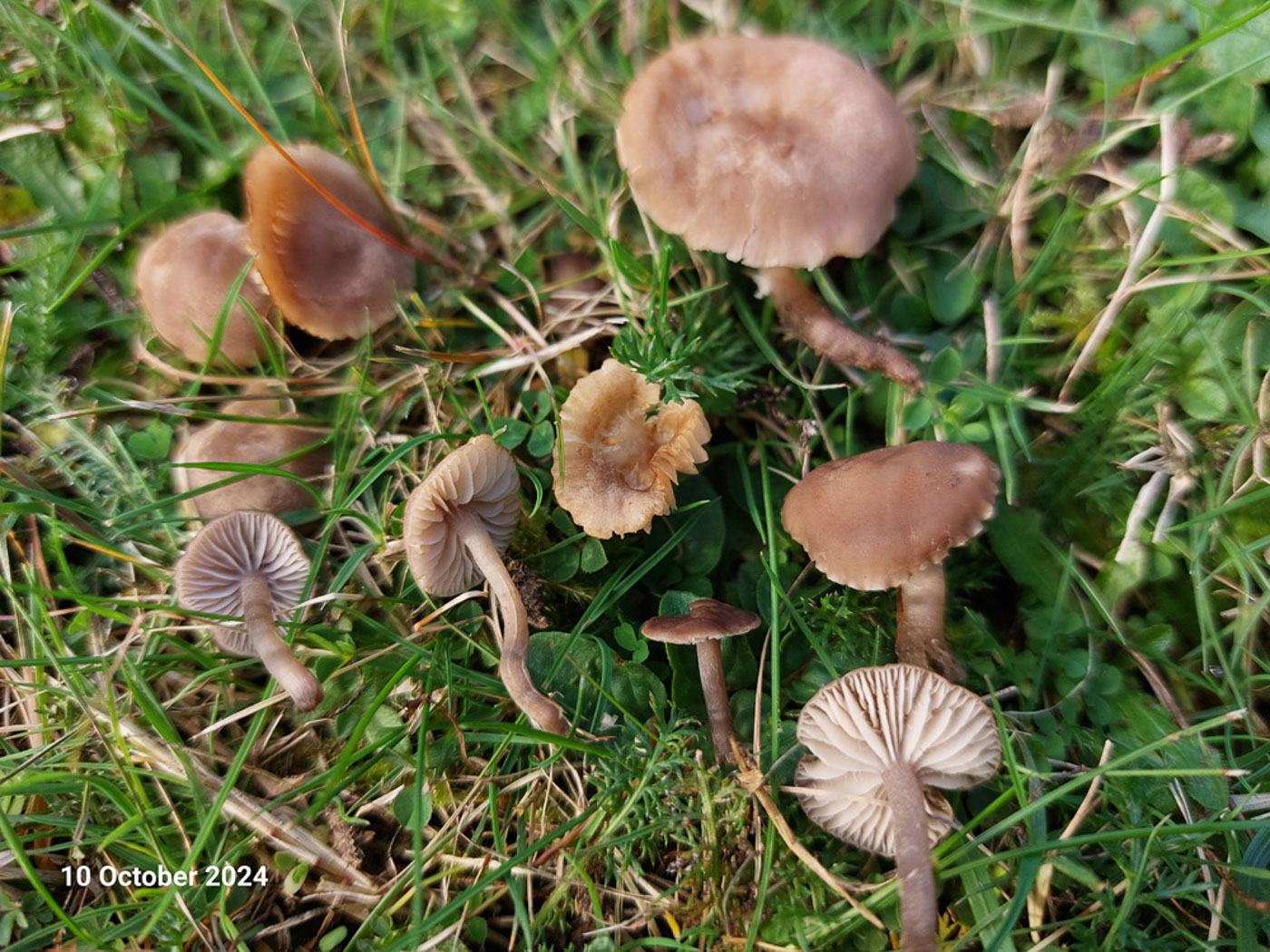 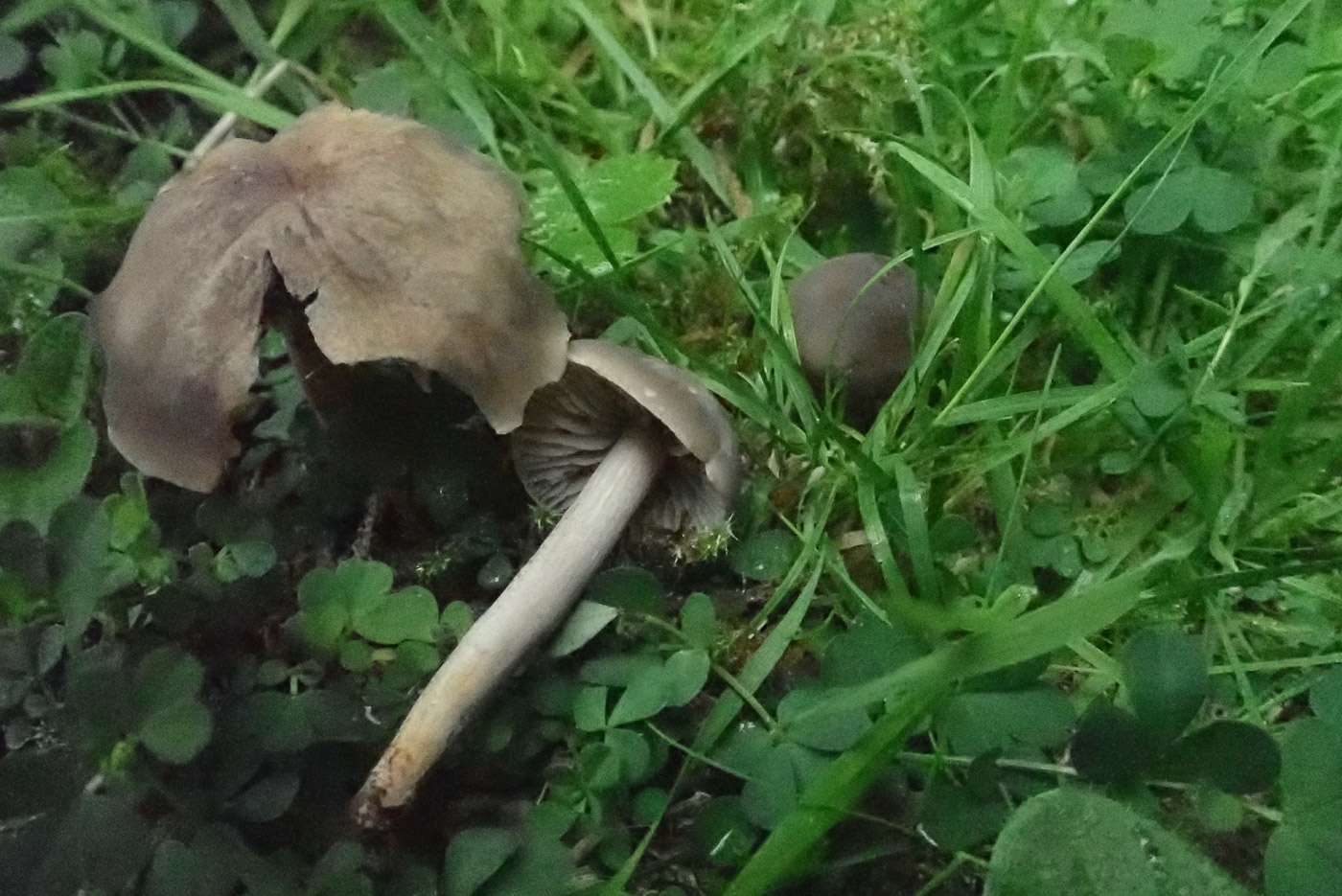
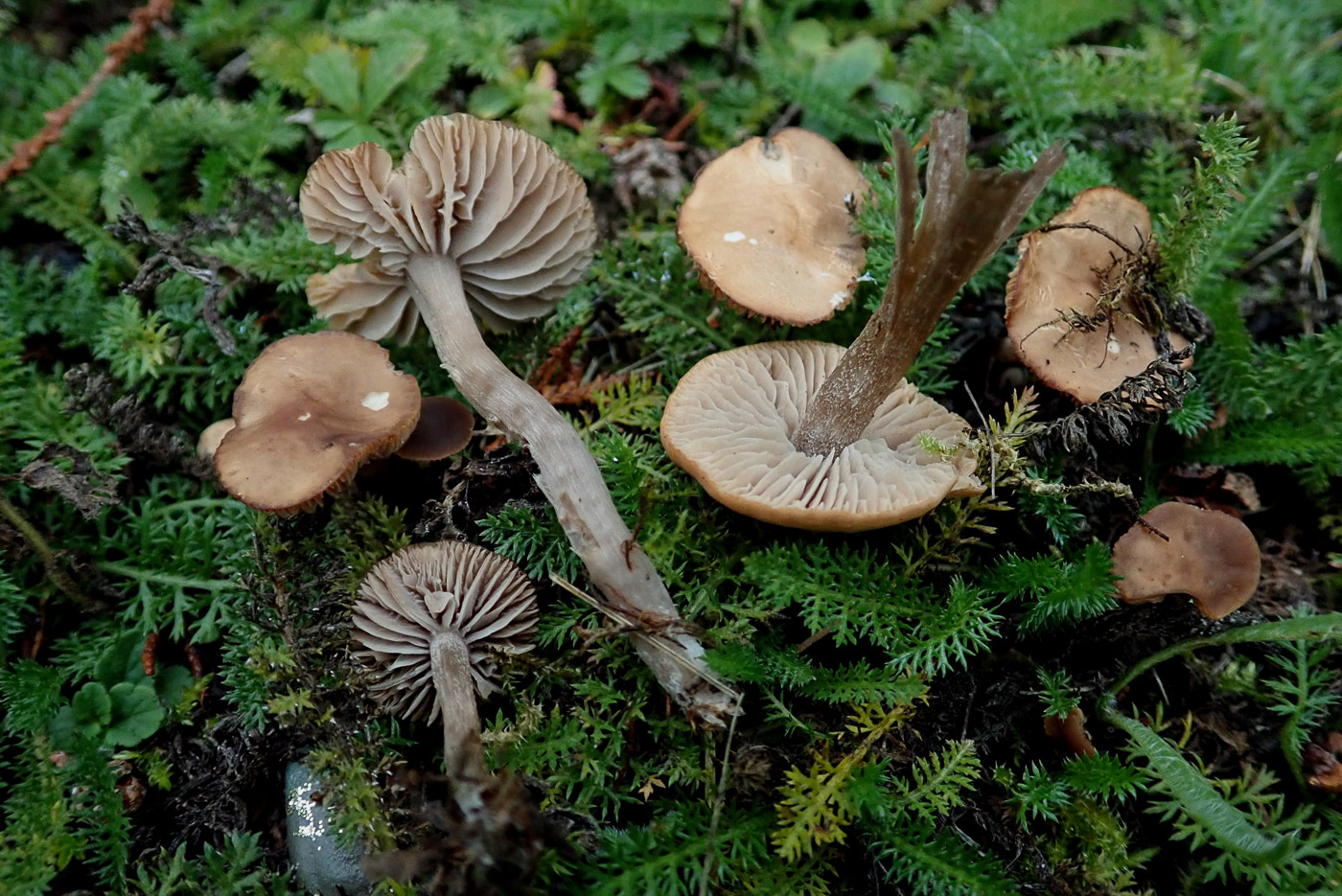
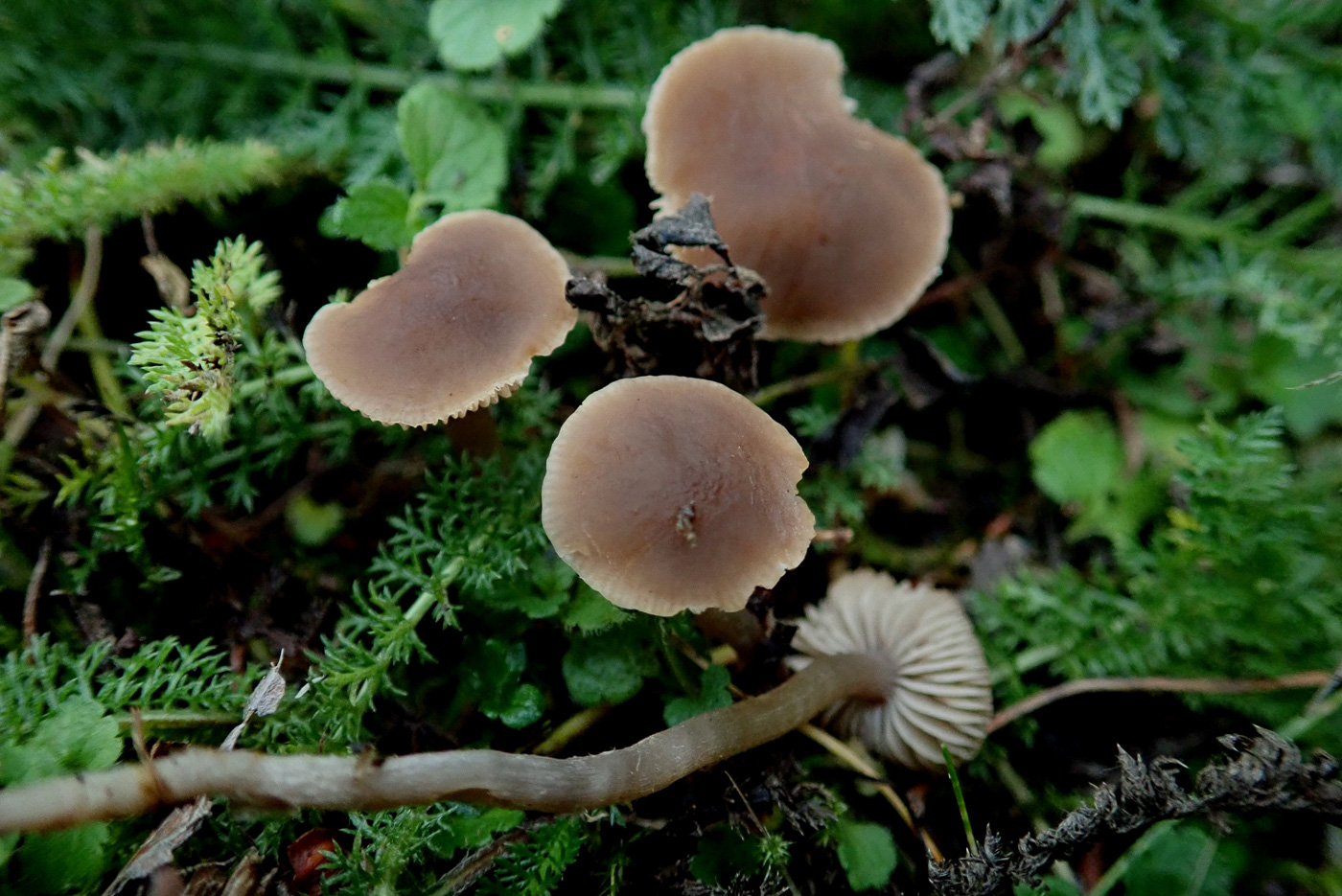
|
Dermoloma pseudocuneifolium (Dark Crazed Cap) Oct 10, 2024. In a grassy garden in Beaconsfield amongst many Parrot Waxcaps, Jesper Launder noticed this group of LBJs and suspected they were the common grassland species D. cuneifolium. Checking at home, however, he noted that the main difference between that species and this much rarer one is that D. pseudocuneifolium has mildly amyloid spores which tallied with this collection perfectly. We have just two previous county records for this species though it may well be that it is not that rare but is easily confused with the commoner species unless the spores are checked with Melzers reagent. Aug 15, 2021. In short grass in Prestwood Churchyard Penny noticed this group of LBJs and, thinking they looked like the quite common grey/brown grassland species Dermoloma cuneifolium, she picked one to test for the strong mealy smell of that species. It was absent, however. So into a pot to work on at home! Still convinced that it was that genus and remembering last November finding the rarer sister species in another local churchyard (see Finds 20 November 8th), she tried adding Melzer's reagent to a sporeprint and was rewarded with the positive blue reaction of D. pseudocuneifolium - the spores of the commoner species having a negative reaction. Today's species has longer spores and apparently often lacks the mealy smell until cut open (though mine lacked it even so). Last year's collection, confirmed with sequencing, was new to the county making today's our second record. Nov 8, 2020. In the churchyard in Princes Risborough Penny C. noticed some small unfamiliar dark brown flat caps (typical LBJs) amongst the gravestones. With them were also some much paler and slightly larger caps which looked to be a different species but this proved not to be the case - they were just very faded. On collection she noticed a familiar rancid to mealy smell reminding of Dermoloma cuneifolium (see photo dated Oct 07) but the jizz was different and the caps were clearly not grey nor rounded as in that species. At home she noticed that the spores were amyloid (turning blue in Melzers reagent) which led her via the key to D. pseudocuneifolium, a species apparently new to the county. Note in photo 1 the tiny dark cap just emerging beneath the far LH specimen, also the far RH cap in the process of fading. Photo 2 shows the unfaded dark caps. |

 |
Desarmillaria tabescens (Ringless Honey Fungus) Jul 26, 2023. At the edge of a path under deciduous trees in Bernwood Forest Jesper Launder found a couple of clumps of this unusual Honey Fungus just sprouting. Previously in genus Armillaria the species is not difficult to identify (once you've realised it's a Honey Fungus): not only is it smaller but it is alone in not having a ring on the stem. Interestingly all our records come from the south west tip of the county: Rushbeds, Whitecross Green, Shabbington Wood and today's site. See also in Finds 2020 September 28th. |


 |
Diatrype bullata (Willow Barkspot) Mar 25, 2023. Searching amongst the many Willows at Stoke Common Penny eventually found good material of this fairly common Pyrenomycete which occurs on dead attached branches of Willow, also Alder and Poplar. Very similar to some Hypoxylon species (Woodwarts) it can be recognised in the field not only by its host tree but also its rather flat shape rather than rounded and its tendency for fruiting bodies to fuse together. The species is not rare though this is our first Finds entry. |
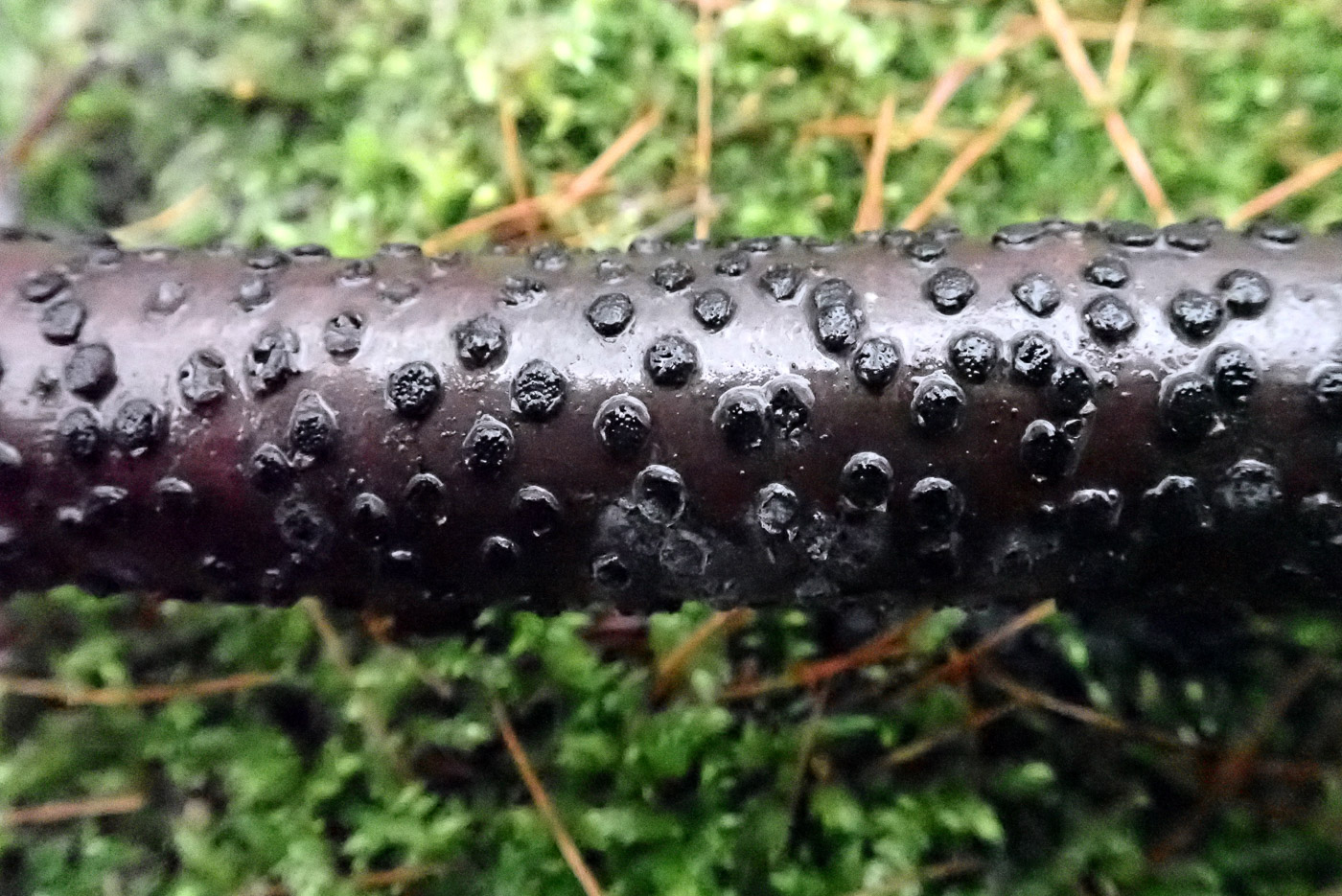 |
Diatrype disciformis (Beech Barkspot) Dec 7, 2020. This was yet another common crusty black Ascomycete species found by Penny C. in a wood pile in Penn Wood on a cold and foggy dismal day. The small round raised black blisters, only about 5mm across, could perhaps be mistaken for a species of Hypoxylon (see an example dated Sept 22) but these emerge breaking through the surface of the bark rather than grow on it. Note the tiny ostioles, found on the surface of all the Pyrenomycete species (the crusty black wood inhabiting Ascomycetes). |
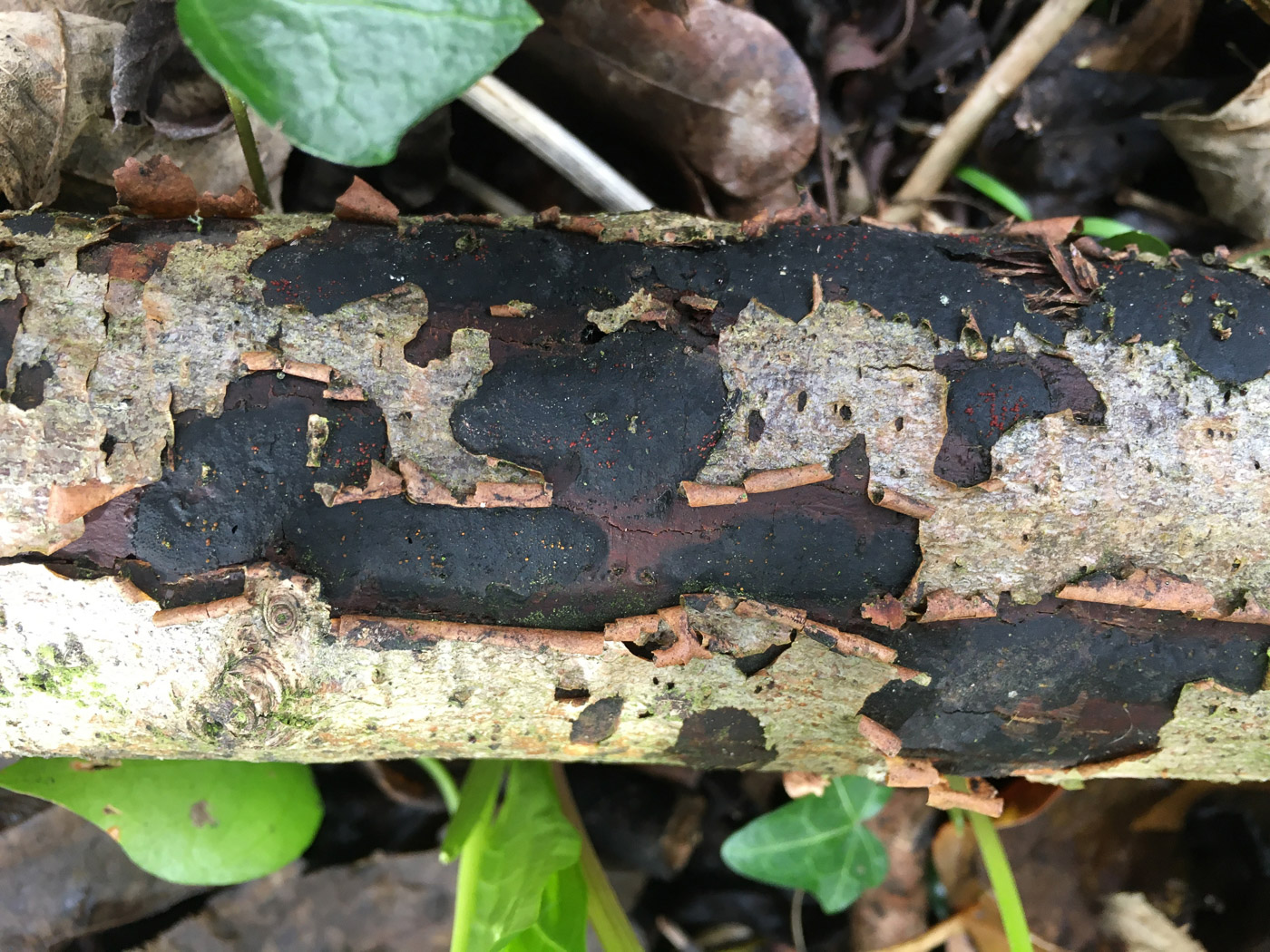
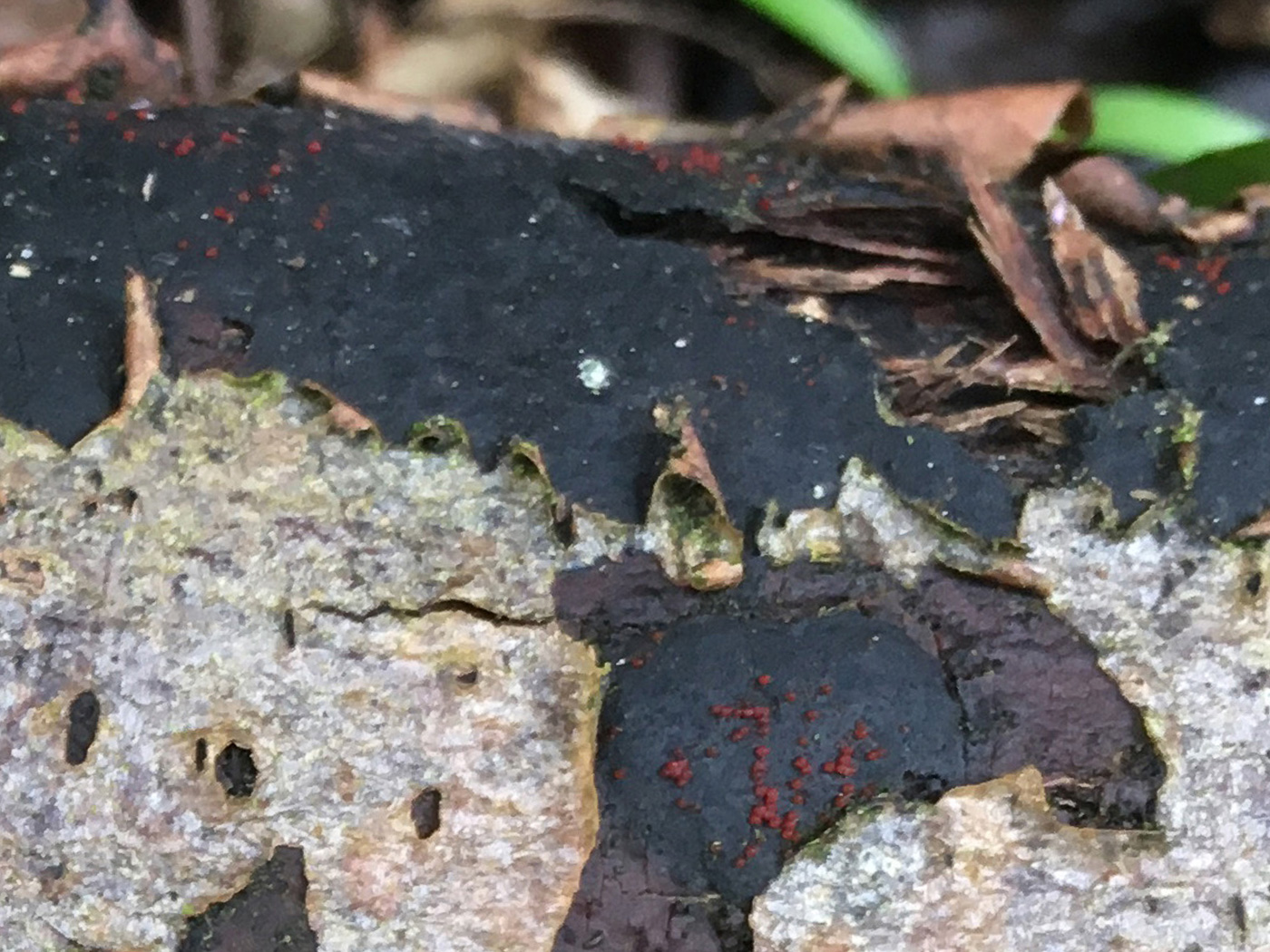
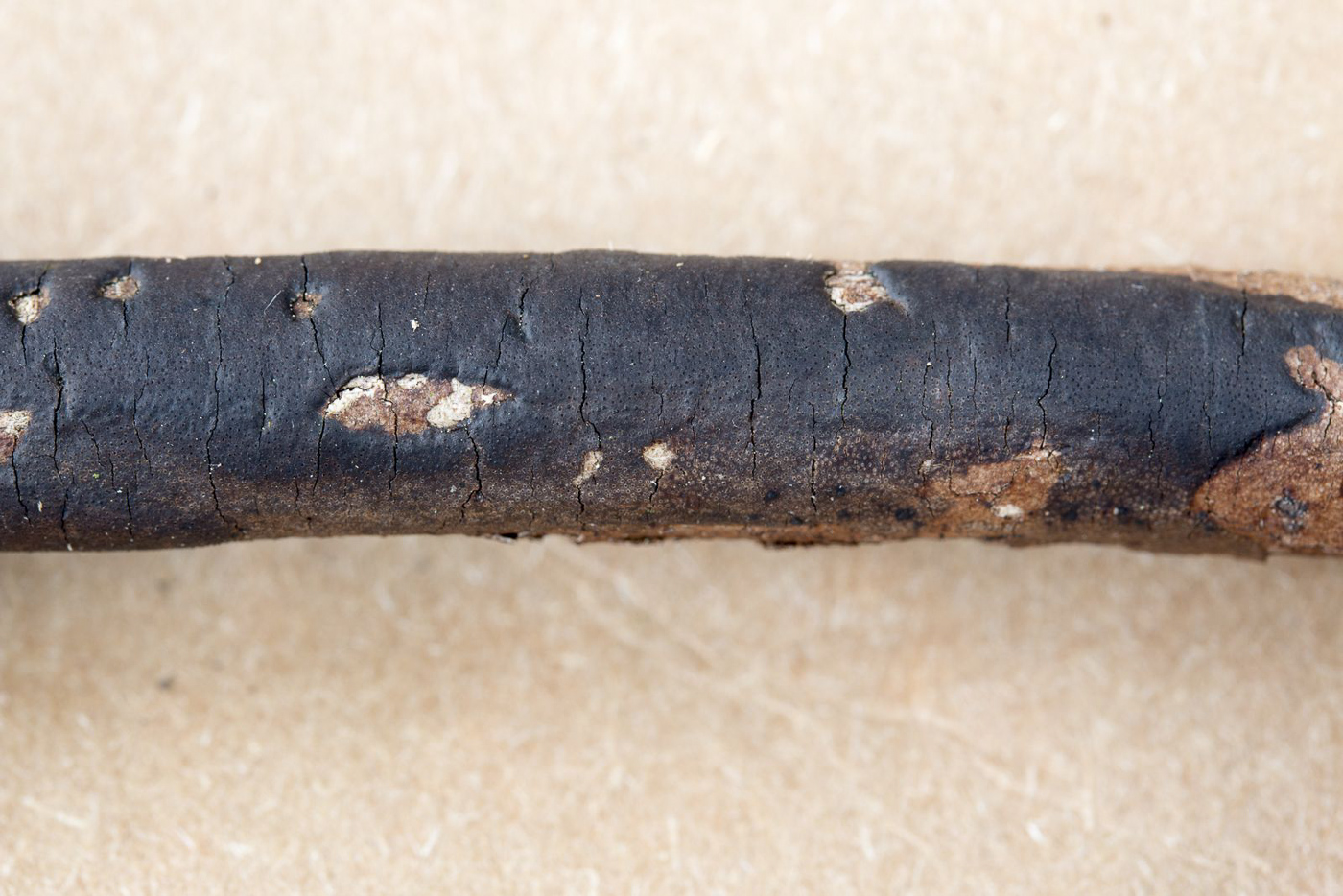
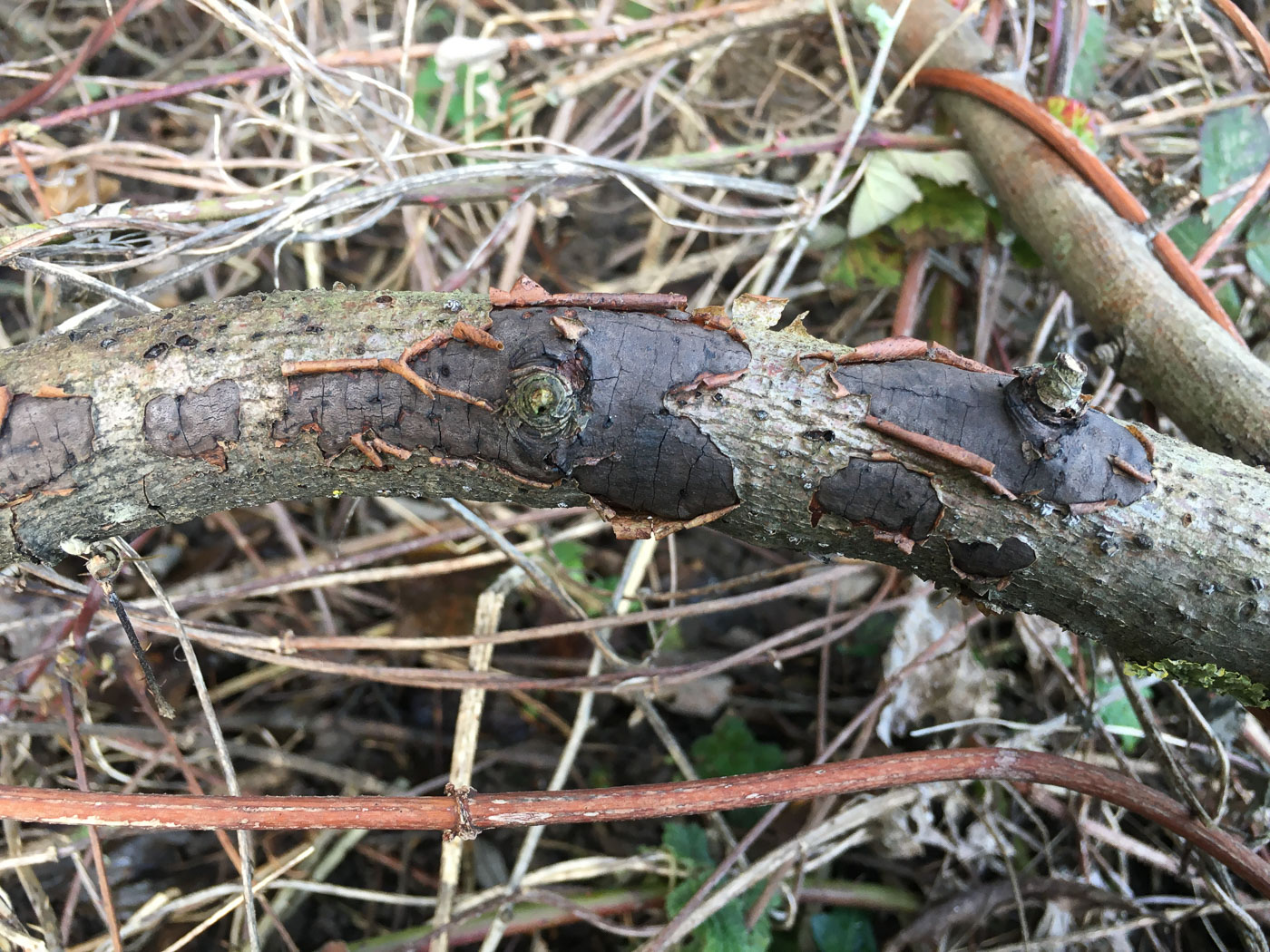
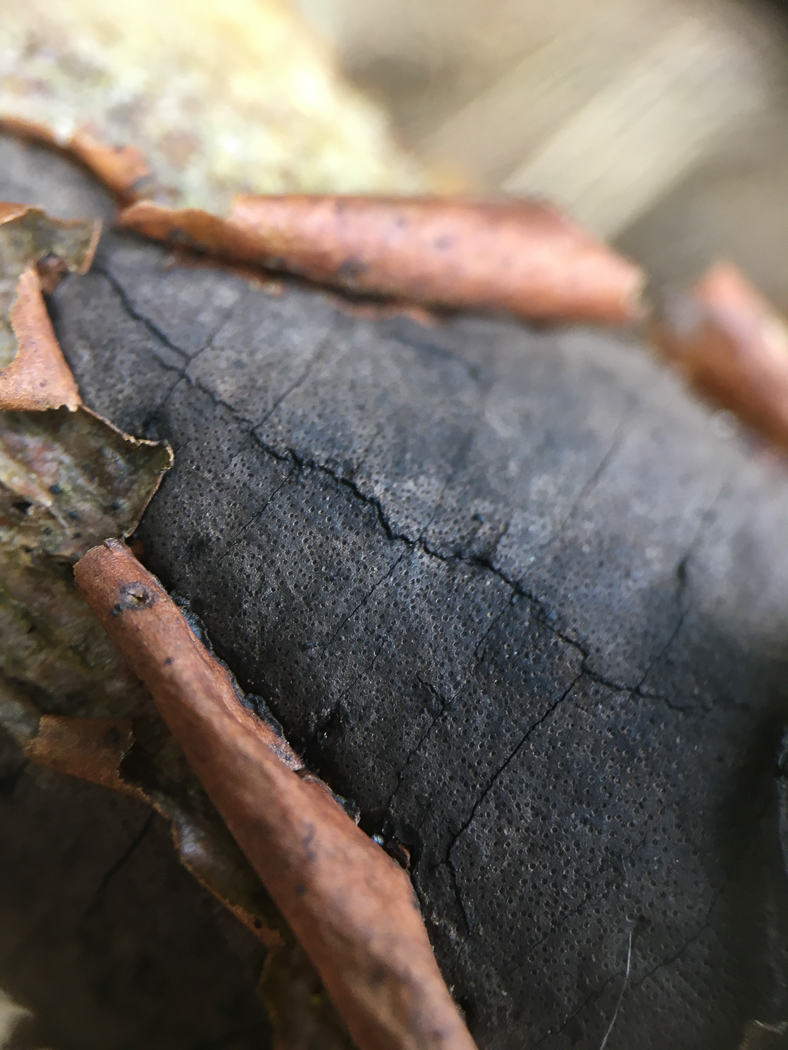 |
Diatrype stigma and Dialonectria episphaeria (Common Tarcrust and a species of Coral Spot with no common name) Feb 16, 2022. Two for the price of one here: At Tram Hill Ponds, Brill, Joanna Dodsworth noticed a Hazel stick with the tell-tale black patches of this common species - a typical member of the Pyrenomycetes (the crusty black Ascos). What she didn't notice, however, were the tiny red blobs of Dialonectria episphaeria (previously in genus Nectria) liberally adorning it and visible with close inspection (photo 2)! This Tarcrust can form large expanses on barkless fallen deciduous wood, commonly Beech, and this particular Coral Spot - another Asco - can (with a hand lens) quite often be found on it. There are many different species of Nectria - a parasitic genus now being split up - the most familiar being N. cinnabarina (Coral Spot) which often forms large swarms of fallen deciduous sticks. Several species are only found on other fungi, particularly on Pyrenomycetes of various kinds, and today's species favours Diatrype stigma. May 13, 2021. Claudi Soler found this common crusty ascomycete on a Beech log at Dancersend. It often forms large sheets on fallen Beech still with bark, and a closer look reveals the tiny ostioles - slightly raised holes - which cover the surface and through which the spores are expelled. Jan 3, 2021. Russell Ness found this species of Pyrenomycete (i.e. a crusty black Ascomycete) on an unidentified deciduous fallen branch near Dorney Reach. Commonly occurring in large smooth patches on fallen Beech trunks, it is less usual on other deciduous wood as here (there was apparently no Beech in the area). This was not a species we included in Finds 2020 - not because it wasn't seen but probably because we were spoilt for choice with so much else to catch the eye. |
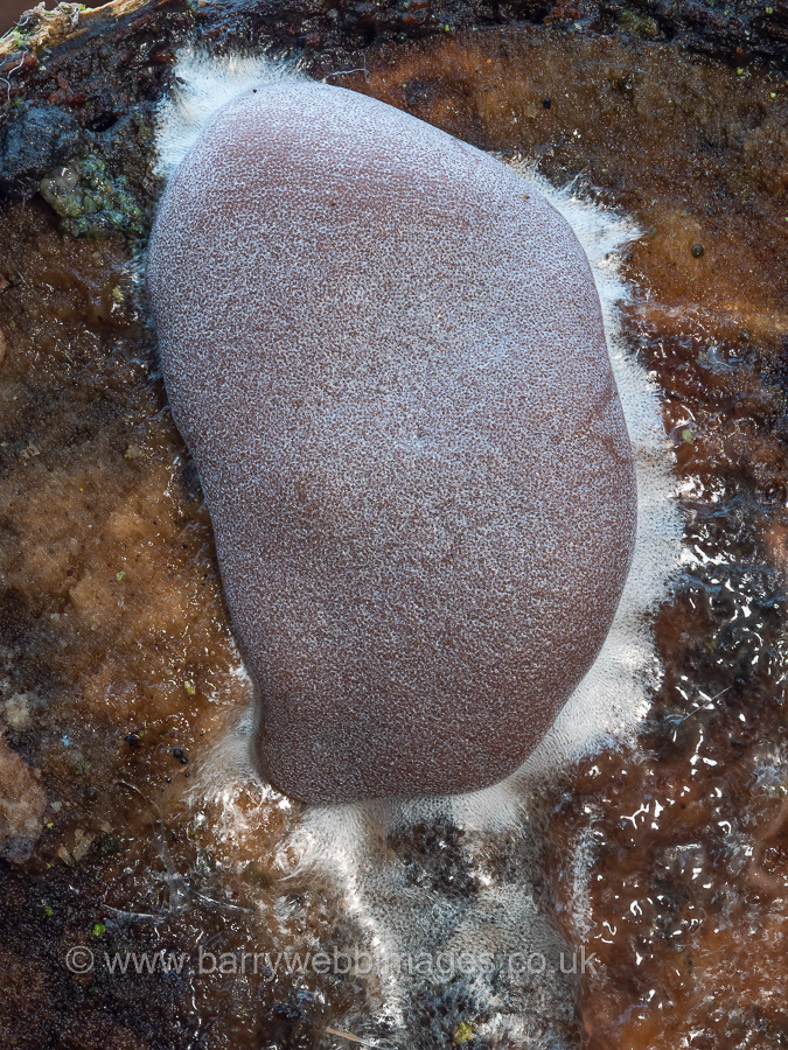
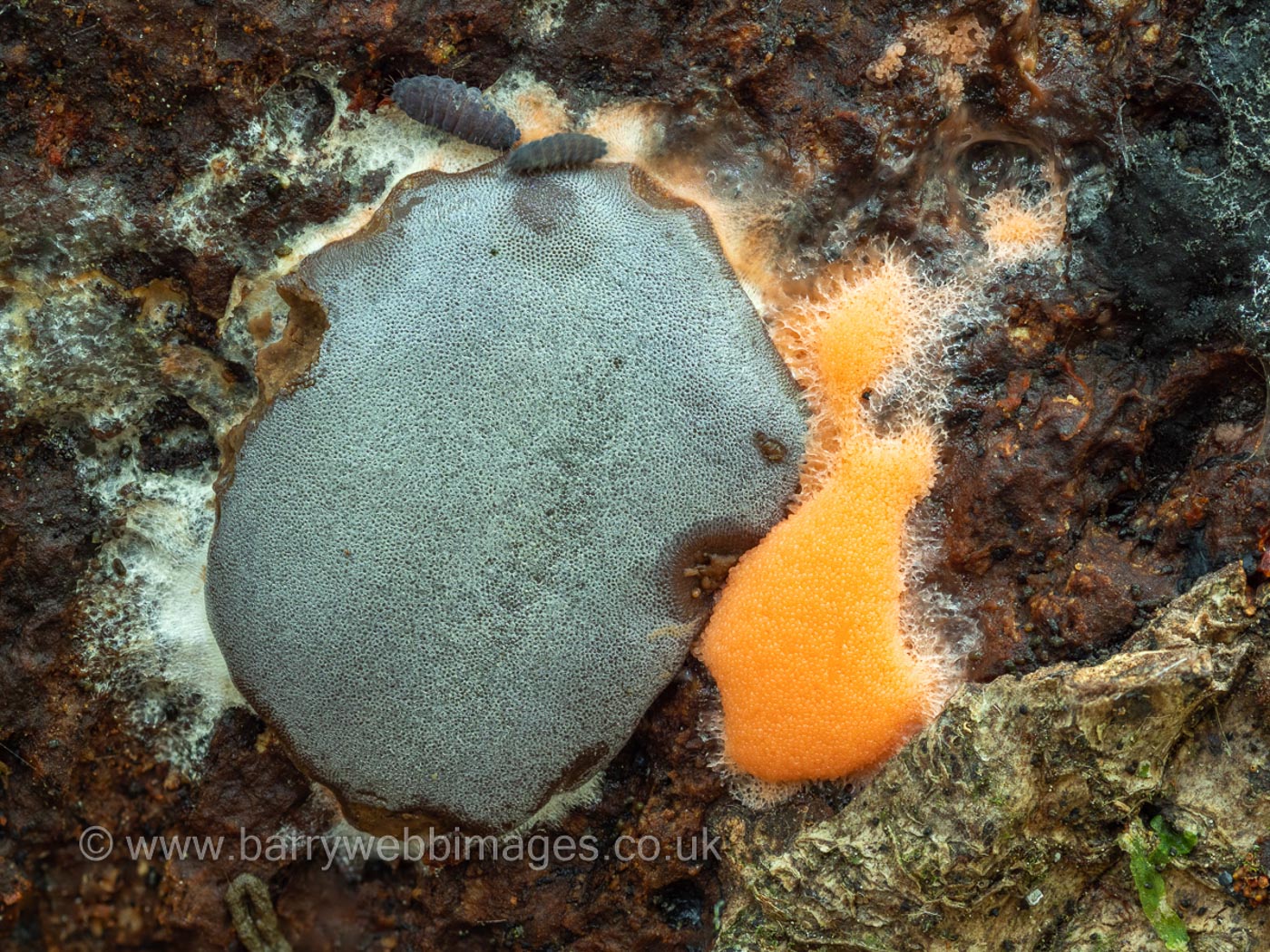 |
Dictydiaethalium plumbeum (a slime Mould with no common name) Dec 30, 2021. On the same Birch pile in Hodgemoor Woods Barry and Gill Webb also found this species though it is more commonly found on fallen Beech. For more notes and another image see Barry's separate page in Members' Finds. Jun 23, 2021. On fallen Beech at Burnham Beeches Barry Webb found this unusual slime mould, one which is new to the site and with just two previous county records. It is a species with bright pink to orange plasmodium (seen here) which turns first grey (hence its Latin species name) then yellow-brown and forms flattened patches on rotting deciduous wood up to 5 cm long x 1 cm thick. At the plasmodium stage it would be possible to mistake it for the common Tubifera ferruginosa (also bright pink orange) if one was not aware of the identity of the host wood. Today's species occurs on rotting deciduous wood, especially Beech; T. ferruginosa occurs on rotting conifer (occasionally on alder or Birch) |
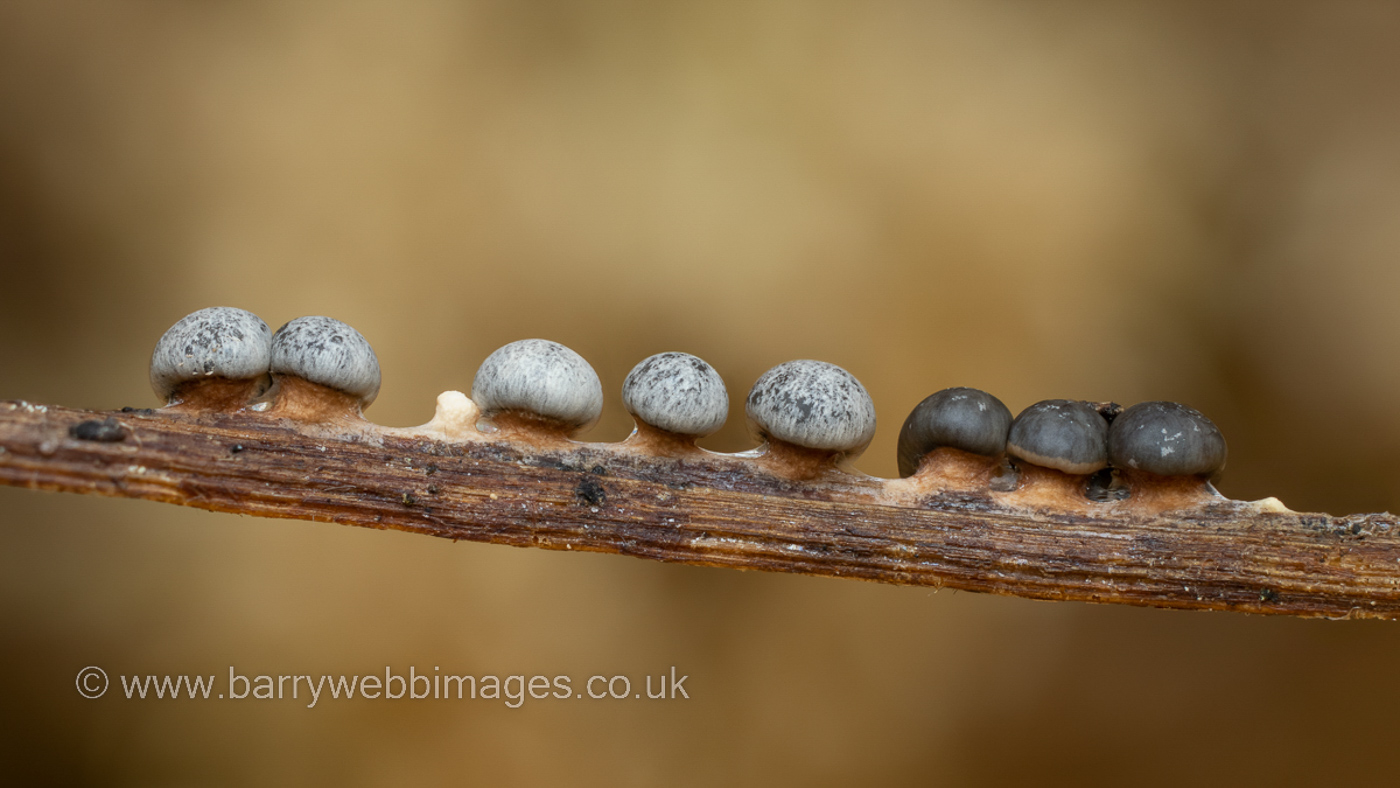
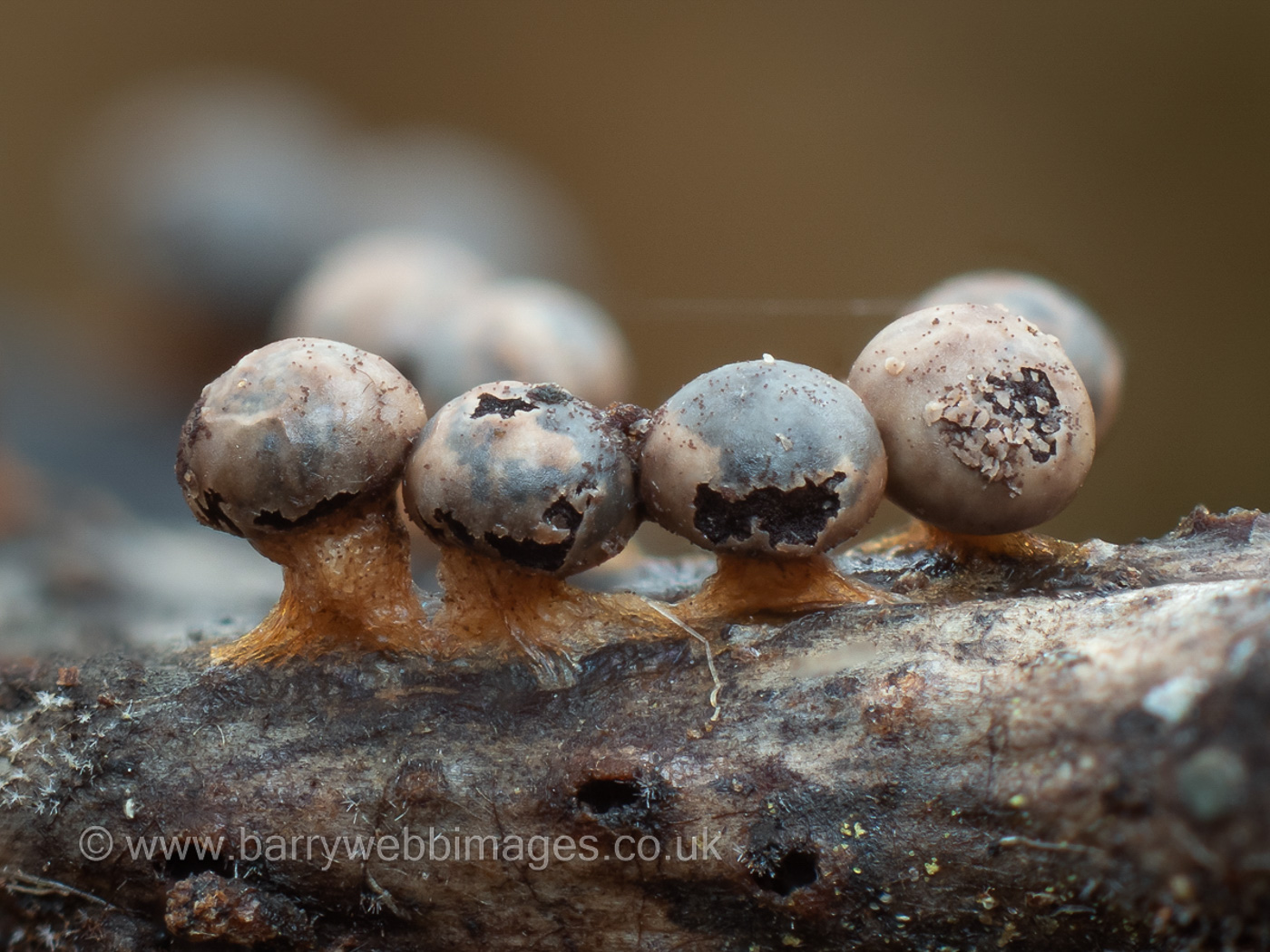 |
Diderma umbilicatum (a Slime Mould with no common name) Nov 30, 2022. At Burnham Beeches Barry Webb found this unusual Slime mould on twigs in deciduous leaf litter, a species that was new to the county when he found it at Hodgemoor Woods earlier this year The short stout stalk help to make it recognisable in the field. Jan 6, 2022. In Hodgemoor Woods Barry Webb found this species - not rare but still new to the county - on an oak twig in leaf litter. Diderma is a large genus of 70 odd species characterised by their crusty coating of lime crystals. Today's species is quite large for a slime mould - up to 1.3 mm across(!) - with pale shiny heads and a thick short orange umbilicate stalk beneath. (For more examples of the genus go to Barry's separate page on Finds.) |
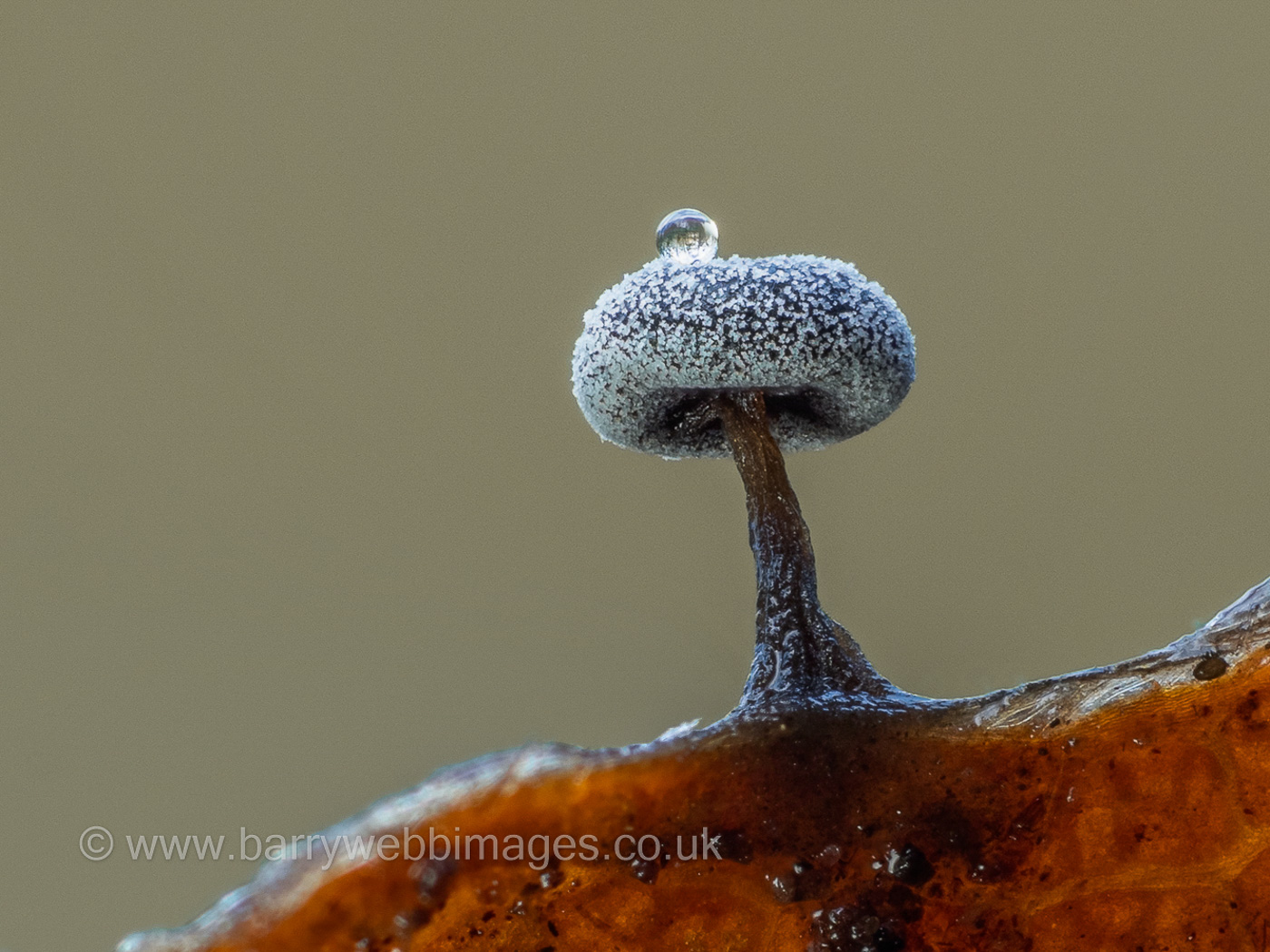 |
Didymium clavus (a slime mould with no common name) Dec 30, 2020. Barry Webb found this tiny specimen in deciduous leaf litter in Burnham Beeches. It is new to the site and also to the county, and the determination was confirmed by Edvin Johannesen from Barry's photo. Compare with photos of other Didymium species on finds 2020 to see the typical features of the genus. |
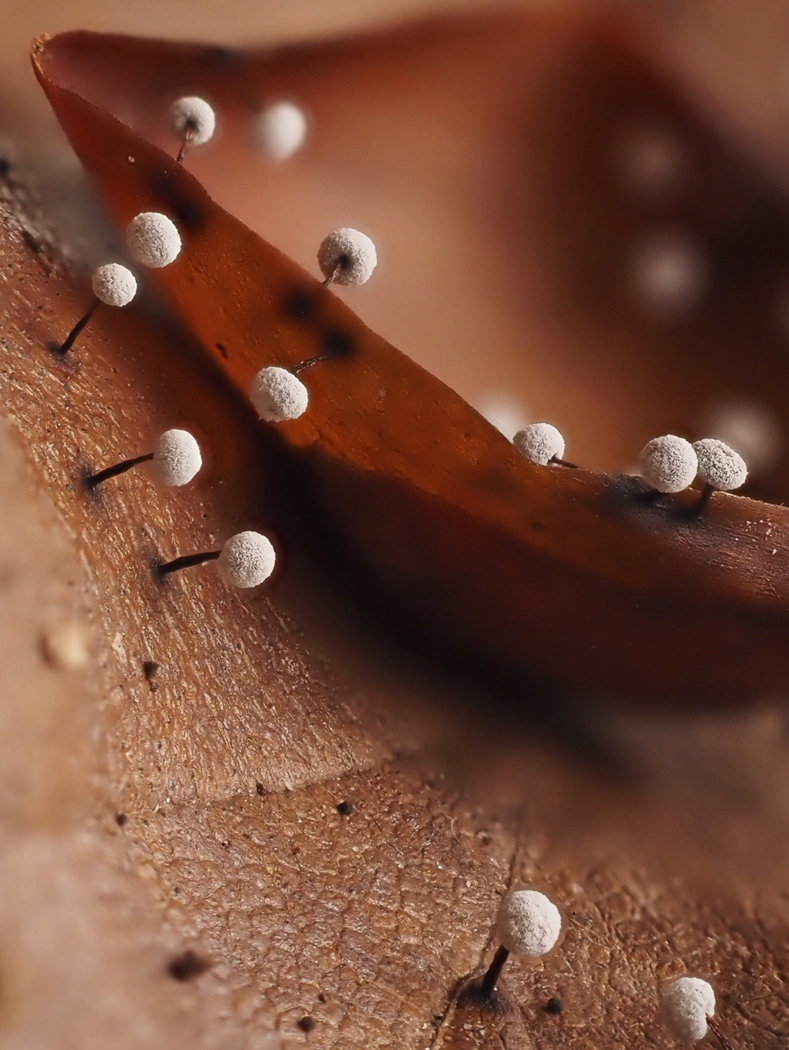
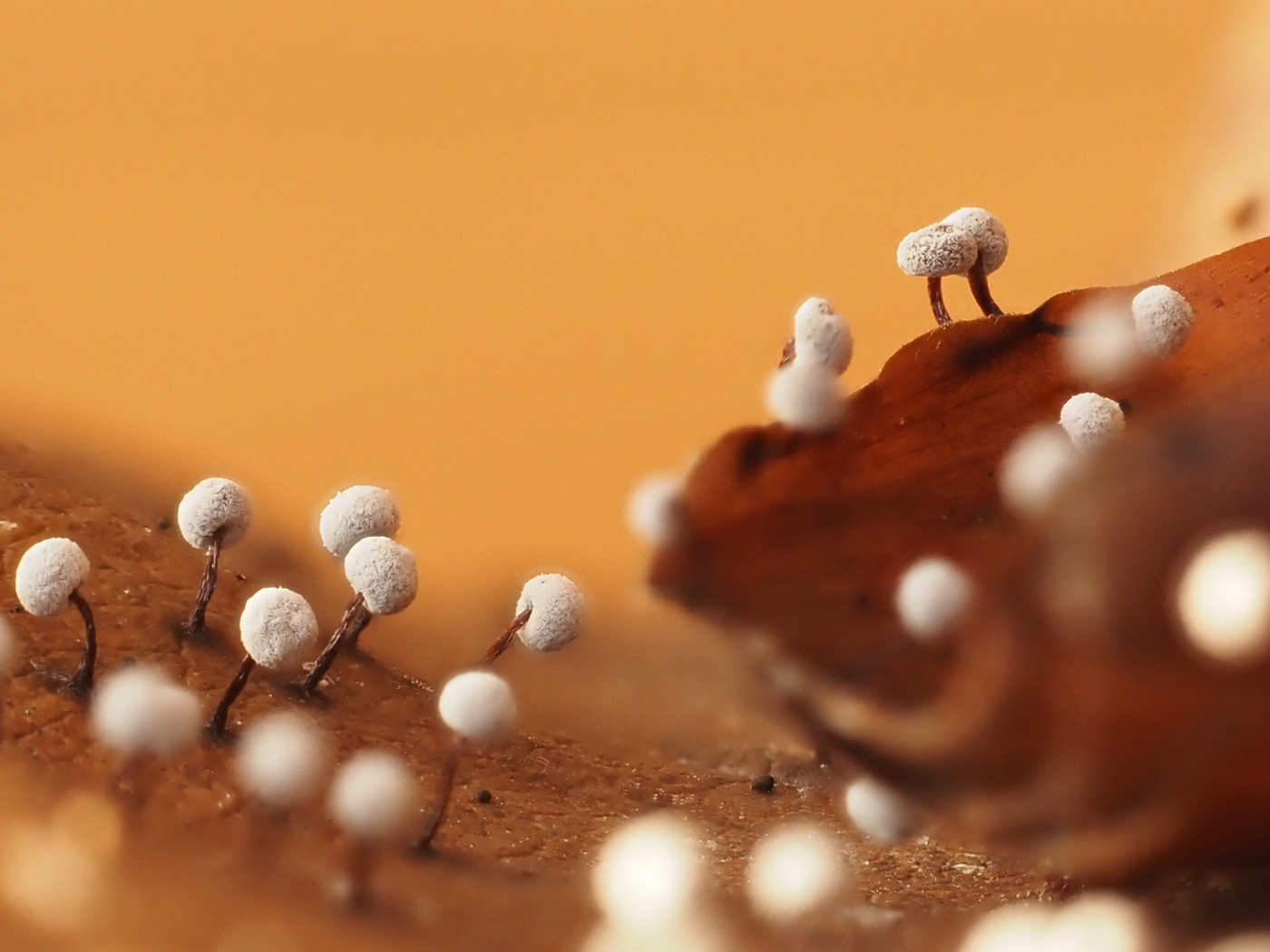
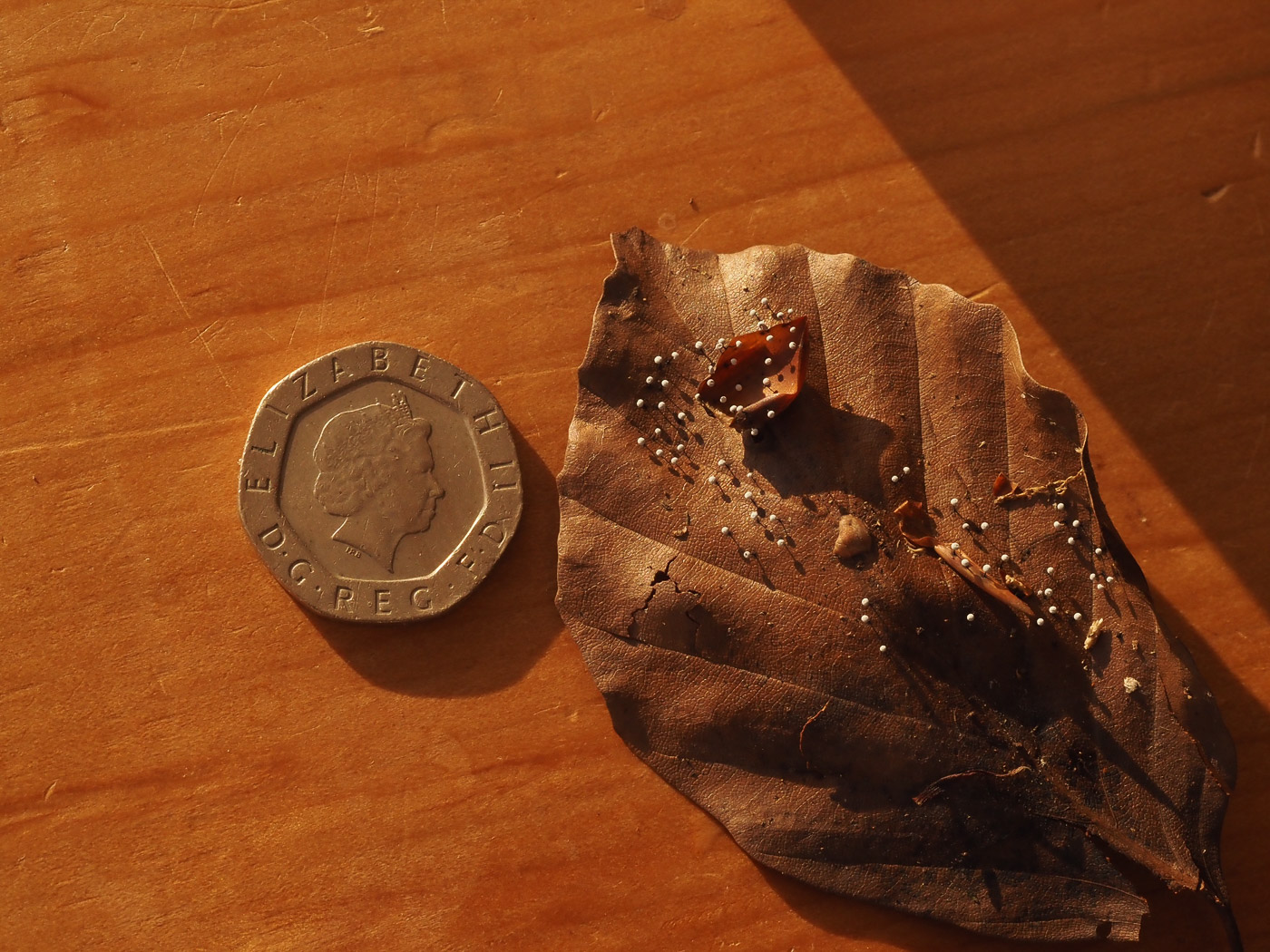 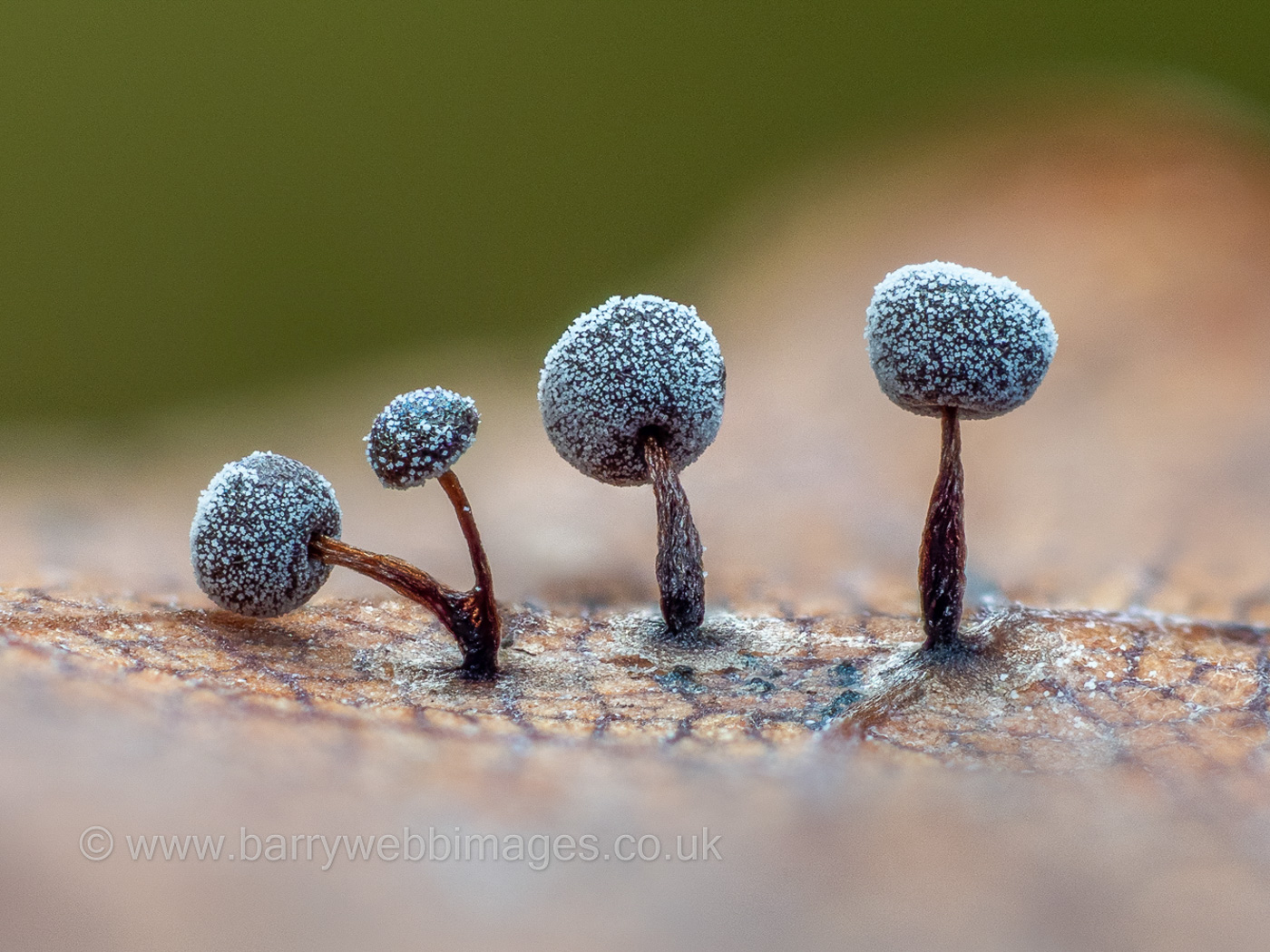
|
Didymium nigripes (a Slime Mould with no common name) Jul 12, 2021. On a dead Beech leaf in Downley Wood Claire Williams spotted this cluster of extremely small organisms (see photo 3 to give an idea of scale). The identification from her excellent photos was given her on the Slime Mould facebook page, the name referring to the particularly dark stalk in this member of a very large and tricky genus. (See another image amongst Barry Webb's photos.) We have just two previous county records - one of these Barry's from last year - but the species is not rare, just tiny and easily overlooked. It seems we have a second outstanding photographer amongst our number! Sep 18, 2020. Barry Webb found this tiny slime mould in deciduous leaf litter in Burnham Beeches where it is new for the site though we have only one previous county record. It is described as quite common across the country though most records seem to be from the south. Didymium is a large genus, many species of which look extremely similar, but the dark stalk base is apparently diagnostic here. |

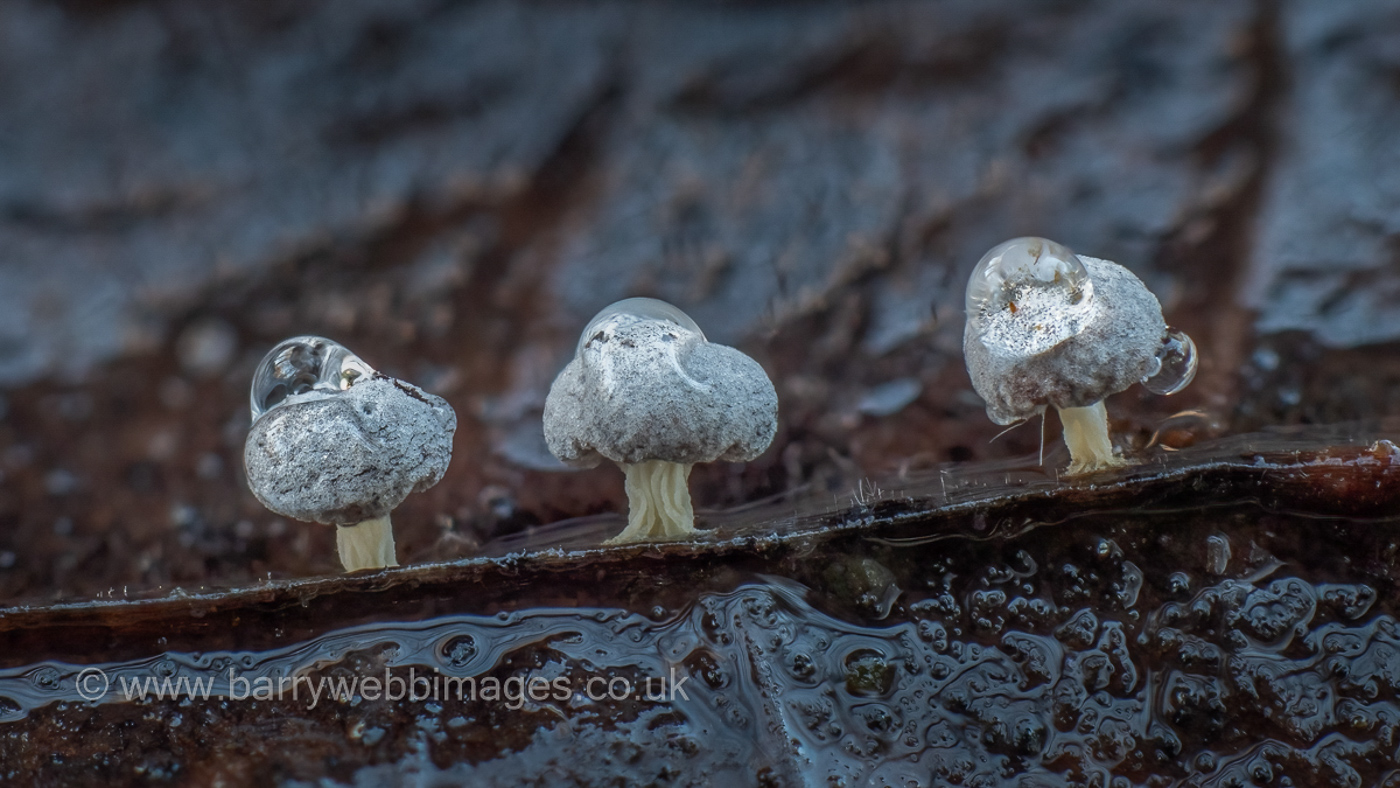
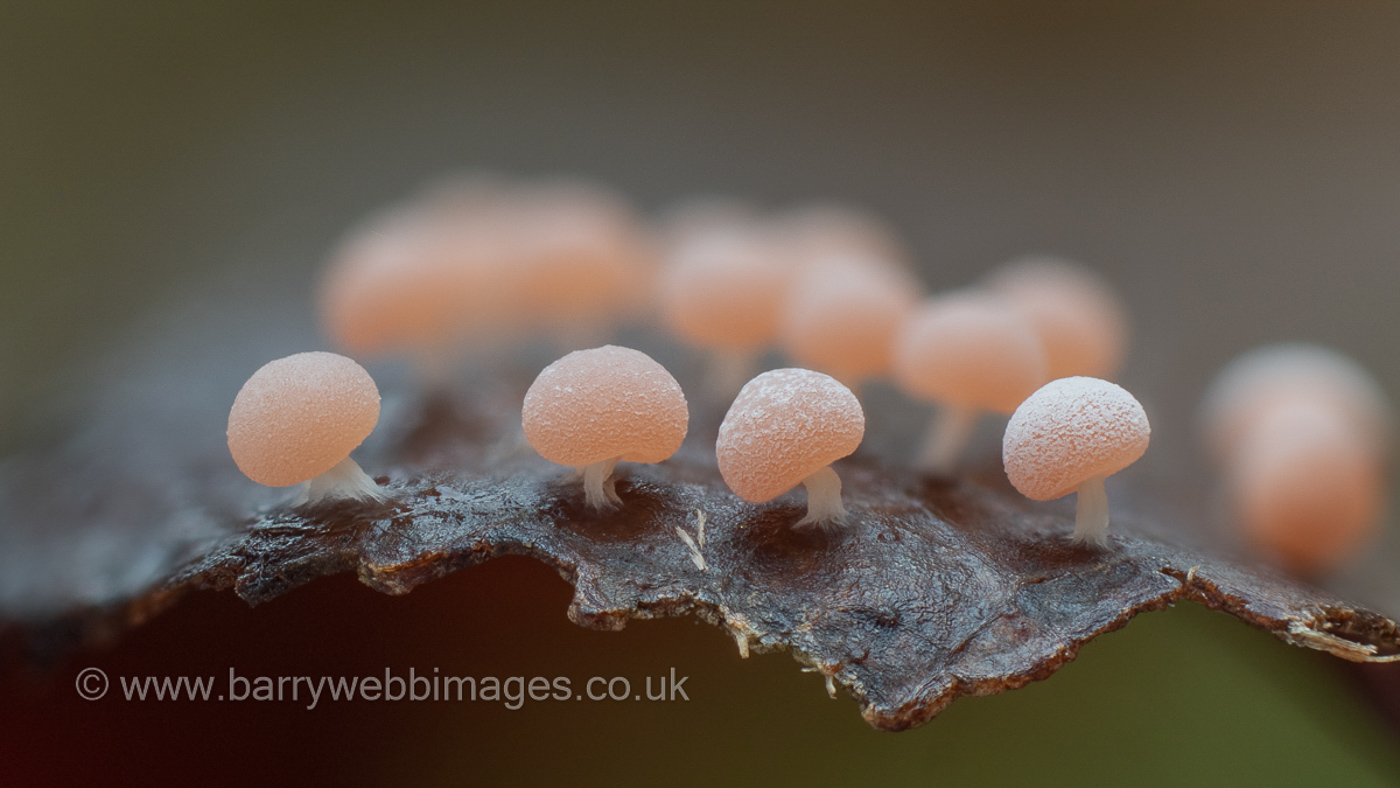
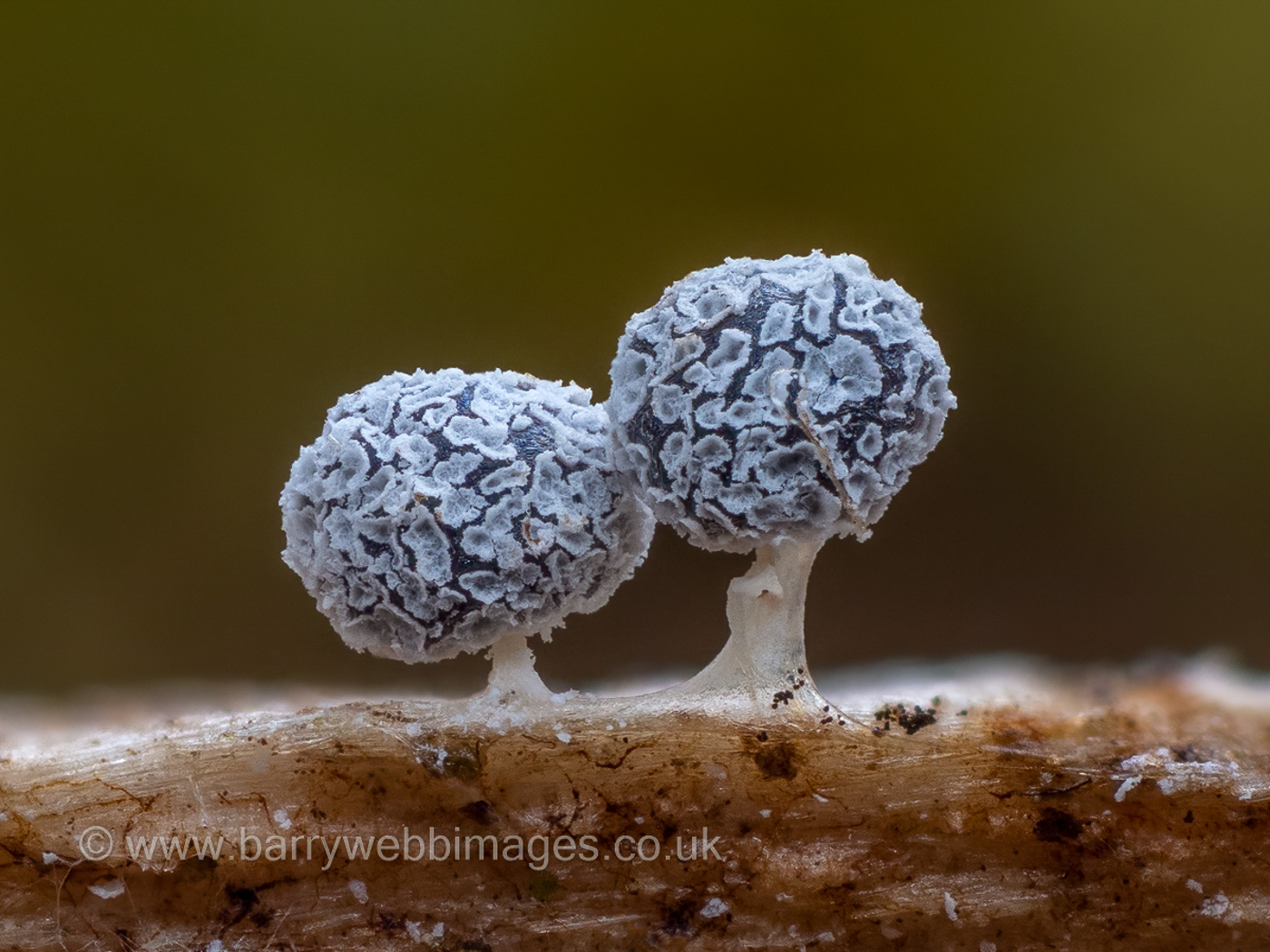
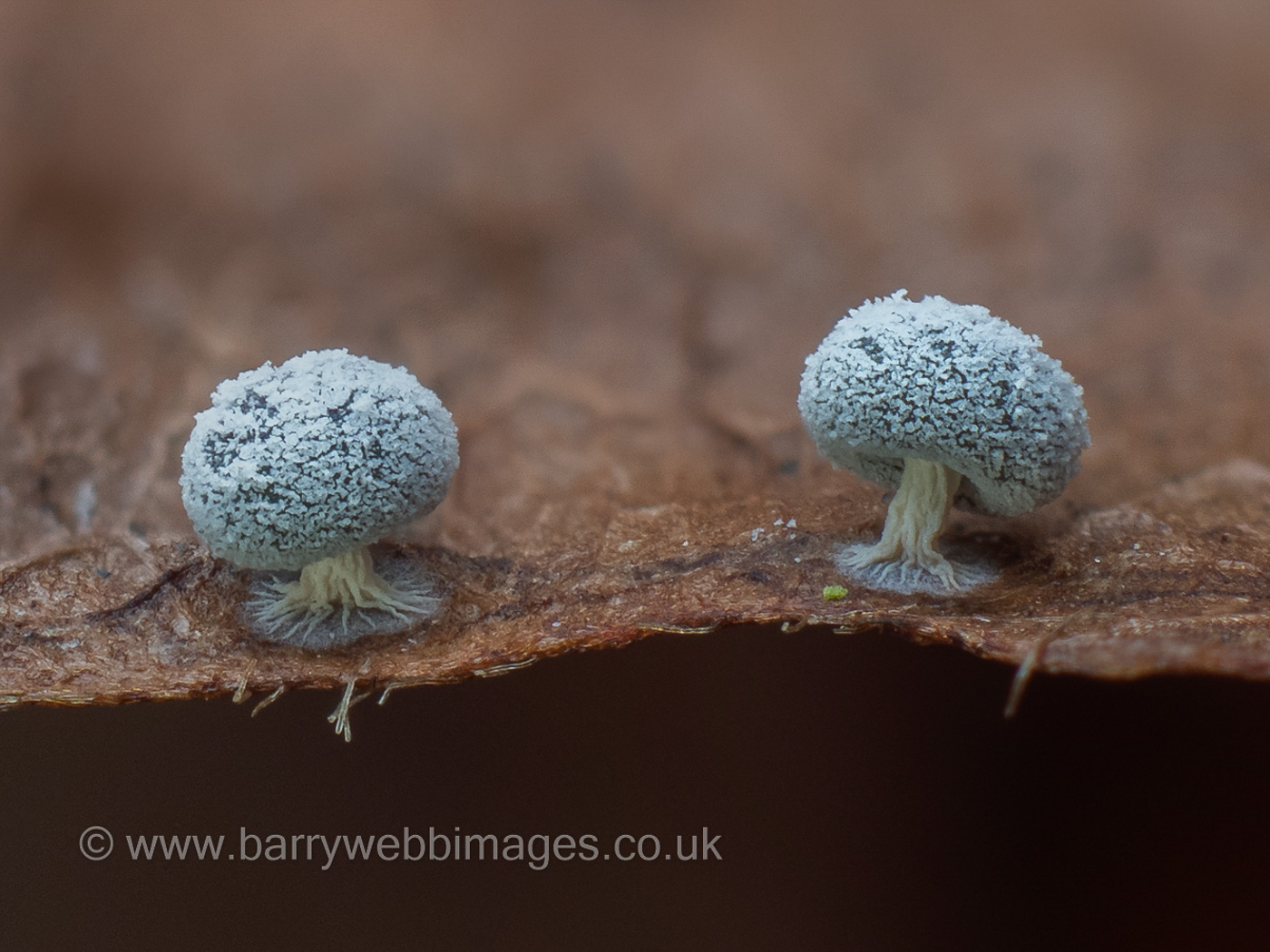
|
Didymium squamulosum (a Slime Mould with no common name) Jan 14, 2024. In Hodgemoor Wood Barry Webb found this attractive squat little cluster under Holly whilst searching for anything tiny and fungal etc lurking there. This is a very common species found in rotting damp leaf litter, typified by its short stout white stalk contrasting with its darker subglobose head. (Note the trail of tiny droplets adhering to the spiders web between the two central fruiting bodies!) Jan 12, 2022. In Naphill Common on the 'Great Beech' Barry found several different 'Myxos' of which this was one of the commoner species though it's new for the site. See Barry's page on Finds for more images and information. Dec 30, 2021. In leaf litter under Holly in Hodgemoor Woods Barry found this immature but beautiful little species. For more notes and images see Barry's separate page in Members' Finds. May 9, 2021. Barry Webb found these tiny little beauties on a woodchip pile in Burnham Beeches. This is one of the commoner species in a genus of around 30 or so, many of which are very similar to today's species. Features to note here are the patches of egg-shell-like crust of calcium carbonate on the surface and the short white stalk. Dec 28, 2020. Barry Webb found this beautiful slime mould in deciduous leaf litter in Burnham Beeches. This is one of the commonest species of Didymium and we have plenty of county records though apparently only one previously for this site back in 1923! Compare with photos of other Didymium species to see the typical features of the genus. |
 
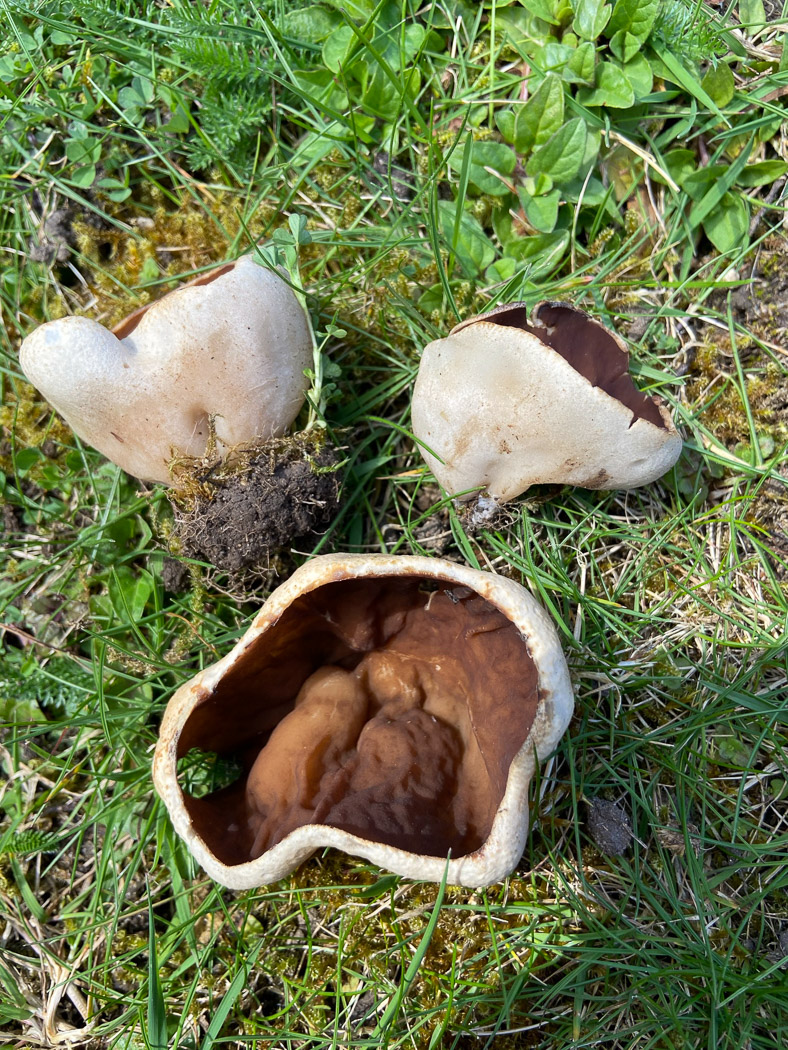 |
Disciotis venosa (Bleach Cup) Mar 17, 2024. In Gerrards Cross Jesper Launder noticed this singleton species fruiting in a hotel car park verge. There are several similar cup fungi which fruit in Spring, usually in April though we do have some early March records for this one which favours grassy banks. Its English name refers to its strong smell - one of the clues which help to confirm its identity. Apr 4, 2023. In Seer Green Jesper Launder spotted this springtime cup - one that appears very similar to a large Peziza but has a distinctive wrinkled inner surface, a short thick stem, very fragile flesh and a marked bleachy smell. It occurs in soil often in lawns at this time. Mar 17, 2022. In her mother's garden in Tylers Green Sarah Ebdon spotted these impressive cups, had no idea what they were, so took them home to work on. As they were clearly not either Peziza or Otidea, she was stumped but had noticed the distinctive pervasive bleachy smell and thought this must be a useful clue. So she googled 'bleach cup fungi' and up came the answer. She then checked that the microscopic features matched, which they did - Bingo! This is an occasional springtime species, occurring in woodland soil and also garden lawns and beds and has a brown furrowed / wrinked inner surface with a paler pruinose outer surface with a small stem, often somewhat buried in the soil. Another quite similar species to look out for now is Paxina acetabulum, another brown Peziza-like cup which occurs in woodland litter in Spring - this one has a smooth inner surface but prominent veins / ribs on the outer surface extending onto its hollow stem. (It is sometimes known as Cabbage Leaf Helvella.) |

